Microsoft RM-2 Nokia 6810 GSM Phone with Bluetooth User Manual rm 2 en1 FCC
Microsoft Mobile Oy Nokia 6810 GSM Phone with Bluetooth rm 2 en1 FCC
Manual
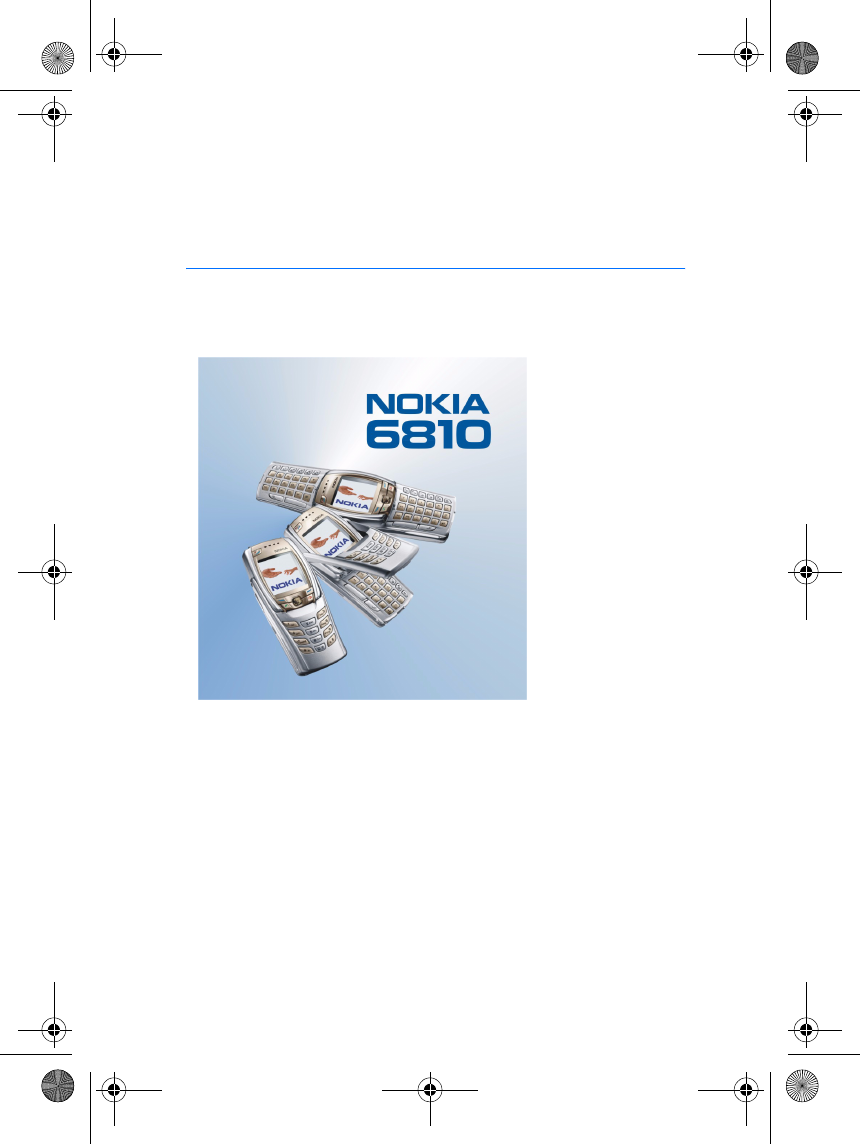
User Guide for Nokia 6810
9311563
Issue 1 DRAFT
rm-2_en1_FCC.fm Page 1 Monday, February 16, 2004 8:14 AM
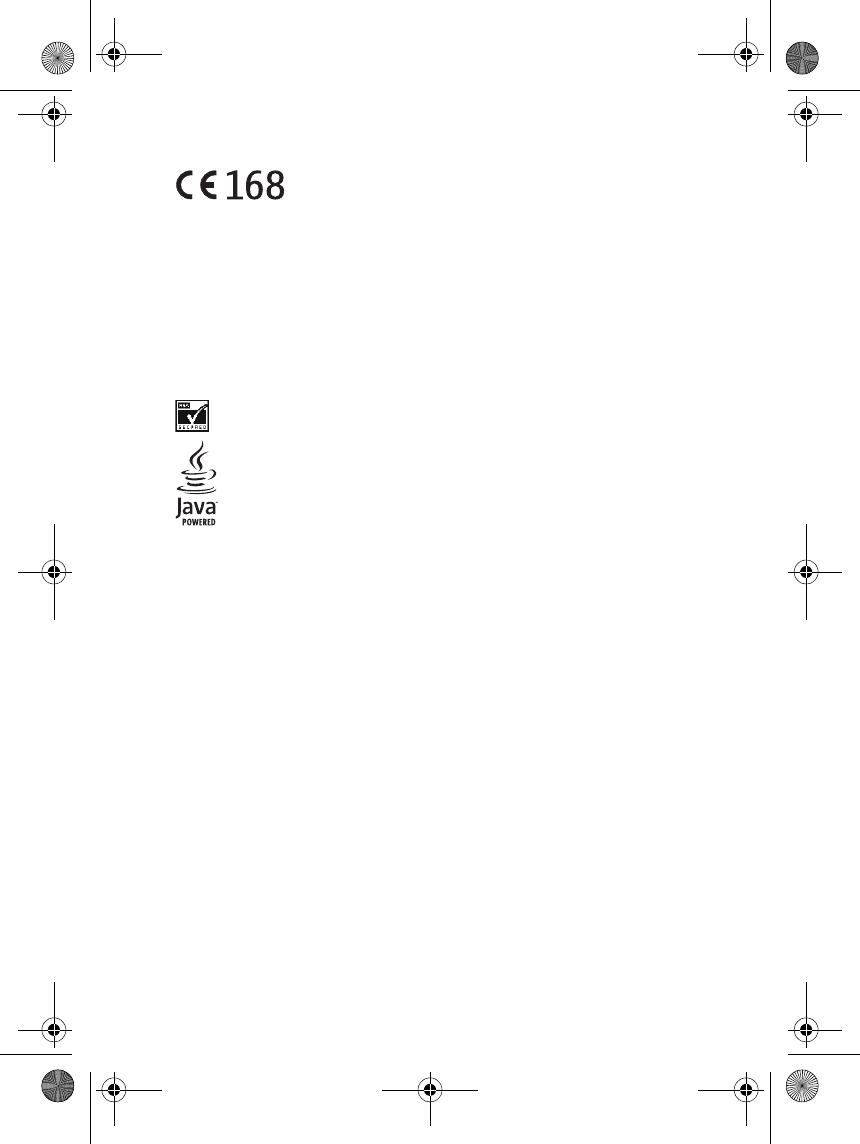
Copyright © 2004 Nokia. All rights reserved.
Reproduction, transfer, distribution or storage of part or all of the contents in this document
in any form without the prior written permission of Nokia is prohibited.
Nokia, Nokia Connecting People and Pop-Port are trademarks or registered trademarks of
Nokia Corporation. Other product and company names mentioned herein may be trademarks
or tradenames of their respective owners.
Nokia tune is a sound mark of Nokia Corporation.
Bluetooth is a registered trademark of Bluetooth SIG, Inc.
US Patent No 5818437 and other pending patents. T9 text input software Copyright (C)
1997-2004. Tegic Communications, Inc. All rights reserved.
Includes RSA BSAFE cryptographic or security protocol software from RSA
Security.
Java is a trademark of Sun Microsystems, Inc.
Nokia operates a policy of continuous development. Nokia reserves the right to make
changes and improvements to any of the products described in this document without prior
notice.
Under no circumstances shall Nokia be responsible for any loss of data or income or any
special, incidental, consequential or indirect damages howsoever caused.
The contents of this document are provided "as is". Except as required by applicable law, no
warranties of any kind, either express or implied, including, but not limited to, the implied
warranties of merchantability and fitness for a particular purpose, are made in relation to the
accuracy, reliability or contents of this document. Nokia reserves the right to revise this
document or withdraw it at any time without prior notice.
Export Controls
This product contains commodities, technology or software exported from the United States
in accordance with the Export Administration regulations. Diversion to U.S. law is prohibited.
FCC Notice - Industry Canada Notice
Your phone may cause TV or radio interference (e.g. when using a telephone in close
proximity to receiving equipment). The FCC/Industry Canada can require you to stop using
your telephone if such interference cannot be eliminated. If you require assistance, contact
your local service facility.This device complies with part 15 of the FCC rules. Operation is
subject to the condition that this device does not cause harmful interference.
The availability of particular products may vary by region. Please check with the Nokia dealer
nearest to you.
9311563/Issue 1 DRAFT
rm-2_en1_FCC.fm Page 2 Monday, February 16, 2004 8:14 AM
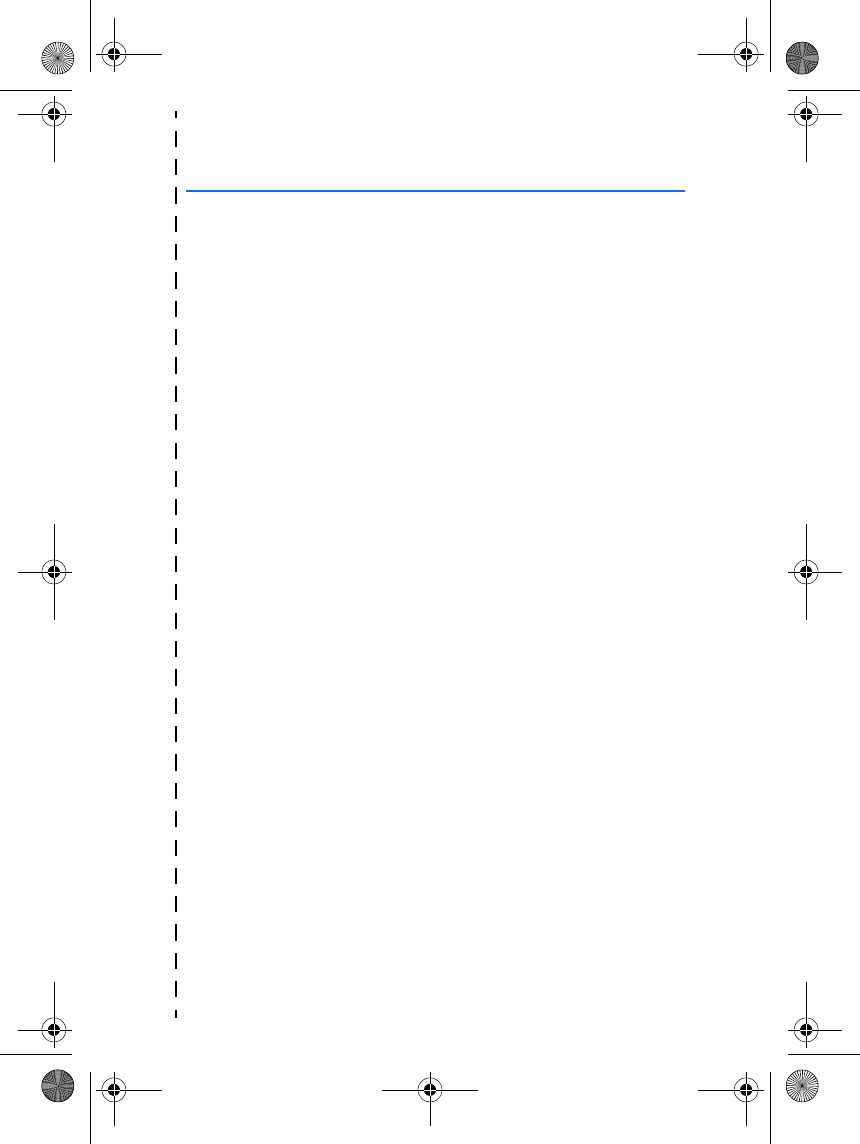
Tips and hints
✁
Tips and hints
Tips and hints for using your new Nokia 6810 phone and for transferring
data from your previous phone to your new phone.
■Transferring data from the previous phone
•If your old phone has no PC Suite support, the only way to transfer
data is via the SIM card.
1. Transfer all the contact information (names and phone numbers)
in the old phone to the SIM card. For more information, refer to
the user guide of the old phone.
2. Remove the SIM card and install it in your Nokia 6810 phone.
3. Press Menu and select Contacts, Copy, From SIM card to phone
and All to copy the contacts to the new phone.
•If your old phone has PC Suite support, you may be able to
transfer data using the Nokia Content Copier feature of PC Suite.
You can copy data directly from the old phone to the new phone. If
you no longer have the old phone, but you have backed it up to a
compatible PC at some stage, you may still be able to transfer the
backup data to your new phone. Note that only the data that was
saved in the old phone when you last backed it up with the PC can be
transferred. For more information, refer to the PC Suite
documentation.
1. Install the PC Suite version delivered with your 6810 phone.
Note: You have to uninstall the old phone’s PC Suite version
before you can install the new version.
2. Start Nokia Content Copier.
3. If you still have the old phone, connect it to the PC and copy the
data from the phone to the PC, if you have not done it recently.
4. Connect your new phone to the PC and copy the old phone’s data
from the PC to the phone.
rm-2_en1_FCC.fm Page 3 Monday, February 16, 2004 8:14 AM
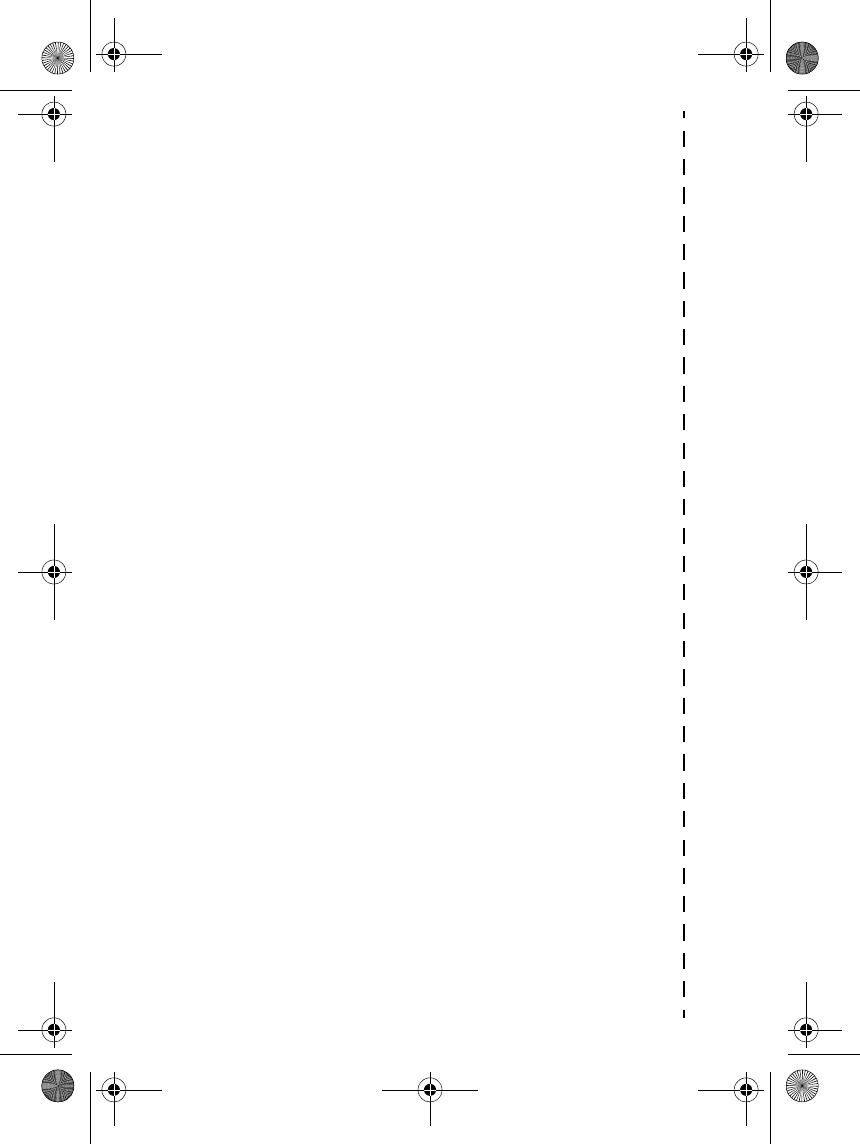
Tips and hints
✁
Note: Even if you no longer have the old phone, the old backup
data is still on your PC and you may be able to transfer it to your
new phone.
With Nokia Content Copier, you can transfer the following data
from the following Nokia phones:
• All stored data from
• Nokia 3100 phone
• Nokia 3200 phone
• Nokia 5100 phone
• Nokia 6100 phone
• Nokia 6220 phone
• Nokia 6230 phone
• Nokia 6310i phone
• Nokia 6510 phone
• Nokia 6610 phone
• Nokia 6650 phone
• Nokia 6800 phone
• Nokia 6820 phone
• Nokia 7200 phone
• Nokia 7210 phone
• Nokia 7250 phone
• Nokia 7250i phone
• Nokia 7600 phone
• Nokia 8310 phone
• Nokia 8910 phone
• Nokia 8910i phone
•Contacts and items in the Calendar from the Nokia 6210,
6250 and 7110 phones
•Only Contacts from the Nokia 5210, 8210 and 8850 phones
rm-2_en1_FCC.fm Page 4 Monday, February 16, 2004 8:14 AM
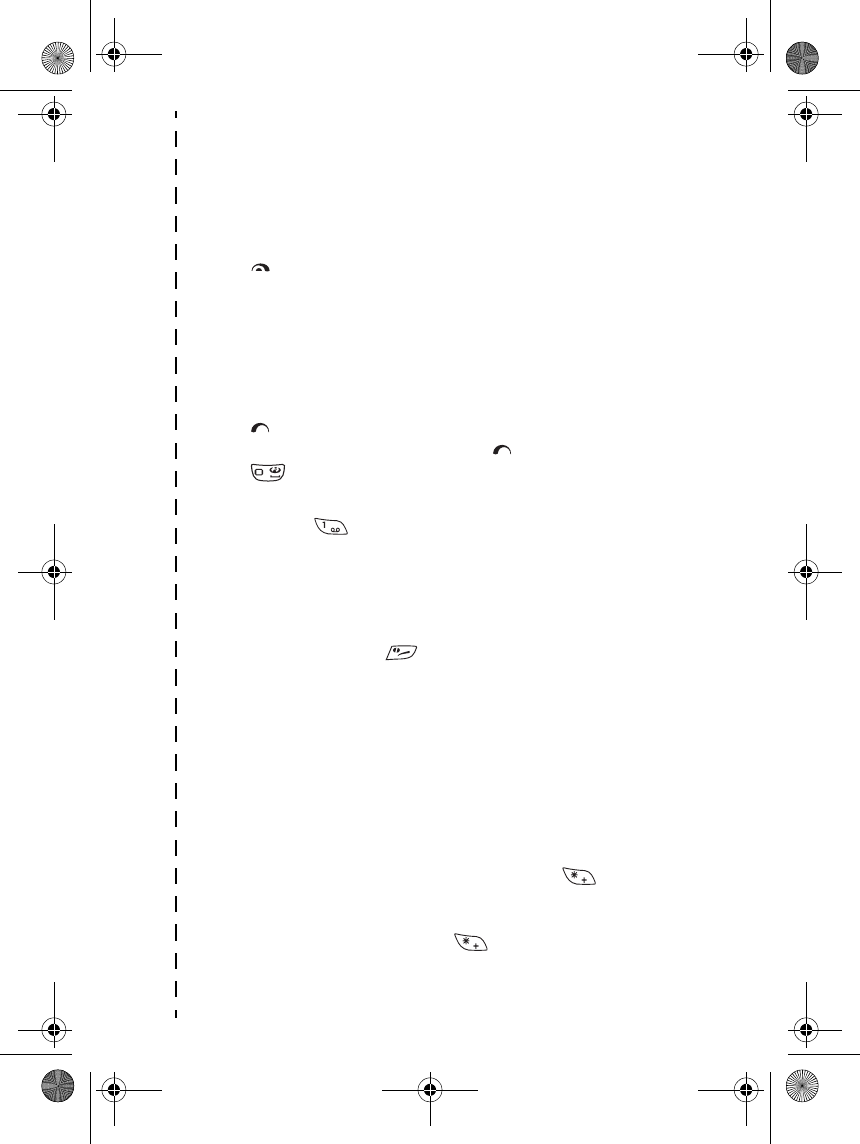
Tips and hints
✁
Note that you cannot back up the e-mail settings of the phone
and thus cannot transfer them from your old phone.
■Returning to standby mode
• Press to return to standby mode from anywhere in the menu.
■Using the phone in standby mode
• Move the joystick to the left to start writing a message.
• Move the joystick to the right to view the current Calendar month.
• Move the joystick up or down to access the list of contacts.
• Press to access the list of upto 20 last numbers you have called.
Select the number you require and press again to make a call.
• Press to open a connection to a browser service (network
service).
• Press and hold to call your voice mailbox (network service).
Note that the speed dialling function must be set on. Press Menu,
and select Settings, More settings,Call settings and Speed dialling.
• Key in the phone number and press Save to save a new contact. Then
key in the name, press OK and Done.
• Change the profile: press , scroll to the profile that you want to
activate and press Select.
■Using the security keyguard
• The security keyguard locks the keypad of the phone with a security
code, see Security code (5 to 10 digits) on page 13. The keypad lock
remains active, if you open the flip. Press Menu and select Settings,
More settings, Phone settings and Security keyguard.
Enter the security code. To set the security keyguard, select On.
To activate the security keyguard, press Menu and within 1.5
seconds, when the flip is closed. To deactivate the keyguard when
the flip is open, press Unlock and OK, then key in the security code. If
the flip is closed, press Unlock and within 1.5 seconds, then
key in the security code.
rm-2_en1_FCC.fm Page 5 Monday, February 16, 2004 8:14 AM

Tips and hints
✁
■Turning on the phone lights
• When the keypad is locked, press the power key ( ) to turn on the
keypad and display lights.
• When the flip is open, press the keyboard light key ( ) to turn on
and off the keyboard lights.
■Using the e-mail application
• To use your phone’s e-mail application, you have to configure the e-
mail and connection settings. For more information, see Settings for
the e-mail application on page 64, or the Guide for e-mail
application settings leaflet in the phone’s sales package.
To set up the e-mail service with your operator, refer to
www.nokia.com/phonesettings.
■Setting up a Bluetooth connection
1. Press Menu, and select Settings, Connectivity and Bluetooth.
2. To activate the Bluetooth connection, select Bluetooth and On.
3. Select Search for audio enhancements to search for compatible
devices and select the device that you want to connect to the phone.
4. Enter the passcode of the selected device.
■Writing text
• To set the predictive text input on or off, press twice, or press
and hold Options.
• To insert a special character when using traditional text input, press
or when using predictive text input, press and hold .
Move the cursor with the joystick to a character and press Use.
• To change the font size of the SMS messages, press Menu and select
Messages, Message settings, Other settings, and Font size.
rm-2_en1_FCC.fm Page 6 Monday, February 16, 2004 8:14 AM
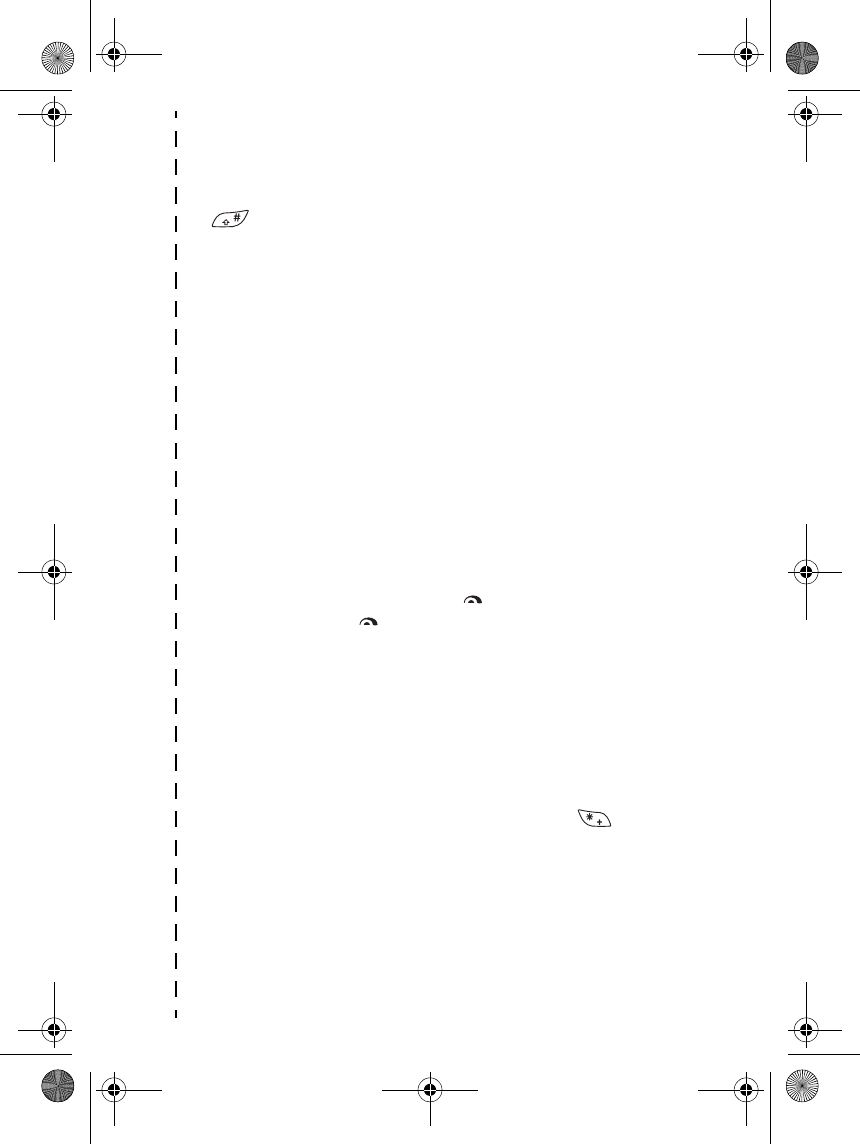
Tips and hints
✁
■Viewing contacts
• To view a contact name with the default number, press and hold
at the name while scrolling through Contacts.
■Viewing the calendar and calendar notes
• To quickly view the current Calendar month, move the joystick to the
right in standby mode.
• When viewing the calendar notes, move the joystick to the right to
scroll through the notes.
■Customising personal shortcuts
•Press Go to and select Select options to select the functions you
want as shortcuts.
•Press Go to and select Organise to rearrange the functions within
the shortcut list.
■Using the radio
• Return to standby mode by pressing briefly; turn off the radio by
pressing and holding .
• The lead of the headset functions as the radio antenna, so let it hang
freely.
• Save the channel in locations 1 to 9 by pressing and holding the
corresponding number key, then keying in the name of the channel
and pressing OK.
■Using the calculator
• When using the calculator with the flip closed, press once to
add, twice to subtract, three times to multiply or four times to divide.
rm-2_en1_FCC.fm Page 7 Monday, February 16, 2004 8:14 AM
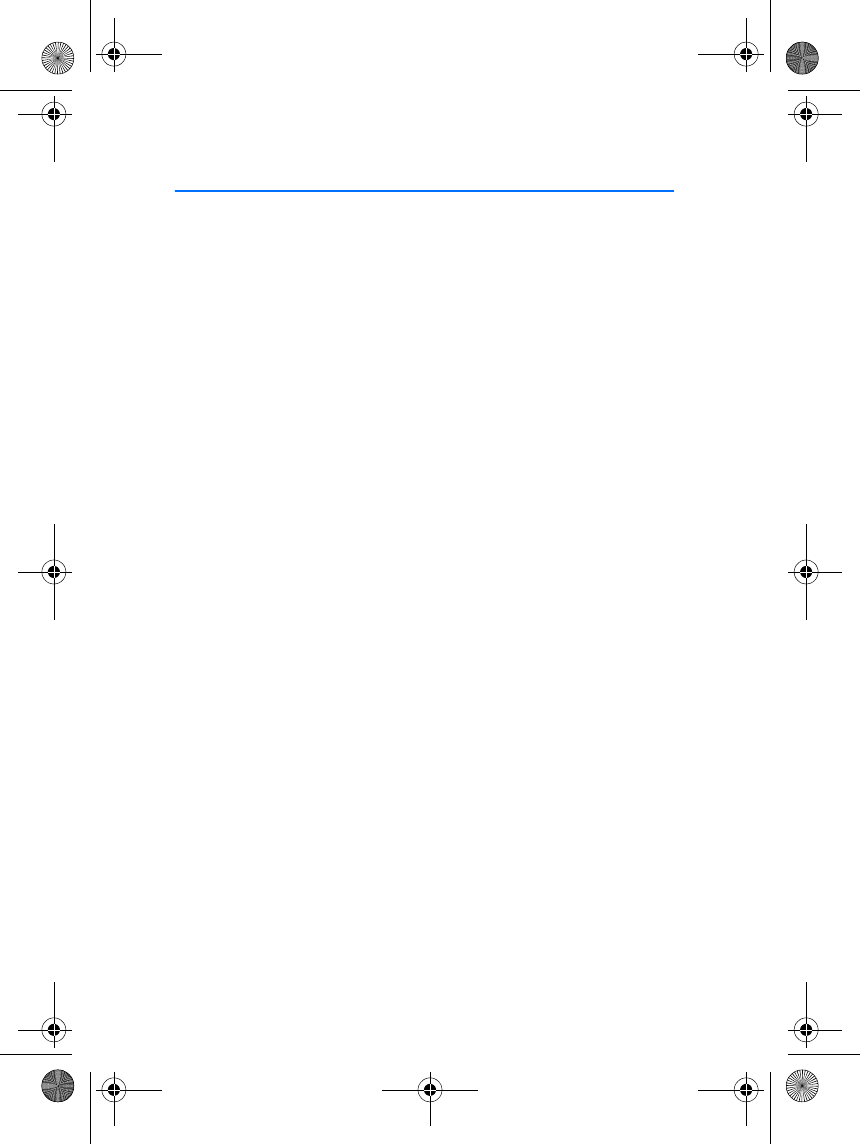
8
Contents
FOR YOUR SAFETY................. 10
General information.............. 13
Access codes......................................... 13
Security code (5 to 10 digits)....... 13
PIN and PIN2 codes (4 to 8 digits),
Module PIN and Signing PIN........ 13
PUK and PUK2 codes (8 digits) .... 14
Barring password (4 digits)........... 14
Wallet code (4 to 10 digits).......... 14
Overview of the phone functions... 14
Shared memory ................................ 15
1. Getting started .................. 16
Installing the SIM card and
the battery ............................................ 16
Charging the battery.......................... 18
Switching the phone on and off..... 18
Opening the flip............................... 19
Switching the keyboard lights
on or off ............................................. 20
2. Your phone......................... 21
Keys (flip closed) ................................. 21
Connectors............................................ 22
Headset.................................................. 22
Keys (flip open).................................... 23
Standby mode ...................................... 24
Screen saver...................................... 26
Wallpaper........................................... 26
Essential indicators
in standby mode .............................. 26
Keypad lock (Keyguard)..................... 28
Over-the-air settings service........... 28
3. Call functions..................... 30
Making a call........................................ 30
Speed dialling a phone number... 31
Answering or rejecting an incoming
call........................................................... 32
Call waiting....................................... 32
Options during a call.......................... 32
4. Writing text........................ 34
Writing text using the messaging
keyboard ................................................ 34
Typing accented characters.......... 35
Writing text when the flip is closed 35
Setting predictive text input
on or off ............................................. 35
Using predictive text input........... 35
Using traditional text input.......... 36
Tips for writing text........................ 37
5. Using the menu.................. 39
Accessing a menu function.............. 39
List of menu functions ...................... 40
6. Menu functions.................. 42
Messages (Menu 1) ............................ 42
Text messages (SMS)...................... 42
Archive folder and my folders...... 45
Templates........................................... 45
Distribution lists .............................. 46
Text message counter .................... 47
Multimedia messages..................... 47
Deleting messages........................... 51
E-mail application........................... 52
Chat..................................................... 55
Voice messages ................................ 61
Info messages................................... 62
Message settings............................. 62
Settings for the e-mail
application......................................... 64
Font size setting .............................. 67
Service commands .......................... 68
Call register (Menu 2)........................ 68
Recent calls lists .............................. 68
Timers and counters ....................... 69
Contacts (Menu 3).............................. 69
Selecting settings for contacts.... 70
rm-2_en1_FCC.fm Page 8 Monday, February 16, 2004 8:14 AM
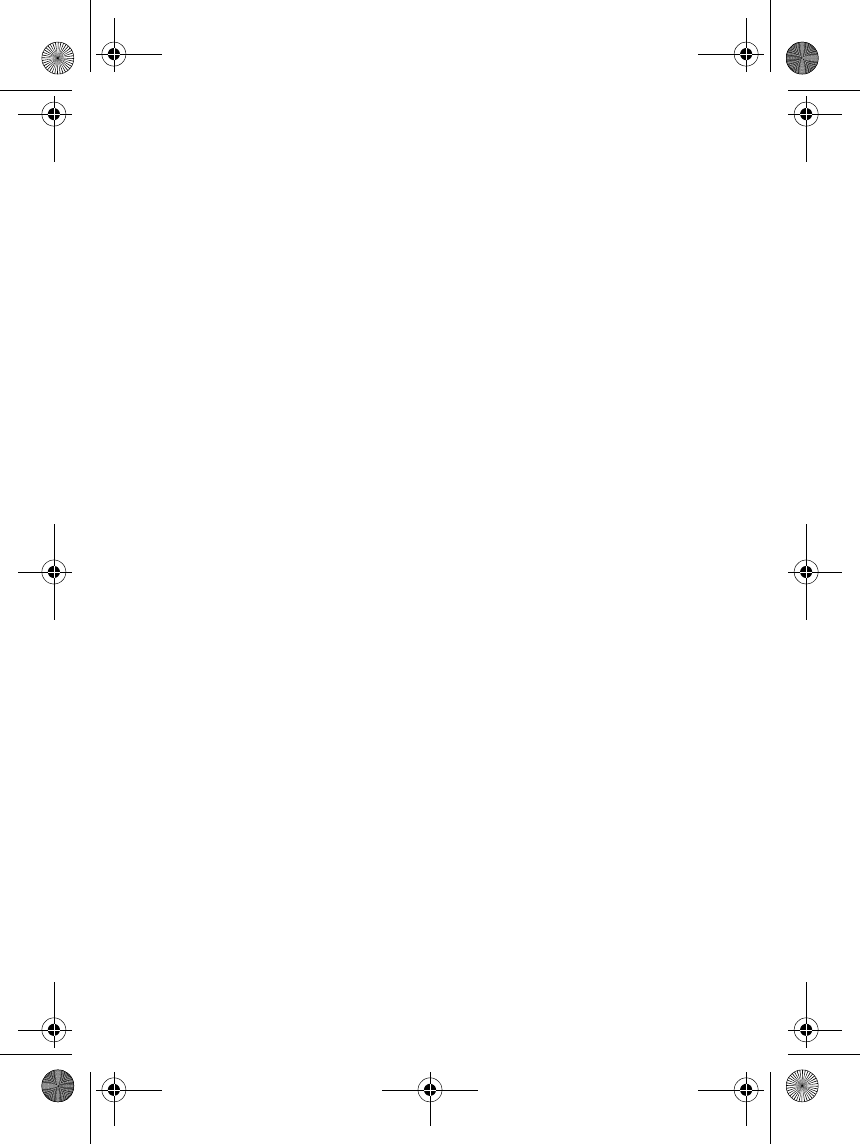
9
Saving names and phone numbers
(Add contact)..................................... 70
Adding an image to a name or
number in contacts ......................... 71
Searching for a contact.................. 72
Deleting contacts............................. 72
Editing or deleting details
in contacts ......................................... 73
My presence ...................................... 73
Subscribed contacts ........................ 75
Copying contacts ............................. 77
Sending and receiving a business
card ...................................................... 77
Speed dials......................................... 77
Voice dialling..................................... 78
Info numbers and service
numbers.............................................. 79
My numbers....................................... 79
Caller groups ..................................... 79
Settings (Menu 4)................................ 80
Profiles ................................................ 80
Chat and my presence settings.... 81
Tone settings ..................................... 81
Display settings ................................ 82
Time and date settings ................... 83
Personal shortcuts ........................... 84
Connectivity....................................... 84
More settings .................................... 89
Security settings............................... 92
Restore factory settings ................. 93
Gallery (Menu 5).................................. 94
Radio (Menu 6) .................................... 96
Tuning a radio channel................... 96
Using the radio ................................. 97
Organiser (Menu 7)............................. 98
Alarm clock ........................................ 98
Calendar.............................................. 99
To-do list ......................................... 100
Notes ................................................ 101
Wallet............................................... 102
Synchronisation............................. 105
Applications (Menu 8)..................... 107
Games............................................... 108
Collection ........................................ 108
Extras................................................ 110
Services (Menu 9)............................. 113
Basic steps for accessing and
using services................................. 113
Setting up the phone for
a service........................................... 113
Connecting to a service .............. 114
Browsing the pages of a service 115
Disconnecting from a service .... 116
Appearance settings of
the multi-mode browser............. 116
Cookies............................................. 117
Bookmarks....................................... 117
Downloading .................................. 118
Service inbox.................................. 118
Cache memory ............................... 119
Browser security............................ 119
SIM services (Menu 10).................. 122
7. PC Connectivity ............... 123
PC Suite............................................... 123
EGPRS, HSCSD and CSD .............. 124
Using data communications
applications........................................ 124
8. Battery information ........ 125
Charging and Discharging.............. 125
CARE AND MAINTENANCE. 126
IMPORTANT SAFETY
INFORMATION..................... 127
rm-2_en1_FCC.fm Page 9 Monday, February 16, 2004 8:14 AM
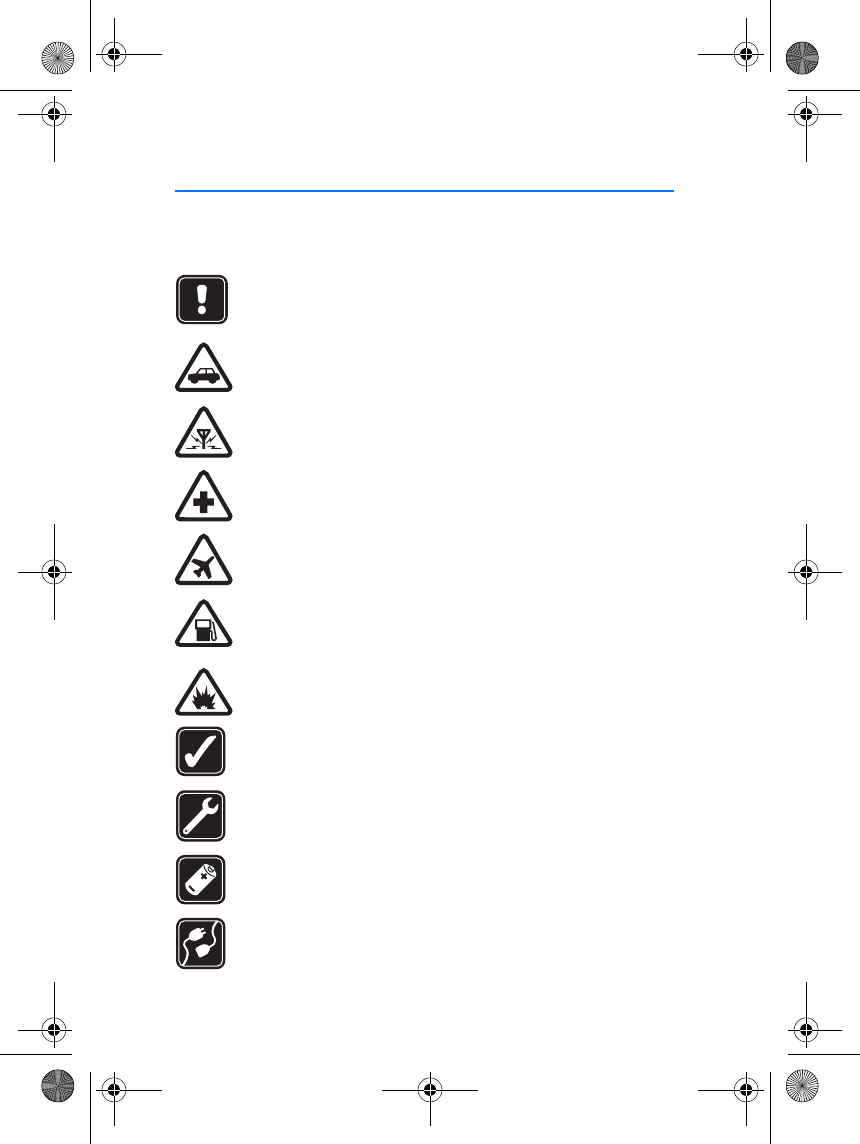
FOR YOUR SAFETY
10
FOR YOUR SAFETY
Read these simple guidelines. Breaking the rules may be dangerous or illegal.
Further detailed information is given in this manual.
Do not switch the phone on when wireless phone use is prohibited or
when it may cause interference or danger.
ROAD SAFETY COMES FIRST
Don't use a hand-held phone while driving.
INTERFERENCE
All wireless phones may get interference, which could affect
performance.
SWITCH OFF IN HOSPITALS
Follow any regulations or rules. Switch the phone off near medical
equipment.
SWITCH OFF IN AIRCRAFT
Wireless devices can cause interference in aircraft.
SWITCH OFF WHEN REFUELLING
Don't use the phone at a refuelling point. Don't use near fuel or
chemicals.
SWITCH OFF NEAR BLASTING
Don't use the phone where blasting is in progress. Observe
restrictions, and follow any regulations or rules.
USE SENSIBLY
Use only in the normal position. Don't touch the antenna
unnecessarily.
QUALIFIED SERVICE
Only qualified personnel may install or repair phone equipment.
ACCESSORIES AND BATTERIES
Use only approved accessories and batteries. Do not connect
incompatible products.
CONNECTING TO OTHER DEVICES
When connecting to any other device, read its user's guide for
detailed safety instructions. Do not connect incompatible products.
rm-2_en1_FCC.fm Page 10 Monday, February 16, 2004 8:14 AM
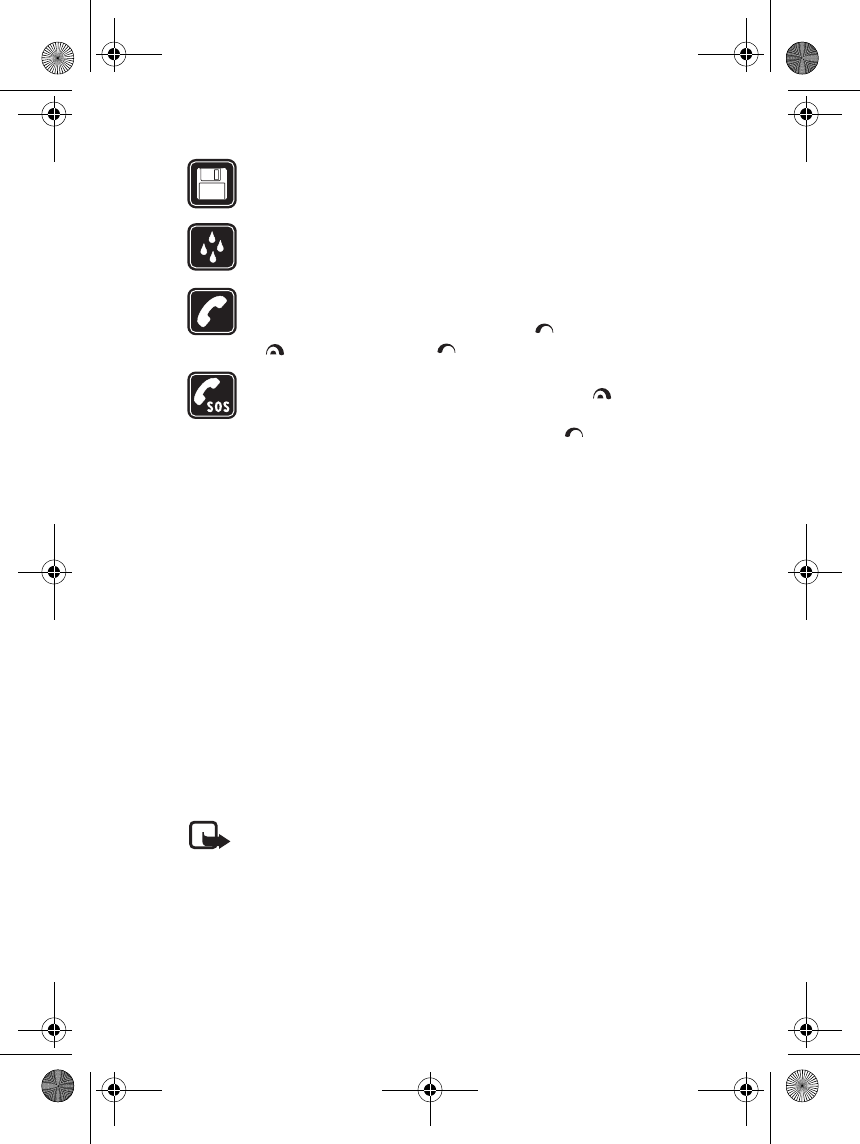
FOR YOUR SAFETY
11
BACKUP COPIES
Remember to make backup copies of all important data
.
WATER-RESISTANCE
Your phone is not water-resistant. Keep it dry.
CALLING
Ensure the phone is switched on and in service. Enter the phone
number, including the area code, then press To end a call, press
. To answer a call, press .
EMERGENCY CALLS
Ensure the phone is switched on and in service. Press as many
times as needed (e.g. to exit a call, to exit a menu, etc.) to clear the
display. Enter the emergency number, then press . Give your
location. Do not end the call until told to do so.
■Network Services
The wireless phone described in this guide is approved for use on the EGSM 900,
GSM1800 and GSM 1900 networks.
Triband is a network dependent feature. Check with your local service provider if
you can subscribe to and use this feature.
This phone supports WAP 2.0 protocols (HTTP and SSL) that run on TCP/IP
protocols. Some features of this phone, such as MMS, browsing, e-mail, chat,
presence-enhanced contacts, remote OMA Data Syncronization, and content
downloading via browser or over MMS, require network support for these
technologies.
A number of features included in this guide are called Network Services. These
are special services that you arrange through your wireless service provider.
Before you can take advantage of any of these Network Services, you must
subscribe to them through your service provider and obtain instructions for their
use from your service provider.
Note: Some networks may not support all language-dependent
characters and/or services.
■About enhancements
Check the model number of any charger before use with this device. This device is
intended for use when supplied with power from ACP-7, ACP-8, ACP-9, ACP-12,
LCH-8, LCH-9, LCH-12 and AC-1.
rm-2_en1_FCC.fm Page 11 Monday, February 16, 2004 8:14 AM
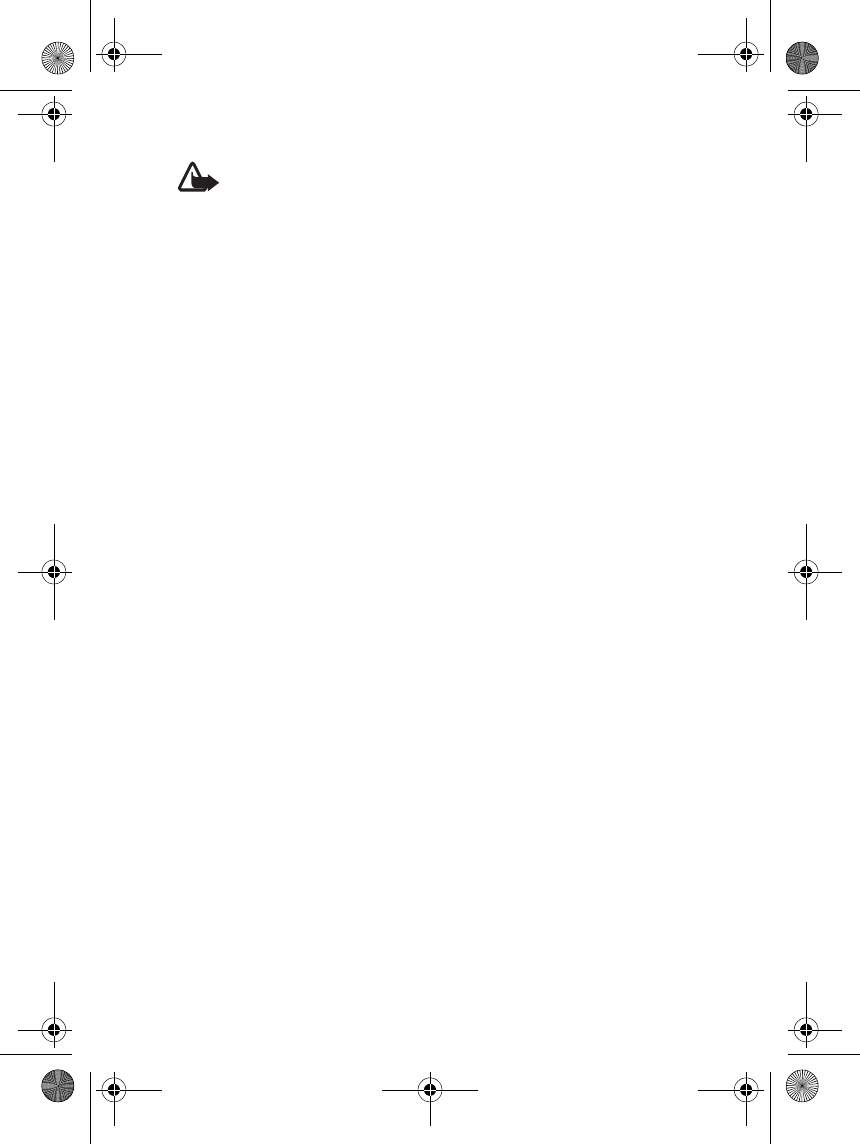
FOR YOUR SAFETY
12
Warning: Use only batteries, chargers and accessories approved by the
phone manufacturer for use with this particular phone model. The use
of any other types may invalidate any approval or warranty applying to
the phone, and may be dangerous.
For availability of approved accessories, please check with your dealer.
A few practical rules for enhancements operation
• Keep all accessories out of the reach of small children.
• When you disconnect the power cord of any accessory, grasp and pull the
plug, not the cord.
• Check regularly that any vehicle-installed accessories are mounted and are
operating properly.
• Installation of any complex car accessories must be made by qualified
personnel only.
rm-2_en1_FCC.fm Page 12 Monday, February 16, 2004 8:14 AM
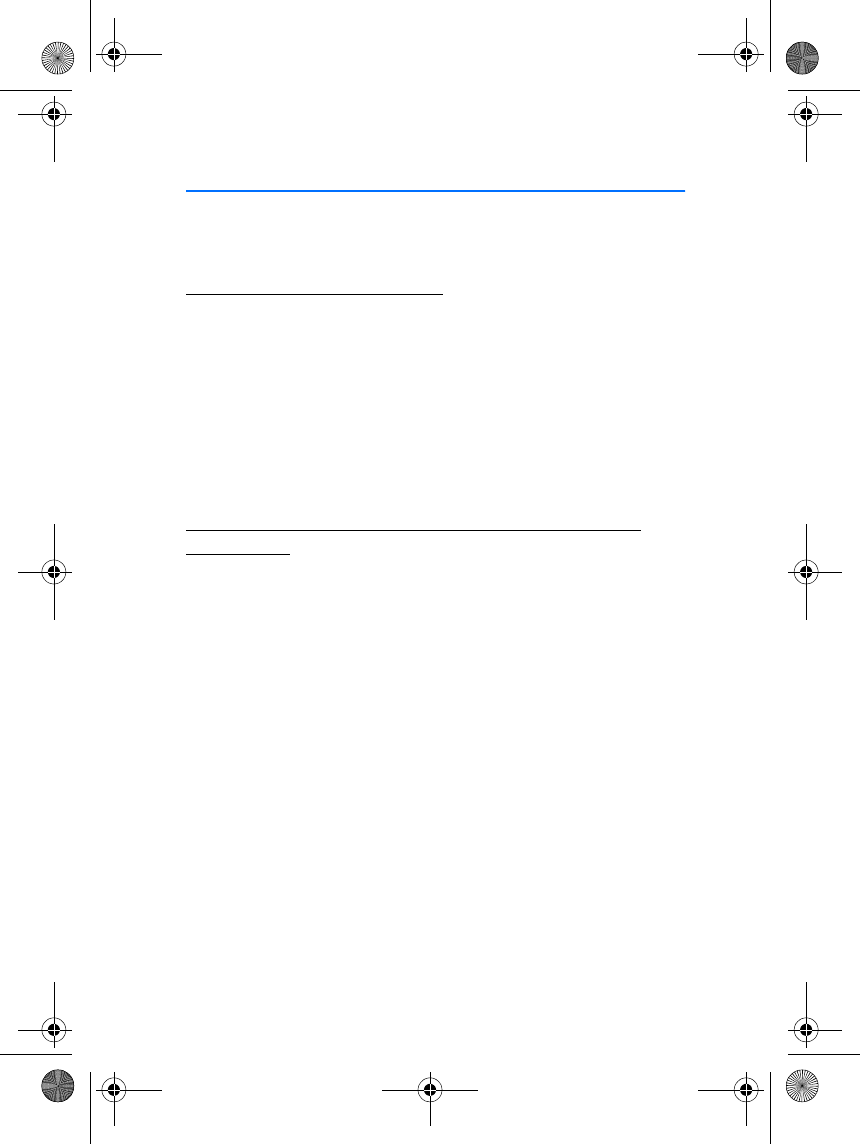
General information
13
General information
■Access codes
Security code (5 to 10 digits)
The security code helps to protect your phone against unauthorised use.
The preset code is 12345. When you have changed the code, keep the
new code secret and in a safe place separate from your phone. To
change the code, and to set the phone to request it, see Security settings
on page 92.
If you key in an incorrect security code five times in succession, the
phone may display Code error. Wait for five minutes and key in the code
again.
PIN and PIN2 codes (4 to 8 digits), Module PIN and
Signing PIN
• The PIN (Personal Identification Number) code protects your SIM
card against unauthorised use. The PIN code is usually supplied with
the SIM card. Set the phone to request the PIN code each time the
phone is switched on, see Security settings on page 92.
• The PIN2 code may be supplied with the SIM card and is required to
access some functions.
• The module PIN is required to access the information in the security
module. See Security module on page 119. The module PIN is
supplied with the SIM card if the SIM card has a security module in
it.
• The signing PIN is required for the digital signature. See Digital
signature on page 121. The signing PIN is supplied with the SIM card
if the SIM card has a security module in it.
If you key in an incorrect PIN code three times in succession, the phone
may display PIN blocked or PIN code blocked and ask you to key in the
PUK code.
rm-2_en1_FCC.fm Page 13 Monday, February 16, 2004 8:14 AM
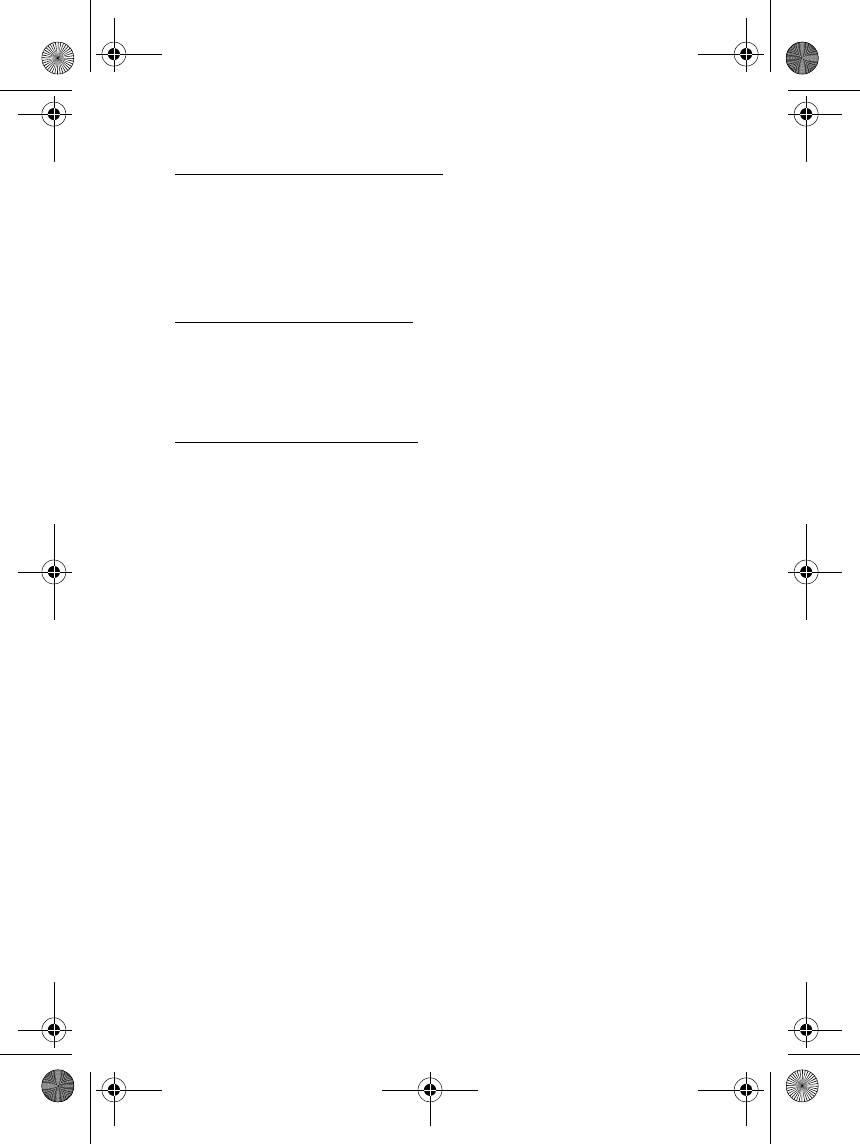
General information
14
PUK and PUK2 codes (8 digits)
The PUK (Personal Unblocking Key) code is required to change a blocked
PIN code. The PUK2 code is required to change a blocked PIN2 code.
If the codes are not supplied with the SIM card, contact your network
operator or service provider.
Barring password (4 digits)
The barring password is required when using the Call barring service, see
Security settings on page 92. You can obtain the password from your
service provider.
Wallet code (4 to 10 digits)
The wallet code is required to access the wallet services. If you key in an
incorrect wallet code several times, the wallet application is blocked for
five minutes. For further information, see Wallet on page 102.
■Overview of the phone functions
Your Nokia 6810 phone is approved for use on EGSM 900,GSM 1800 and
GSM 1900 networks. It provides many functions that are practical for
daily use, such as calendar, radio, loudspeaker, clock and alarm clock.
Your phone also supports the following functions (many of which are
network services):
• EDGE (Enhanced Data rates for GSM Evolution), see EGPRS on page
87. EDGE packet transmission networks enable faster connection
than GPRS.
• The xHTML browser, which allows you to retrieve and view colourful
and rich graphical content from service providers’ web servers. See
Services (Menu 9) on page 113.
• Presence-enhanced contacts, which allow you to conveniently share
your availability information with your colleagues, family and friends
with compatible devices and services. See My presence on page 73.
• Chat, which is a way of sending short text messages that are
delivered to online users. See Chat on page 55.
rm-2_en1_FCC.fm Page 14 Monday, February 16, 2004 8:14 AM
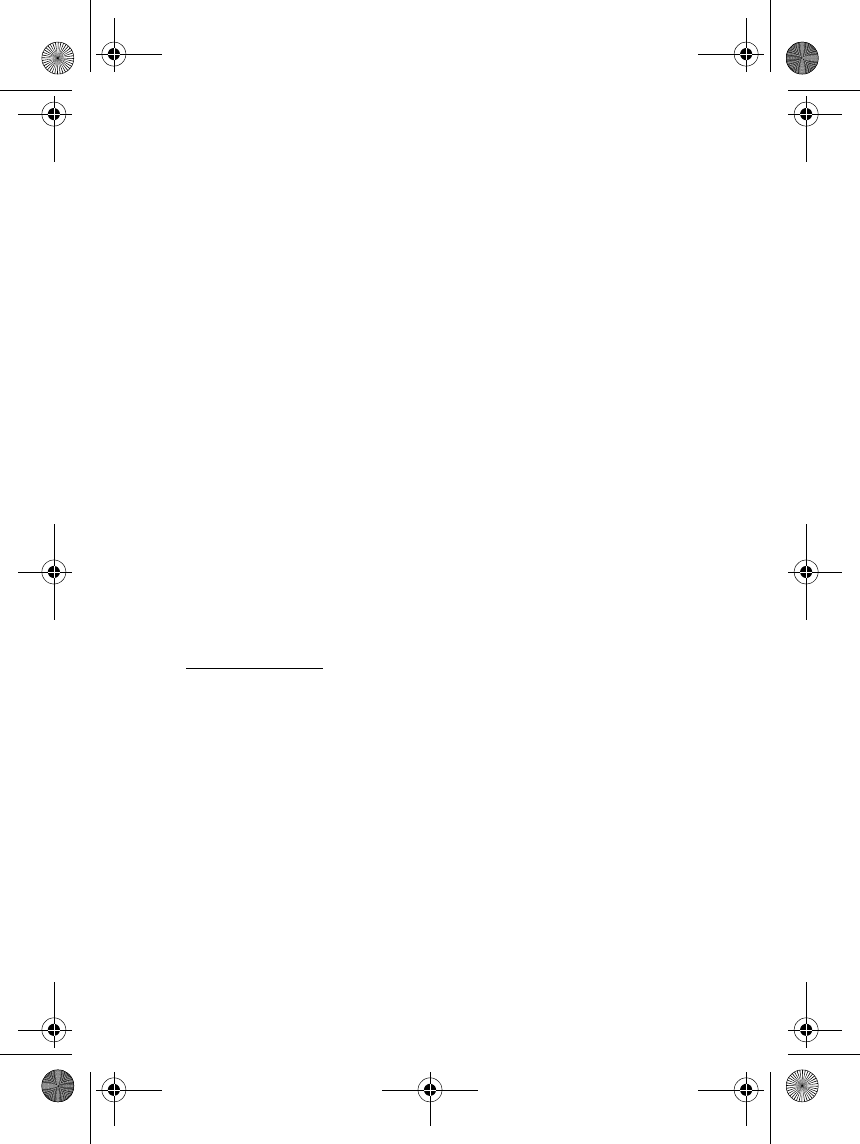
General information
15
• The messaging keyboard for writing text comfortably, see Writing
and sending messages on page 42.
• The e-mail function, which allows you to write, send and retrieve e-
mails from your e-mail account. See E-mail application on page 52.
• The multimedia messaging service (MMS), which allows you to send
and receive multimedia messages that contain text, picture, sound or
video clips to and from compatible devices. You can save the pictures
and ringing tones for personalising your phone, see Multimedia
messages on page 47.
• Polyphonic sound (MIDI), which consists of several sound
components that are played at the same time. The phone has sound
components from over 40 instruments and it can play up to 16
instruments at the same time. The phone supports Scalable
Polyphonic MIDI (SP-MIDI) format.
• Java 2 Micro Edition, J2METM includes some JavaTM applications and
games that have been specially designed for mobile phones. You can
download new applications and games to your phone, see
Applications (Menu 8) on page 107.
• An integrated stereo radio. You can listen to the radio using a
headset or via the loudspeaker, see Radio (Menu 6) on page 96.
Shared memory
The following features in this phone may share memory: contacts, text,
chat and multimedia messages, the e-mail application, voice tags and
SMS distribution lists, images, ringing tones, video and sound clips in
the gallery, calendar, to-do notes, Java games, applications, and the
note application. Using any oif these features may reduce the memory
available for applications that require shared memory. This is especially
true with heavy use of any of the features (although some of them may
have a certain amount of memory specially allotted to them in addition
to the amount of memory shared with other features). For example,
saving many images, Java applications, etc. may take all of the shared
memory and your phone may display a message that the memory is full.
In this case, delete some of the information or entries stored in the
shared memory features before continuing.
rm-2_en1_FCC.fm Page 15 Monday, February 16, 2004 8:14 AM

Getting started
16
1. Getting started
■Installing the SIM card and the battery
• Keep all miniature SIM cards out of the reach of small children.
• The SIM card and its contacts can easily be damaged by scratches or
bending, so be careful when handling, inserting or removing the
card.
• Before installing the SIM card, always make sure that the phone is
switched off and disconnected from any enhancement and then
remove the battery.
1. With the back of the phone facing
you, push the back cover release
button (1) and, at the same time,
slide the back cover off the phone.
If the battery is in place, remove it
by lifting it up.
2. To release the SIM card holder, slide the card holder backwards (2)
and lift it up (3). Insert the SIM card into the SIM card holder (4).
Make sure that the SIM card is properly inserted and that the golden
contact area on the card is facing downwards.
rm-2_en1_FCC.fm Page 16 Monday, February 16, 2004 8:14 AM
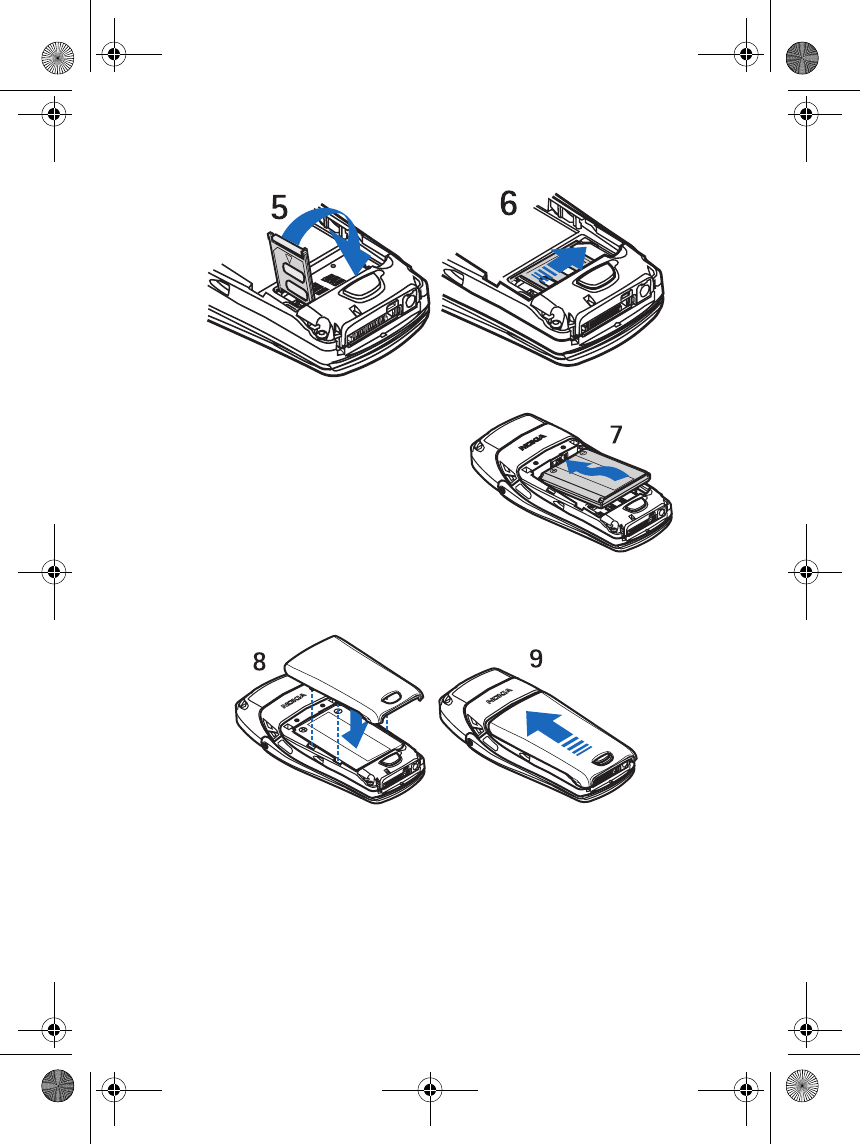
Getting started
17
3. Close the SIM card holder (5) and slide it back into place (6).
4. Replace the battery (7).
5. Direct the back cover towards the locking catches on the phone (8)
and slide the back cover until it locks into place (9).
rm-2_en1_FCC.fm Page 17 Monday, February 16, 2004 8:14 AM
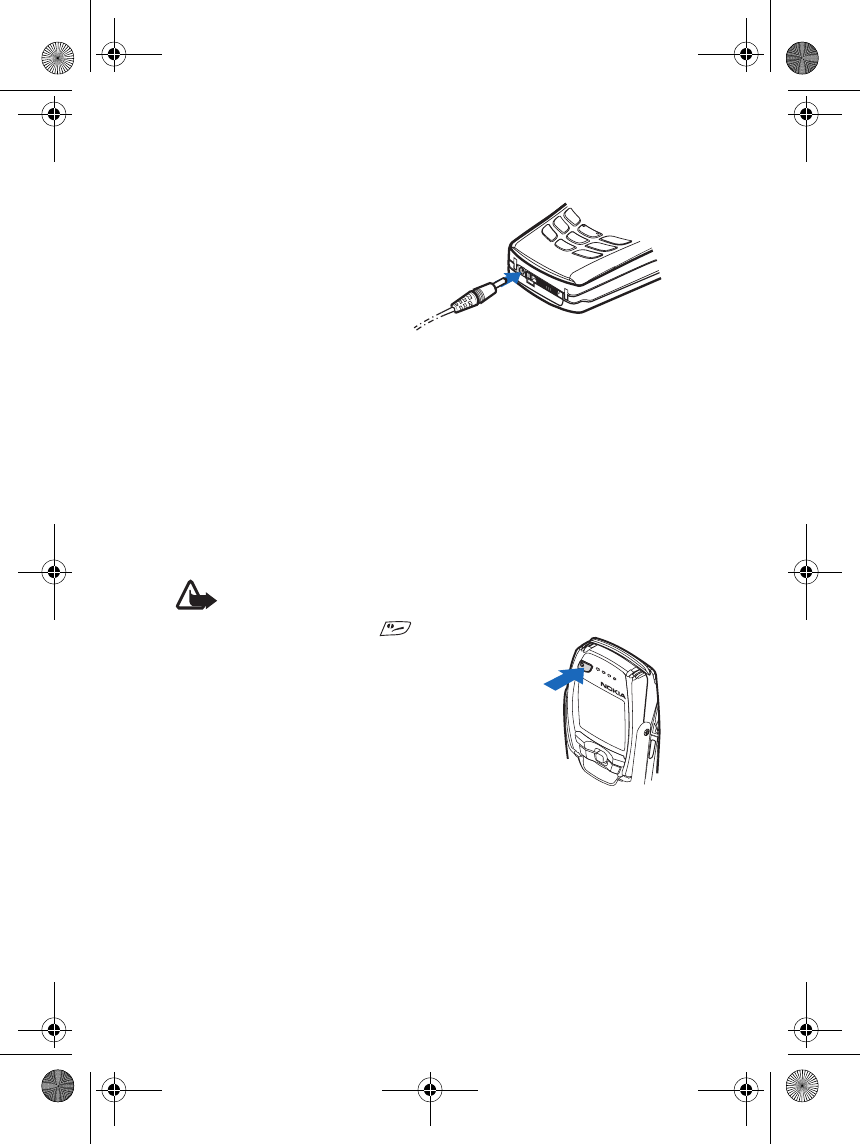
Getting started
18
■Charging the battery
1. Connect the lead from the
charger to the socket on
the bottom of your phone.
2. Connect the charger to an
AC wall socket.
The text Charging is
displayed briefly if the
phone is switched on. If the battery is completely flat, it may take a
few minutes before the charging indicator appears on the display or
before any calls can be made.
You can use the phone while the charger is connected.
The charging time depends on the charger and the battery used. For
example, charging a BLC-2 battery with the ACP-12 charger takes about
1 hour and 30 minutes while the phone is in standby mode.
■Switching the phone on and off
Warning: Do not switch the phone on when wireless phone use is
prohibited or when it may cause interference or danger.
Press and hold the power key .
• If the phone requests a PIN code or a security
code, key in the code, and press OK.
See also Security settings on page 92 and
General information on page 13.
• If the phone displays Insert SIM card even
though the SIM card is properly inserted, or
SIM card not supported, contact your network
operator or service provider. Your phone does not support 5-Volt SIM
cards and the card may need to be changed.
rm-2_en1_FCC.fm Page 18 Monday, February 16, 2004 8:14 AM
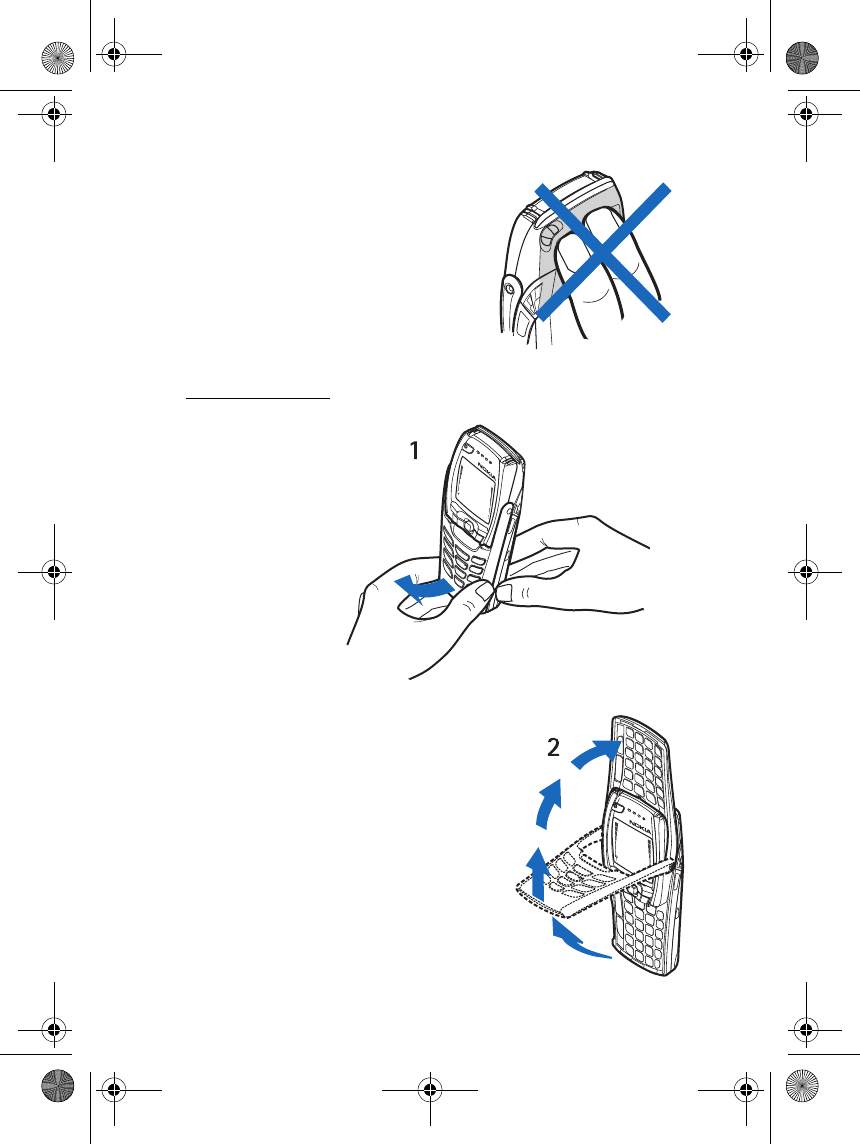
Getting started
19
TIPS ON EFFICIENT OPERATION: Your phone
has a built-in antenna. As with any other radio
transmitting device, do not touch the antenna
unnecessarily when the phone is switched on.
Contact with the antenna affects call quality
and may cause the phone to operate at a
higher power level than otherwise needed. Not
touching the antenna area during a phone call
optimises the antenna performance and the
talktime of your phone.
Opening the flip
1. Hold the
phone with
both hands
and open the
flip as shown
in picture (1).
2. Turn the flip
until you hear it click into place (2). Make
sure that the golden contacts of the flip
and the phone touch each other.
rm-2_en1_FCC.fm Page 19 Monday, February 16, 2004 8:14 AM
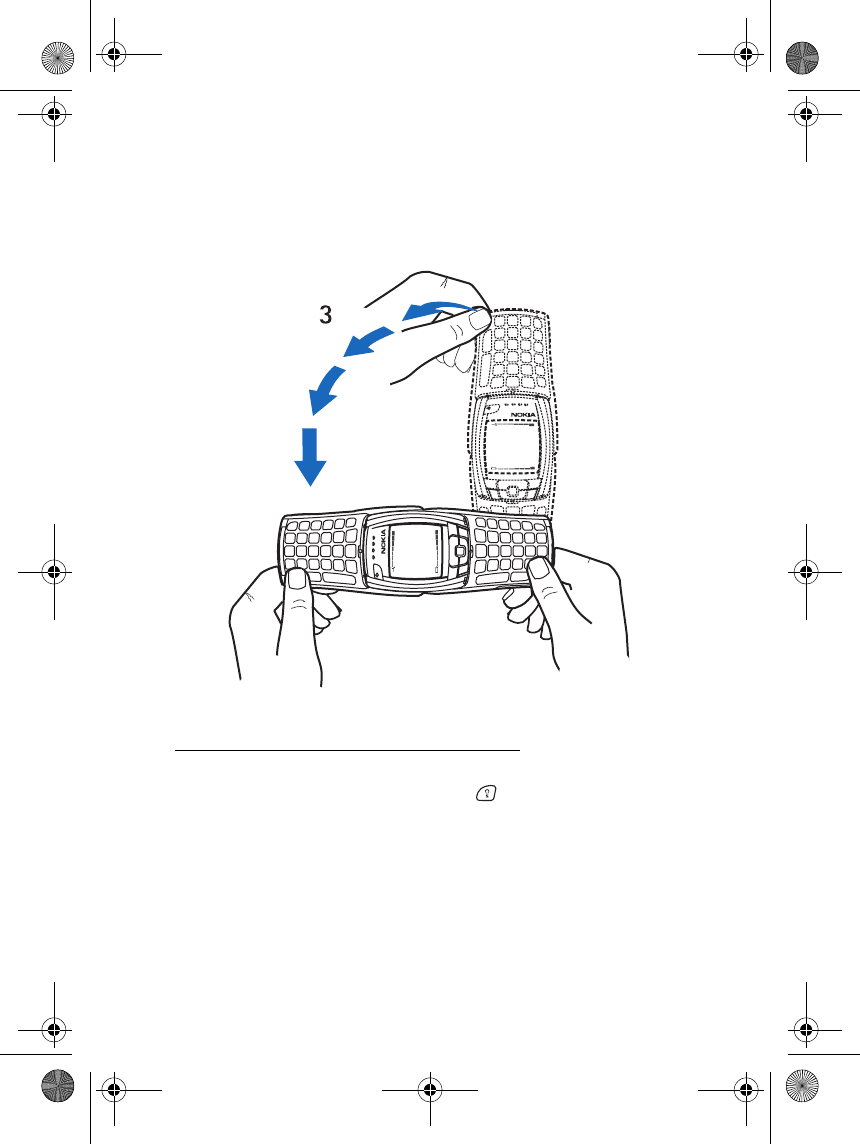
Getting started
20
3. Turn the phone to a horizontal position and hold it as shown in
picture (3). The loudspeaker function automatically activates when
the flip is open.
Switching the keyboard lights on or off
• The keyboard lights are not lit automatically, when you open the flip.
To turn on the lights, press the light key on the top left corner of
the keyboard. The keyboard lights are switched off after a certain
time, but they are turned on again as soon as you press any key.
• To switch the keyboard lights off, press the keyboard light key or
close the flip.
rm-2_en1_FCC.fm Page 20 Monday, February 16, 2004 8:14 AM
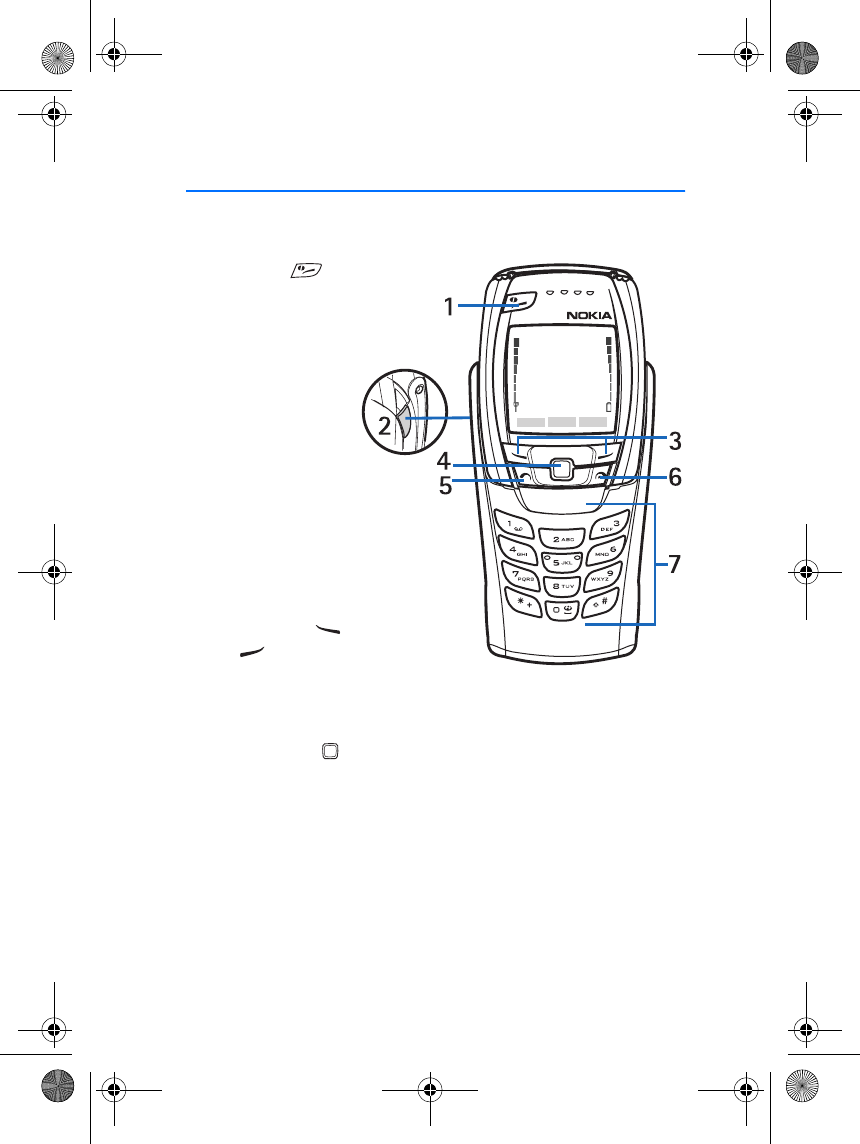
Your phone
21
2. Your phone
■Keys (flip closed)
1. Power key
Switches the phone
on and off.
When the keypad is
locked, pressing the
power key turns the
phone’s display
lights on for
approximately 15
seconds.
2. Volume key
Adjusts the volume
of the earpiece, the
headset and the
loudspeaker.
3. Selection keys
and
The function of the
keys depends on the guiding text shown on the display above the
keys, see Standby mode on page 24.
4. 5-way joystick
Enables scrolling through names, phone numbers, menus or settings.
The 5-way joystick is also used to move the cursor up and down,
right and left when writing text, using the calendar, and in some
game applications. Pressing the joystick also functions as the middle
selection key, and pressing it briefly selects the function shown on
the display above the joystick.
In standby mode, the joystick functions as a shortcut. Press the
joystick
• right to access the Calendar.
rm-2_en1_FCC.fm Page 21 Monday, February 16, 2004 8:14 AM
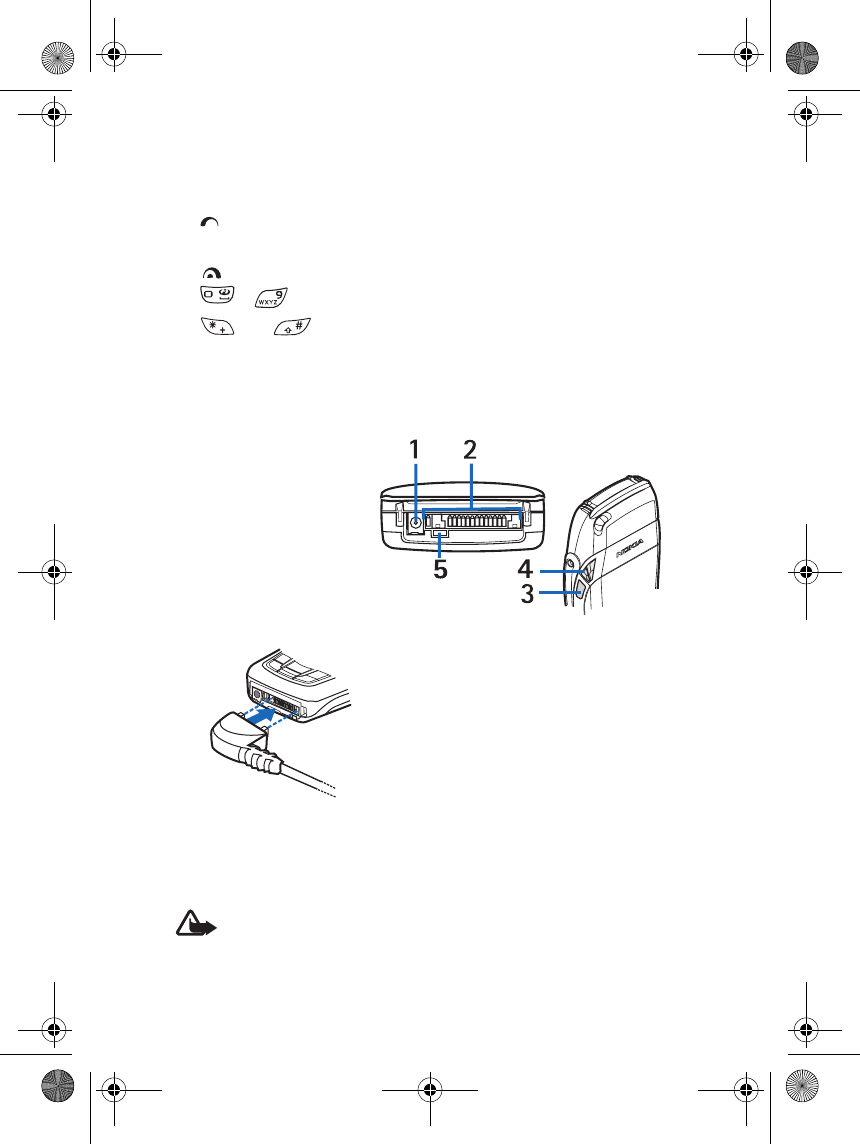
Your phone
22
• left to start writing an SMS message.
• up or down to access the list of contacts.
5. dials a phone number, and answers a call. In standby mode it
shows the list of the most recently called numbers.
6. ends an active call. Exits from any function.
7. - enter numbers and characters.
and are used for various purposes in different functions.
8. Ear piece
■Connectors
1. Charger connector
2. Pop-PortTM connector
for headsets, data
cable and other
enhancements.
Connect an
enhancement to the
Pop-Port connector as
shown in the picture.
3.Infrared (IR) port
4.Loudspeaker
5.Microphone
■Headset
Connect the compatible headset to the Pop-Port connector of your
phone.
Warning: This headset may affect your ability to hear sounds
around you. Do not use this headset in situations that may
endanger your safety.
rm-2_en1_FCC.fm Page 22 Monday, February 16, 2004 8:14 AM
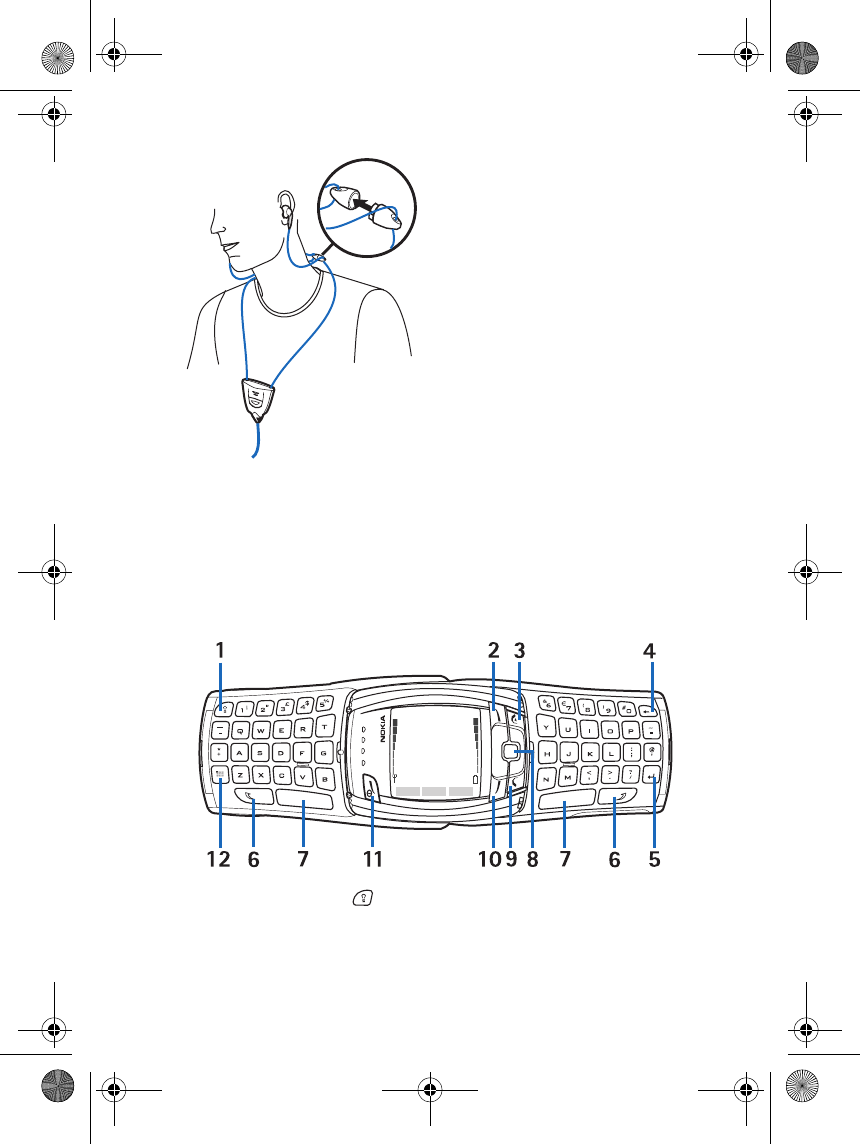
Your phone
23
You can carry the headset as shown
in the picture.
■Keys (flip open)
When you open the flip, the display graphics are rotated 90 degrees and
the left, middle and right selection keys change positions, but the
guiding texts above the selection keys do not change. To use the keys to
write and edit text, see Writing text using the messaging keyboard on
page 34.
1. Keyboard light key switches the keyboard light on or off to
provide additional lighting while using the keyboard. See also
Switching the keyboard lights on or off on page 20.
rm-2_en1_FCC.fm Page 23 Monday, February 16, 2004 8:14 AM

Your phone
24
2. Profile key opens a list of profiles when pressed briefly. Pressing
and holding down the key switches the phone off.
3. ends an active call. Exits from any function.
4. Backspace deletes characters.
5. Enter key forces a line feed when editing text.
6. Shift keys and enter upper-case letters and symbols.
You can either press the shift key first and then the desired key or
press both keys at the same time.
7. Space bar keys and enter a space.
8. 5-way joystick . For usage, see
Keys (flip closed) on page 21. To
select a function as shown in the
picture, press the joystick when the
flip is open.
9. dials a phone number, and
answers a call. In standby mode it
shows the list of most recently
called numbers.
10.Right selection key . The function of the key depends on the
guiding text shown on the display above the key.
11.Power key/Left selection key switches the power on and off.
When the phone’s messaging keyboard is open and the phone is on,
the function of the left selection key depends on the guiding text
shown on the display above the key.
12.Character key opens a set of characters and symbols during text
writing.
■Standby mode
When the phone is ready for use (the flip can be either closed or open),
and you have not keyed in any characters, the phone is in standby mode.
rm-2_en1_FCC.fm Page 24 Monday, February 16, 2004 8:14 AM
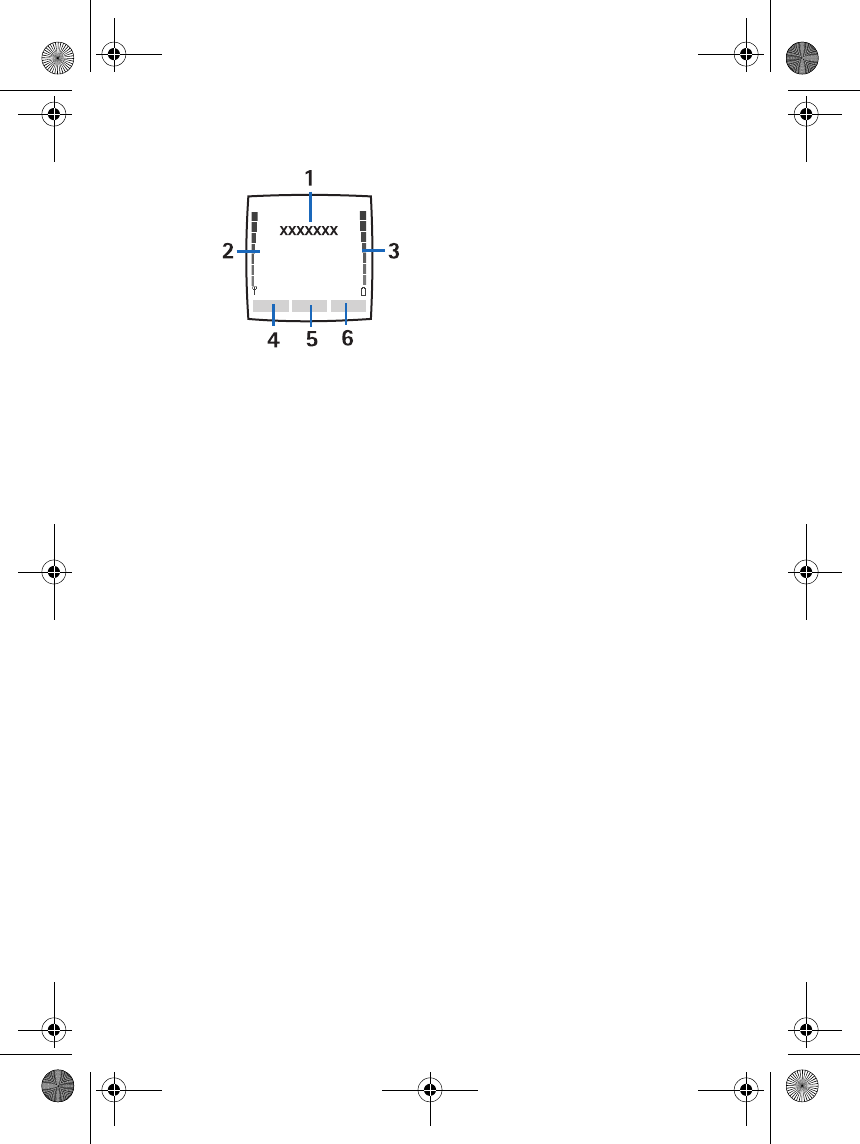
Your phone
25
1. Shows the name of the network or
the operator logo to indicate in
which cellular network the phone is
currently being used.
2.Shows the signal strength of the
cellular network at your current
location. The higher the bar, the
stronger the signal.
3.Shows the battery charge level. The
higher the bar, the more power in the
battery
4. The left selection key in standby mode is Go to.
Press Go to to view the list of available functions that you can add to
your personal shortcut list. Press Options and select
•Select options to view the list of available functions that you can
add.
Scroll to the desired function and press Mark to add it to the
shortcut list. To remove a function from the list, press Unmark.
•Organise to rearrange the functions within the list. Select the
desired function and press Move, then select where you want to
move the function.
If for some reason you have deleted the content of the Go to
menu, press Add to add a function.
5. The middle selection key in standby mode is Menu.
6. The right selection key in standby mode is Names, an operator-
specific key or a shortcut to a function that you have selected. If you
press the right selection key when the text is
•Names, you can access the Contacts menu.
• the operator-specific key, you can access an operator-specific
web site.
• a specific function that you have selected and activated in Right
selection key, you can access it directly. See Personal shortcuts on
page 84.
rm-2_en1_FCC.fm Page 25 Monday, February 16, 2004 8:14 AM
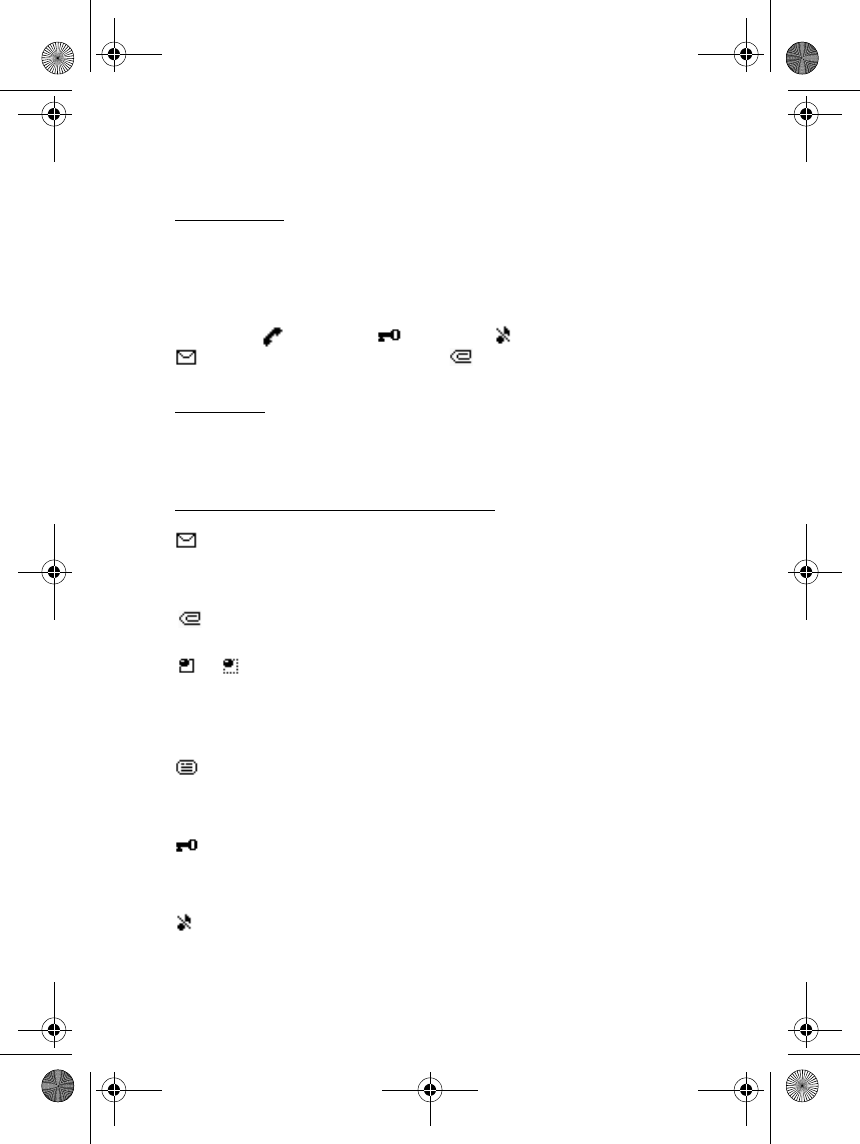
Your phone
26
See also Essential indicators in standby mode on page 26.
Screen saver
The phone automatically activates a screen saver after a certain length
of time when none of the phone functions have been used, see Display
settings on page 82.
When the screen saver is on, the phone still displays the icons indicating
missed calls , keypad lock , silent mode , received messages
and received multimedia messages .
Wallpaper
You can set your phone to display a background picture as wallpaper
when the phone is in standby mode, see Display settings on page 82.
Essential indicators in standby mode
You have received one or several text or picture messages. See
Reading and replying to an SMS message or an SMS e-mail on
page 44.
You have received one or several multimedia messages. See
Reading and replying to a multimedia message on page 50.
or
Your phone is connected to the chat service and the availability
status is online or offline, respectively. See Connecting to and
disconnecting from the chat service on page 57.
You have received one or several chat messages and you are
connected to the chat service. See Connecting to and
disconnecting from the chat service on page 57.
The phone’s keypad is locked. See Keypad lock (Keyguard) on
page 28 and Automatic keyguard and Security keyguard in
Phone settings on page 90.
The phone does not ring for an incoming call or a text message
because Incoming call alert is set to Off and Message alert tone
is set to Off. See Tone settings on page 81.
rm-2_en1_FCC.fm Page 26 Monday, February 16, 2004 8:14 AM
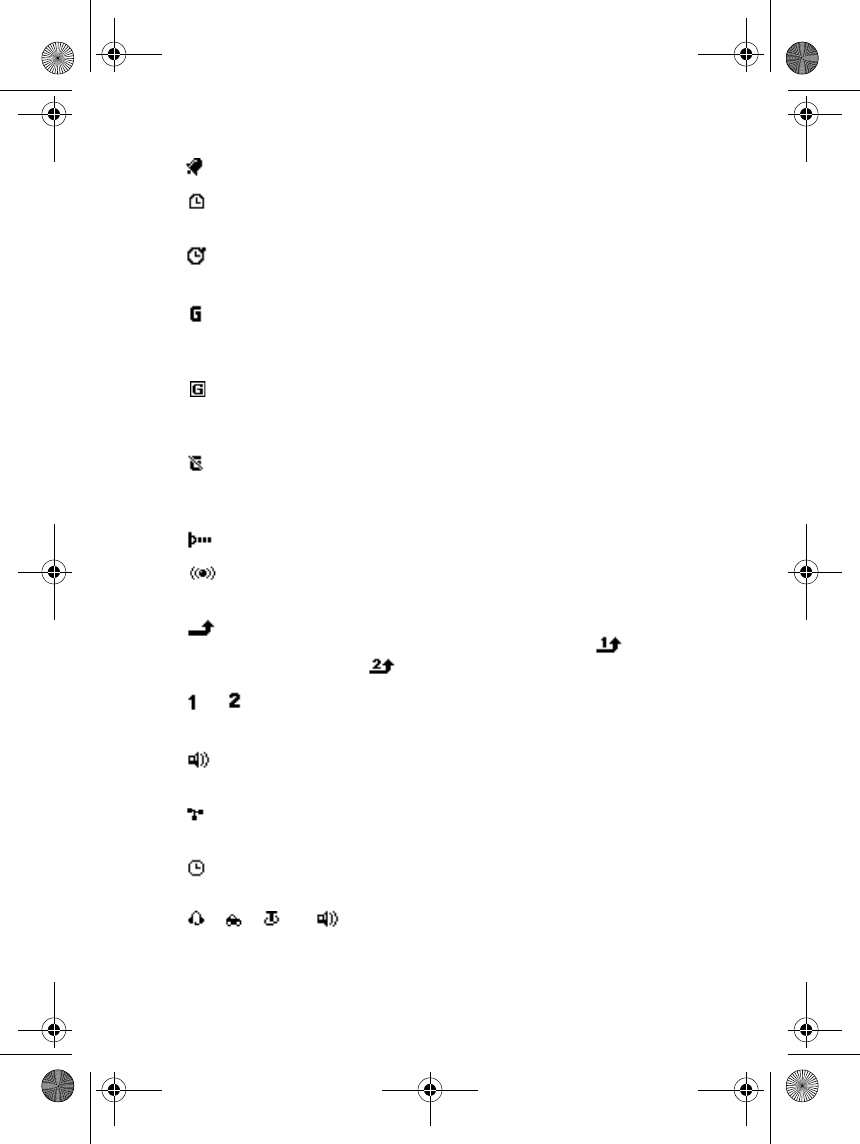
Your phone
27
The alarm clock is set to On. See Alarm clock on page 98.
The countdown timer is running. See Countdown timer on page
112.
The stopwatch is running in the background. See Stopwatch on
page 112.
When the EGPRS connection mode Always online is selected
and the EGPRS service is available, the indicator is shown on the
top left of the display. See EGPRS connection on page 88.
When an EGPRS connection is established, this indicator is
shown on the top left of the display. See EGPRS connection on
page 88 and Browsing the pages of a service on page 115.
The EGPRS connection is suspended (on hold), for example, if
there is an incoming or outgoing call during an EGPRS dial-up
connection.
The infrared connection indicator. See Infrared on page 86.
The Bluetooth connection indicator. See Bluetooth wireless
technology on page 84.
All your calls are diverted to another number. If you have two
phone lines, the divert indicator for the first line is and for
the second line is . See Call settings on page 89.
or If you have two phone lines, the indicator displays the selected
phone line. See Call settings on page 89.
The loudspeaker has been activated. See Options during a call
on page 32.
Calls are limited to a closed user group. See Security settings on
page 92.
The timed profile is selected. See Profiles on page 80.
, , or
A headset, handsfree, loopset or music stand enhancement is
connected to the phone.
rm-2_en1_FCC.fm Page 27 Monday, February 16, 2004 8:14 AM
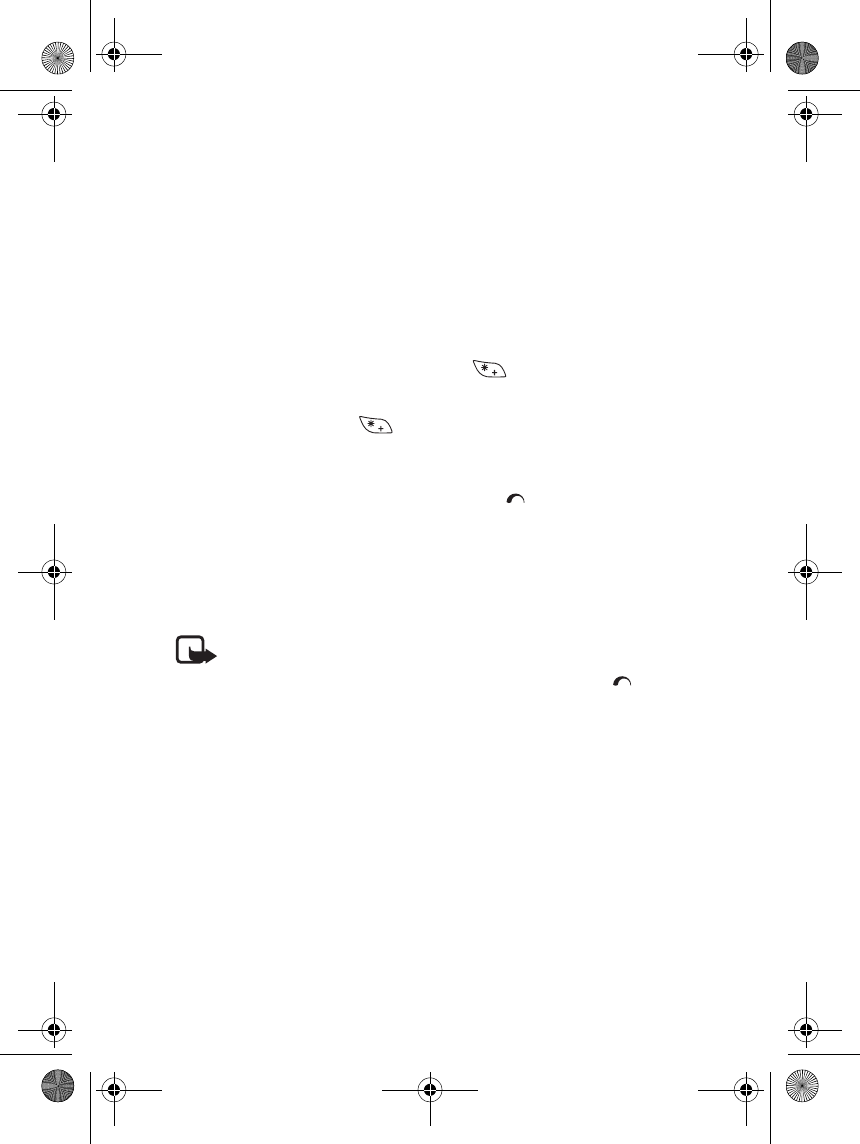
Your phone
28
Time and date
See Time and date settings on page 83.
■Keypad lock (Keyguard)
You can lock the keypad to prevent the keys being accidentally pressed,
for example, when your phone is in your handbag. You can only lock the
keypad when the flip is closed.
•Locking the keypad
In standby mode, press Menu and then within 1.5 seconds.
•Unlocking the keypad
Press Unlock and then within 1.5 seconds or open the flip.
Note that the keyguard will not be activated when if you close the
flip, if the automatic keyguard is not activated.
To answer a call when the keyguard is on, press . During a call, the
phone can be operated normally. When you end or reject the call, the
keypad will automatically lock, if the display is empty.
For locking the keypad during a call, see Options during a call on page
32, and for setting the security keyguard, see Security keyguard in Phone
settings on page 90.
Note: When Keyguard is on, calls may be possible to the emergency
number programmed into your phone (e.g. 112 or other official
emergency number). Key in the emergency number and press . The
number is displayed only after you have keyed in its last digit.
■Over-the-air settings service
In order to use MMS, EGPRS, and other wireless services, you need to
have proper connection settings on your phone. You may be able to
receive the settings directly as an over-the-air message and then save
them on your phone. For more information on the availability of the
settings, contact your network operator, service provider or the nearest
authorised Nokia dealer.
You may be able to receive the connection settings for EGPRS,
multimedia messages, synchronisation, chat and presence, e-mail and
rm-2_en1_FCC.fm Page 28 Monday, February 16, 2004 8:14 AM
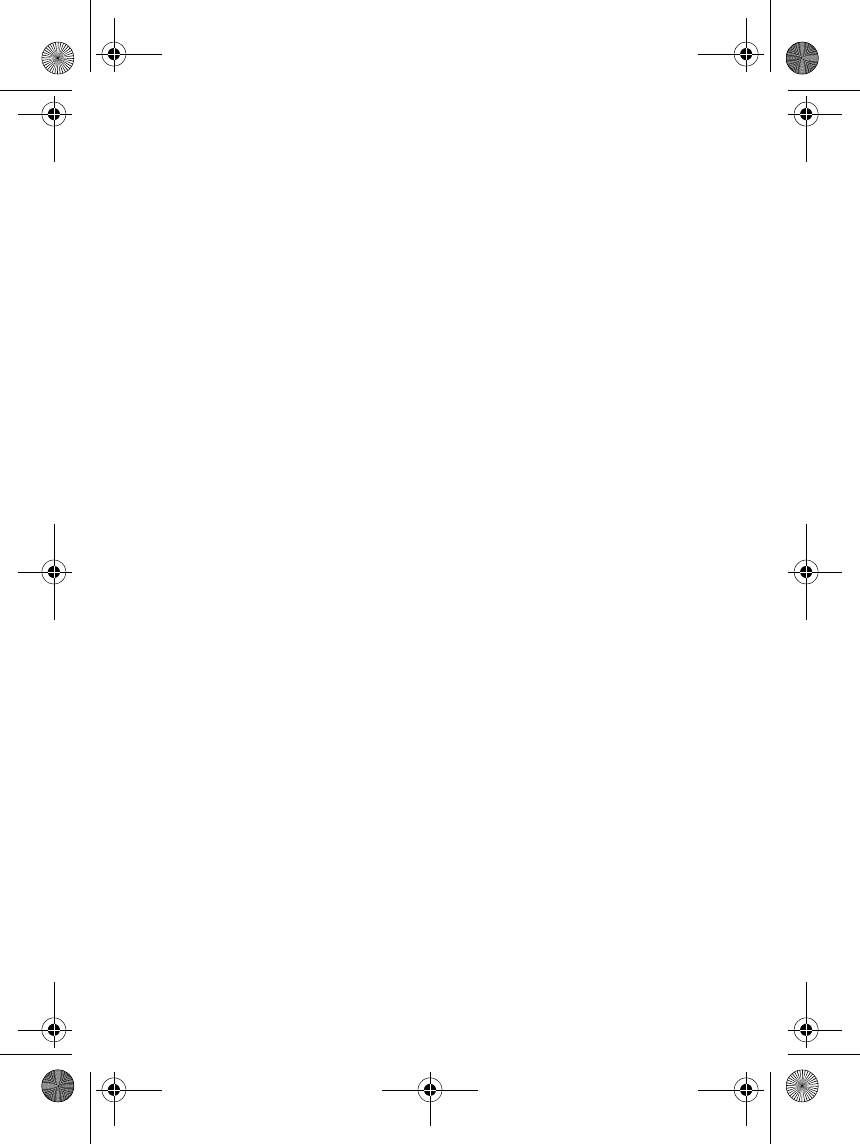
Your phone
29
for the multi-mode browser. For more information about receiving the
settings, see Settings for the e-mail application on page 52.
When you have received the connection settings as an over-the-air
message Connection settings received is displayed.
• To save the settings, press Options and select Save. If the phone asks
you to Enter settings’ PIN:, key in the PIN code for the settings and
press OK. For the availability of the PIN code, contact the service
provider that supplies the settings.
If no settings have been saved yet, the settings are saved under the
first free connection set.
• To view the received settings first, press Options and select View. To
save the settings, press Save.
• To discard the received settings, press Options and select Discard.
To activate the settings, see Connecting to a service on page 114.
If you want to delete a connection set from the phone, key in
*#335738# (*#delset# in letters) in standby mode, select a connection
set that you want to delete and press Delete. Then confirm your
selection and the phone returns to standby mode.
rm-2_en1_FCC.fm Page 29 Monday, February 16, 2004 8:14 AM
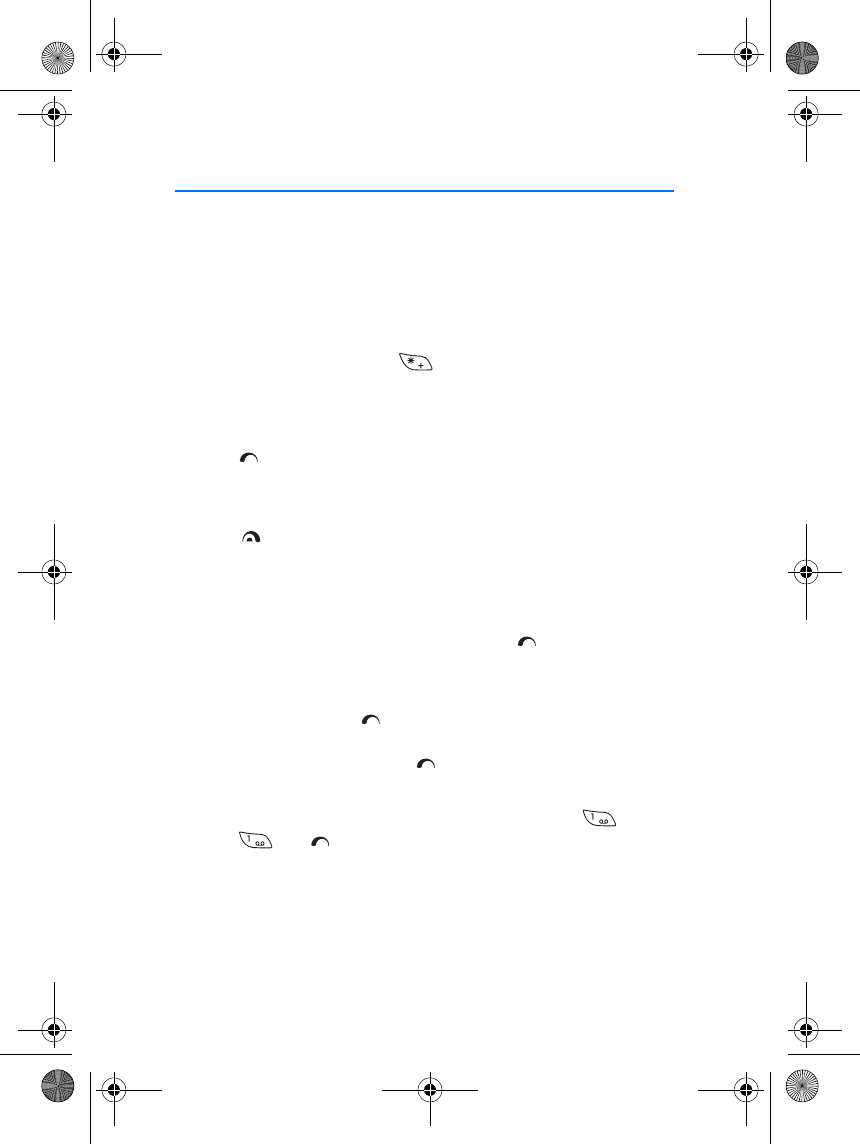
Call functions
30
3. Call functions
■Making a call
1. Key in the phone number, including the area code. If you key in an
incorrect character, press Clear to delete it. To make a call when the
flip is open, key in the phone number using the number keys. The
loudspeaker is always activated, when you open the flip.
For international calls, press twice for the international prefix
or + if the flip is open, (the + character replaces the international
access code) and then key in the country code, the area code without
the leading 0, if necessary, and finally the phone number.
2. Press to call the number.
To adjust the volume during a call, use the volume key on the side of
the phone.
3. Press to end the call or to cancel the call attempt.
See also Options during a call on page 32.
Making a call using contacts
• To search for a name/phone number that you have saved in Contacts
See Searching for a contact on page 72. Press to call the number
on the display.
Last number redialling
• In standby mode, press once to access the list of upto 20 last
numbers you called or attempted to call. Scroll to the number or
name that you want, and press to call the number.
Calling your voice mailbox (network service)
• In standby mode when the flip is closed, press and hold , or
press and . When the flip is open, press and hold the
corresponding number key on the keyboard.
If the phone requests the voice mailbox number, key it in and press
OK. See also Voice messages on page 61.
rm-2_en1_FCC.fm Page 30 Monday, February 16, 2004 8:14 AM
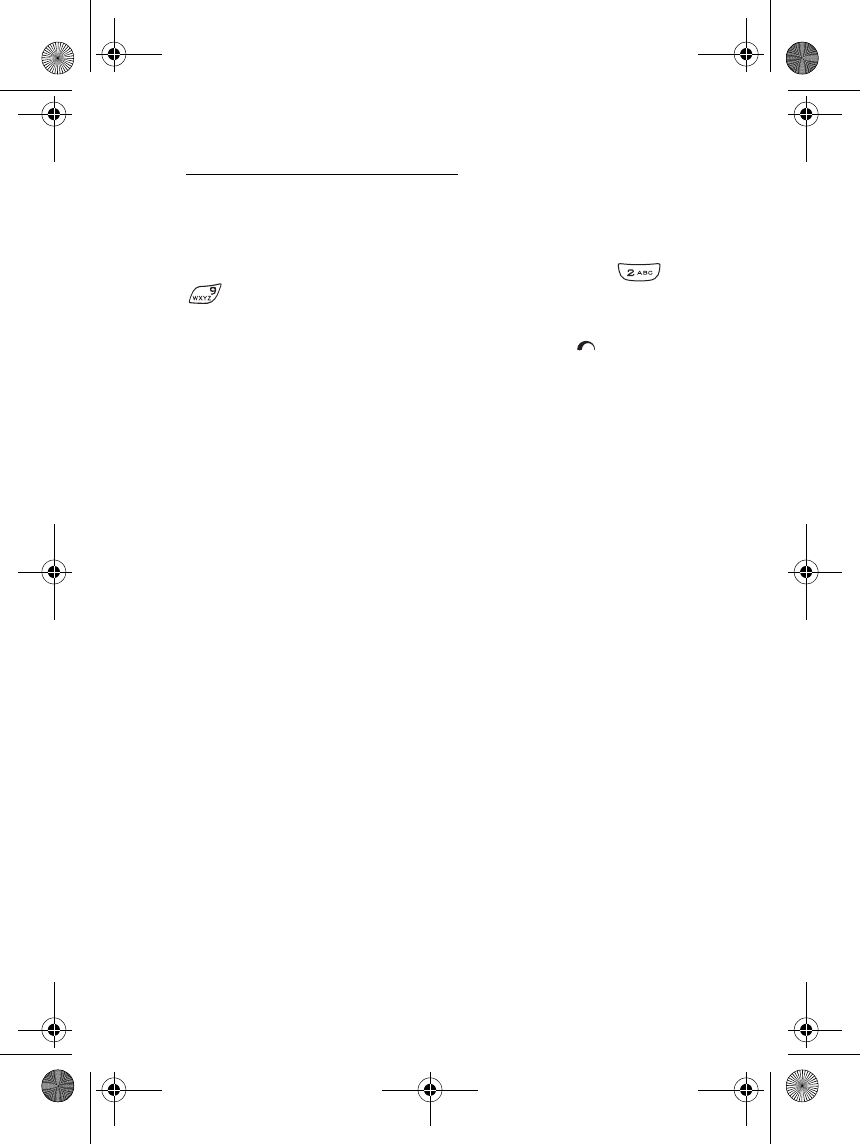
Call functions
31
Speed dialling a phone number
Before you can use speed dialling, proceed as follows:
Press Menu, select Settings, More settings,Call settings and Speed
dialling. Set the setting to On.
Assign a phone number to one of the speed-dialling keys from to
, see Speed dials on page 77. Call the number in either of the
following ways:
• Press the speed dialling key you want and then press . You can
also activate speed dialling by pressing the corresponding number
key on the keyboard, when the flip is open.
•If Speed dialling is set to on, press and hold a speed-dialling key until
the call is started.
rm-2_en1_FCC.fm Page 31 Monday, February 16, 2004 8:14 AM
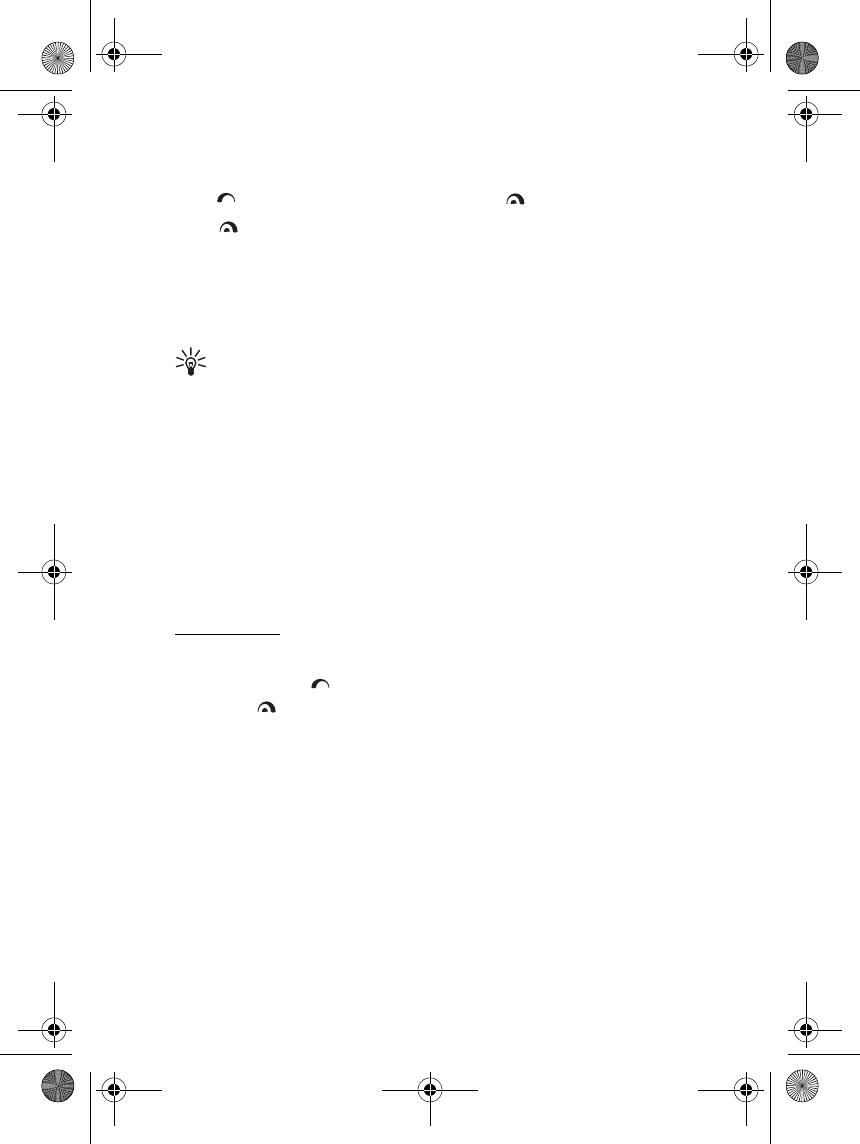
Call functions
32
■Answering or rejecting an incoming call
Press to answer an incoming call and press to end the call.
Press to reject an incoming call.
If you press Silence, only the ringing tone is muted. Then either answer
or reject the call.
If a compatible headset with the headset key is connected to the phone,
you can answer and end a call by pressing the headset key.
Tip: If the Divert if busy function has been activated to divert
calls, for example to your voice mailbox, rejecting an incoming
call will also divert the call. See Call settings on page 89.
Note that when somebody is calling you, the phone shows the caller’s
name, phone number, or the text Private number or Call. If more than
one name is found in Contacts with a phone number having the same
seven last digits as the caller’s number, only the phone number will be
displayed, if it is available. The phone may display an incorrect name, if
the caller’s number has not been saved in Contacts but there is another
name saved whose phone number has the same seven last digits as the
phone number of the caller.
Call waiting
Call waiting is a network service.
During a call, press to answer the waiting call. The first call is put on
hold. Press to end the active call.
To activate the Call waiting function, see Call settings on page 89.
■Options during a call
Note that some of the options during a call are network services. For
availability, contact your network operator or service provider. Press
Options during a call and select:
•Lock keypad, Record, End call, New call (network service), End all
calls, Contacts, Menu, Mute or Unmute, Hold or Unhold (network
service), Private call (network service), Answer and Reject.
rm-2_en1_FCC.fm Page 32 Monday, February 16, 2004 8:14 AM

Call functions
33
•Conference to make a conference call that allows up to five people to
participate in a conference call (network service). During a call, make
a call to a new participant (New call). The first call is put on hold.
When the new call has been answered, select Conference to include
the first participant in the call. To have a private conversation with
one of the participants, select Private call and select the participant.
To rejoin the conference call after a private conversation, select
Conference.
•Send DTMF to send DTMF (Dual Tone Multi-Frequency) tone strings,
for example passwords or bank account numbers. The DTMF system
is used by all touch-tone telephones. Key in the DTMF string, or
search for it in Contacts. Note that you can key in the wait character
w and the pause character p by repeatedly pressing .
•Swap (network service) to switch between the active call and the call
on hold, Transfer (network service) to connect a call on hold to an
active call and to disconnect yourself from the calls.
•Loudspeaker to use your phone as a loudspeaker during a call, such
as a conference call. In addition, you can use the loudspeaker to carry
out other tasks simultaneously, since you can put the phone down
instead of holding it in your hand. Do not hold the phone to your ear
during loudspeaker operation, as the volume may be extremely loud.
To activate the loudspeaker, open the flip or, if the flip is closed, press
Options and select Loudspeaker or press Loudsp., if available.
To deactivate the loudspeaker during a call, close the flip or press
Normal, when the flip is open. When the flip is closed, press Options
and select Handset or press Normal, if available
The loudspeaker is deactivated automatically when you end the call
or call attempt, connect a compatible handsfree unit or a headset to
the phone, or close the flip.
If you have connected a compatible handsfree unit or a headset to
the phone, Handset in the options list is replaced with Handsfree or
Headset and the selection key Normal with Handsf. or Heads.,
respectively.
Using the loudspeaker with the stereo radio, see Radio (Menu 6) on
page 96.
rm-2_en1_FCC.fm Page 33 Monday, February 16, 2004 8:14 AM
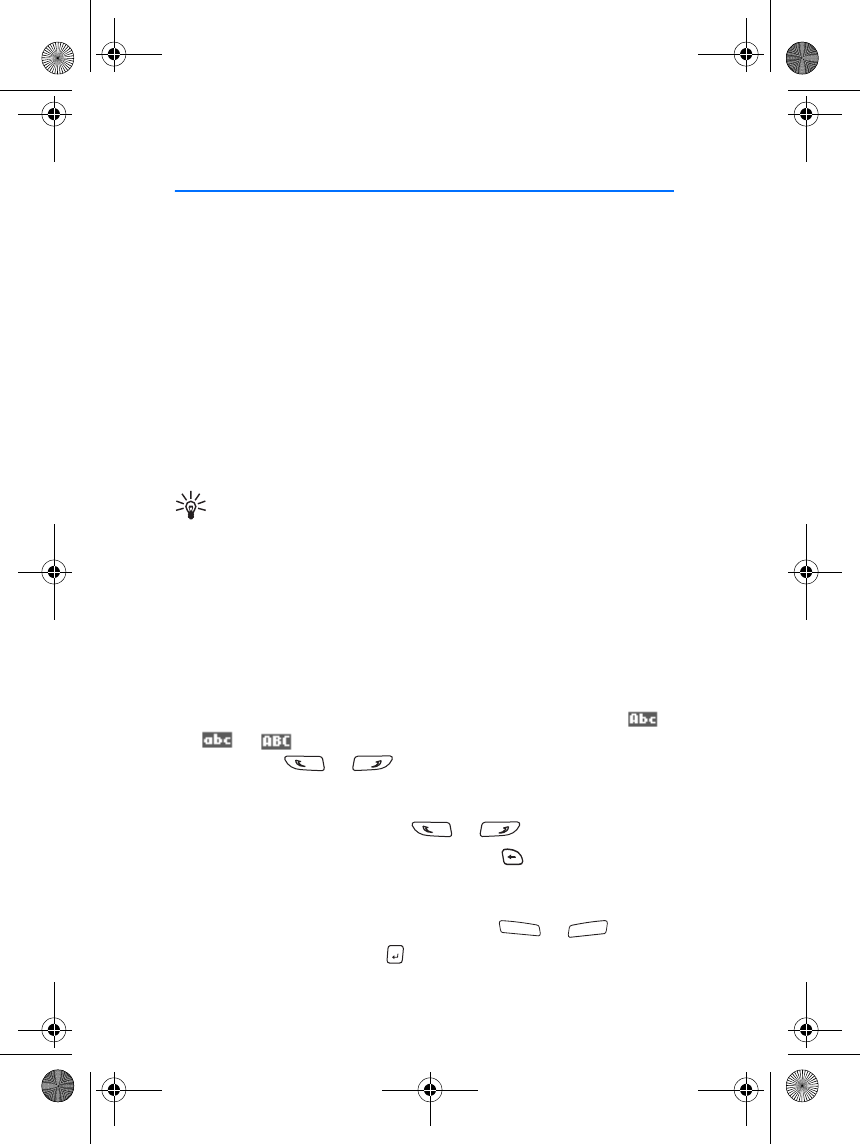
Writing text
34
4. Writing text
Your phone is especially designed for easy and comfortable text writing.
A good way is to write with your thumbs using the messaging keyboard.
You can, for example start writing a message using the keyboard, close
the flip and continue writing with either traditional or predictive text
input. Note that predictive text input is not available, when the flip is
open.
■Writing text using the messaging keyboard
When the flip is open, you can start to write a message or a note.
For example, press Menu and select Messages, Text messages and
Create message, see Writing and sending messages on page 42.
Tip: To quickly start writing a message move the joystick to the
left in standby mode.
Or: Press any of the letter keys in standby mode (except the pause
character p or the wait character w) to open the Notes application, see
Notes on page 101.
The following functions are available when writing text, while the flip is
open:
• To insert a number, press any of the number keys. Pressing a number
key in standby mode initiates a normal call procedure.
• To switch between lower and upper-case letters, indicated by ,
or on the top left of the display, or to key in symbols,
press either or on the keyboard. You can either press
the shift key and the desired character consecutively, or press and
hold both the shift key and the desired letter key at the same time. To
write in upper case only, press or twice.
• To delete characters from the display, press or Clear. Pressing
backspace briefly clears one character at a time, while a longer
keypress deletes characters more quickly.
• To add a space, press one of the space keys or .
• To force a line break, press .
rm-2_en1_FCC.fm Page 34 Monday, February 16, 2004 8:14 AM
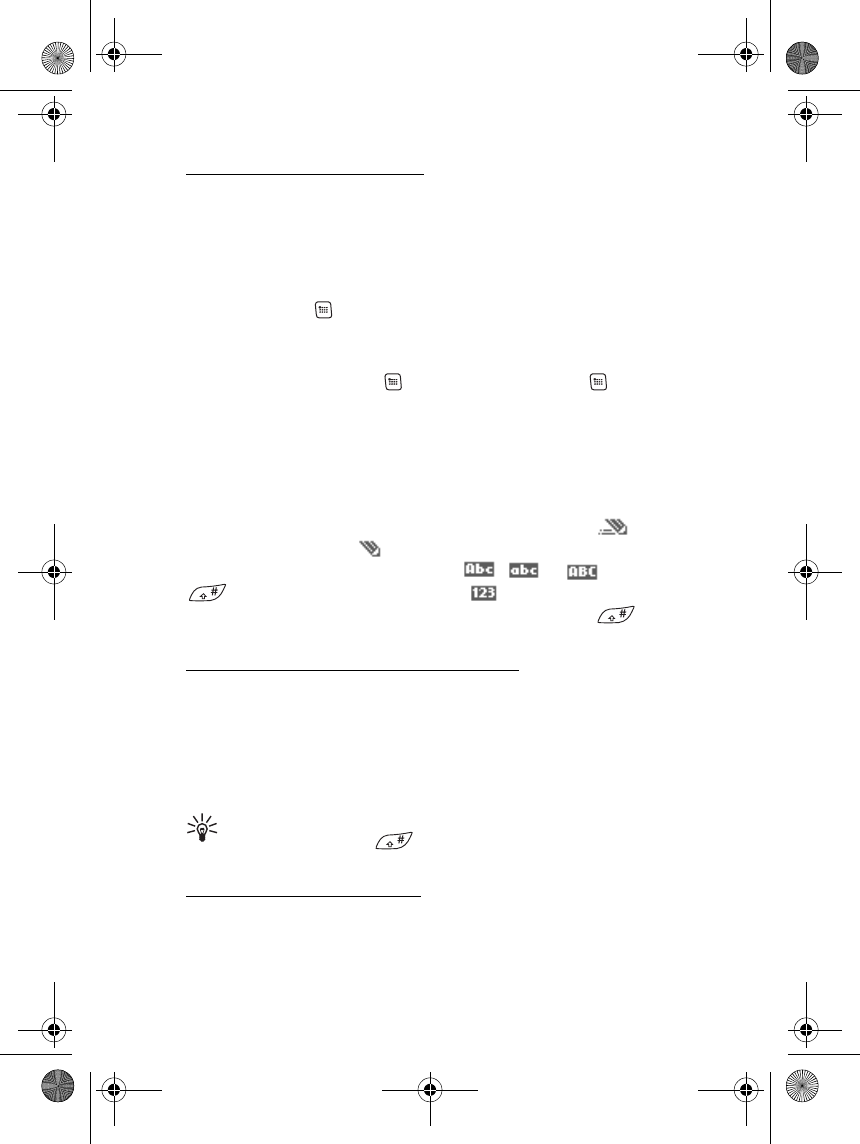
Writing text
35
Typing accented characters
The characters available depend on the language selected in the Phone
language menu, see Phone settings on page 90. To type accented
characters or symbols that are not printed on the keyboard, do one of
the following:
• To access a set of punctuation marks, accented characters and
symbols, press . Scroll through the character set by moving the
joystick and press Use to select the character.
• To type an accented character that is not included in the list of
special characters under , such as á, press and hold and
simultaneously press ’a’ repeatedly until the desired accented variant
of ’a’ appears on the display.
■Writing text when the flip is closed
You can use predictive or traditional text input when the phone’s flip is
closed. During writing, predictive text input is indicated by and
traditional text input by on the top left of the display. You can
change the character case, indicated by , or by pressing
. The number mode is indicated by , and you can change
between letter and number modes by pressing and holding .
Setting predictive text input on or off
When writing text, press Options and select Dictionary.
• To set the predictive text input on, select a language from the
dictionary options list. Predictive text input is only available for the
languages on the list.
• To revert to traditional text input, select Dictionary off.
Tip: To quickly set the predictive text input on or off when
writing text, press twice, or press and hold Options.
Using predictive text input
You can key in any letter with a single keypress. Predictive text input is
based on a built-in dictionary to which you can also add new words.
rm-2_en1_FCC.fm Page 35 Monday, February 16, 2004 8:14 AM
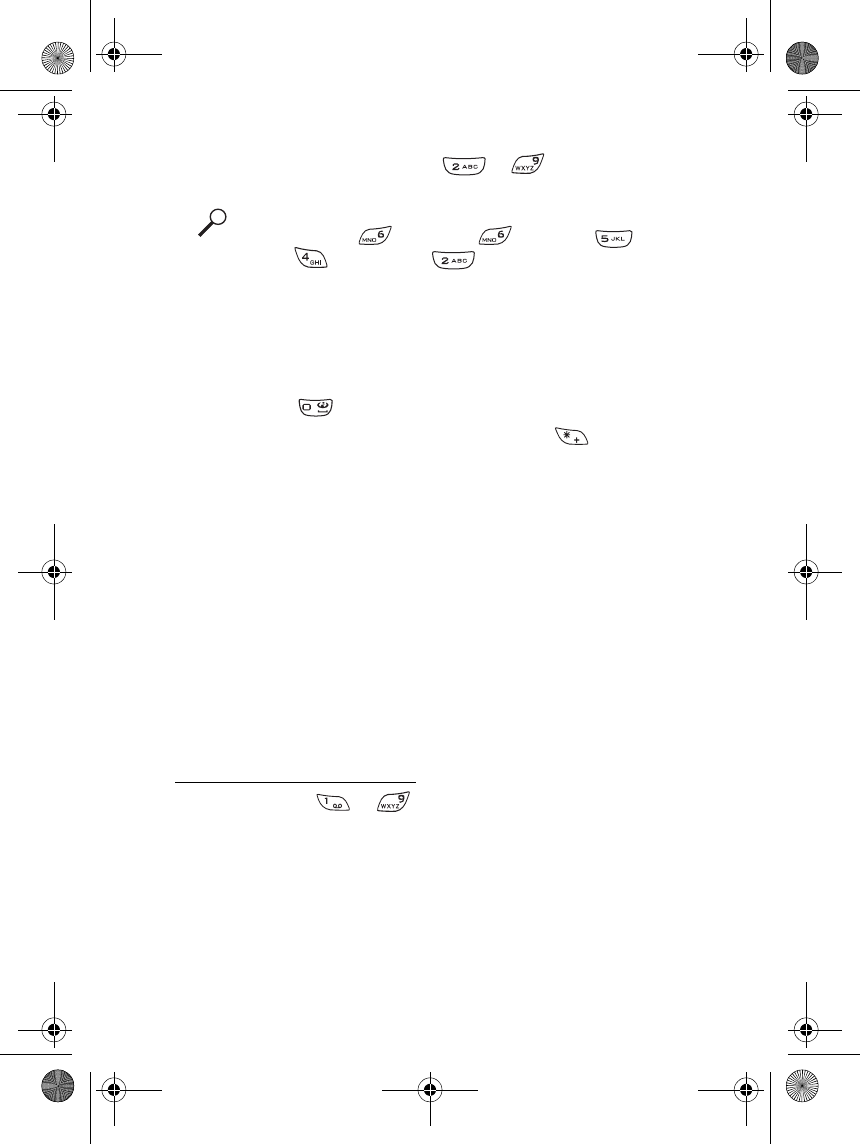
Writing text
36
1. Start writing a word using the keys to . Press each key
only once for one letter. The word may change after each keystroke.
Example: To write Nokia when the English dictionary is
selected, press once for N, once for o, once
for k, once for i and once for a.
To insert a number while in letter mode, press and hold the desired
number key.
For more instructions for writing text, see Tips for writing text on
page 37.
2. When you have finished writing the word and it is correct, confirm it
by space with or by moving the joystick to the right.
If the word is not the one you are looking for, press repeatedly
or press Options and select Matches. When the word you want
appears, confirm it.
3. If the ? character is displayed after the word, the word that you
intended to write is not in the dictionary. To add the word to the
dictionary, press Spell, key in the word (traditional text input is used)
and press Save. When the dictionary becomes full, the new word
replaces the oldest one that was added.
4. Start writing the next word.
Writing compound words
Key in the first part of the word and confirm it by moving the joystick to
the right. Write the last part of the word and confirm it by moving the
joystick to the right.
Using traditional text input
Press a number key, to , repeatedly until the desired
character appears. Not all characters available under a number key are
printed on the key. The characters available depend on the language
selected in the Phone language menu, see Phone settings on page 90.
To insert a number while in letter mode, press and hold the desired
number key.
rm-2_en1_FCC.fm Page 36 Monday, February 16, 2004 8:14 AM

Writing text
37
• If the next letter you want is located on the same key as the present
one, wait until the cursor appears, or move the joystick to the right,
and then key in the letter.
• The most common punctuation marks and special characters are
available under the number key .
For more instructions for writing text, see Tips for writing text on page
37.
Tips for writing text
The following functions may also be available for writing text in
predictive or traditional input:
• To insert a space, press .
• To move the cursor to the right, left, up or down, move the joystick
correspondingly.
• To delete a character from the display, press Clear. Press and hold
Clear to delete the characters more quickly.
To delete all the characters simultaneously when writing a message,
press Options and select Clear text.
• To insert a word that is not in the dictionary when using predictive
text input, press Options and select Insert word. Write the word
using traditional text input and press Save. The word is also added to
the dictionary.
• To insert a special character when using traditional text input, press
or when using predictive text input, press and hold , or
press Options and select Insert symbol.
Move the cursor with the joystick to a character and press Use to
select it.
You can also scroll to a character by pressing , , or
, and select it by pressing .
The following options are available when writing text messages:
• To insert a phone number while in letter mode, press Options and
select Insert number. Key in the number or search for it in Contacts
and press OK.
rm-2_en1_FCC.fm Page 37 Monday, February 16, 2004 8:14 AM
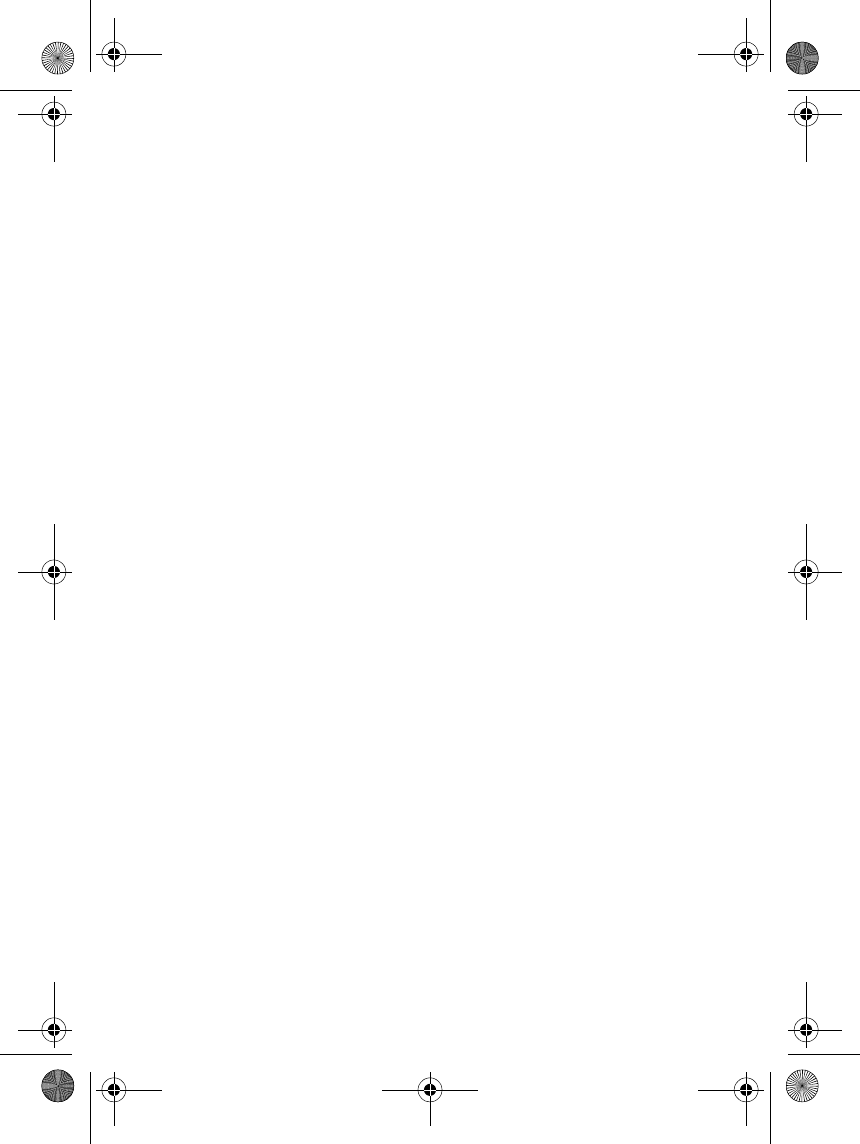
Writing text
38
• To insert a name from Contacts, press Options and select Insert
contact. To insert a phone number or a text item attached to the
name, press Options and select View details.
rm-2_en1_FCC.fm Page 38 Monday, February 16, 2004 8:14 AM
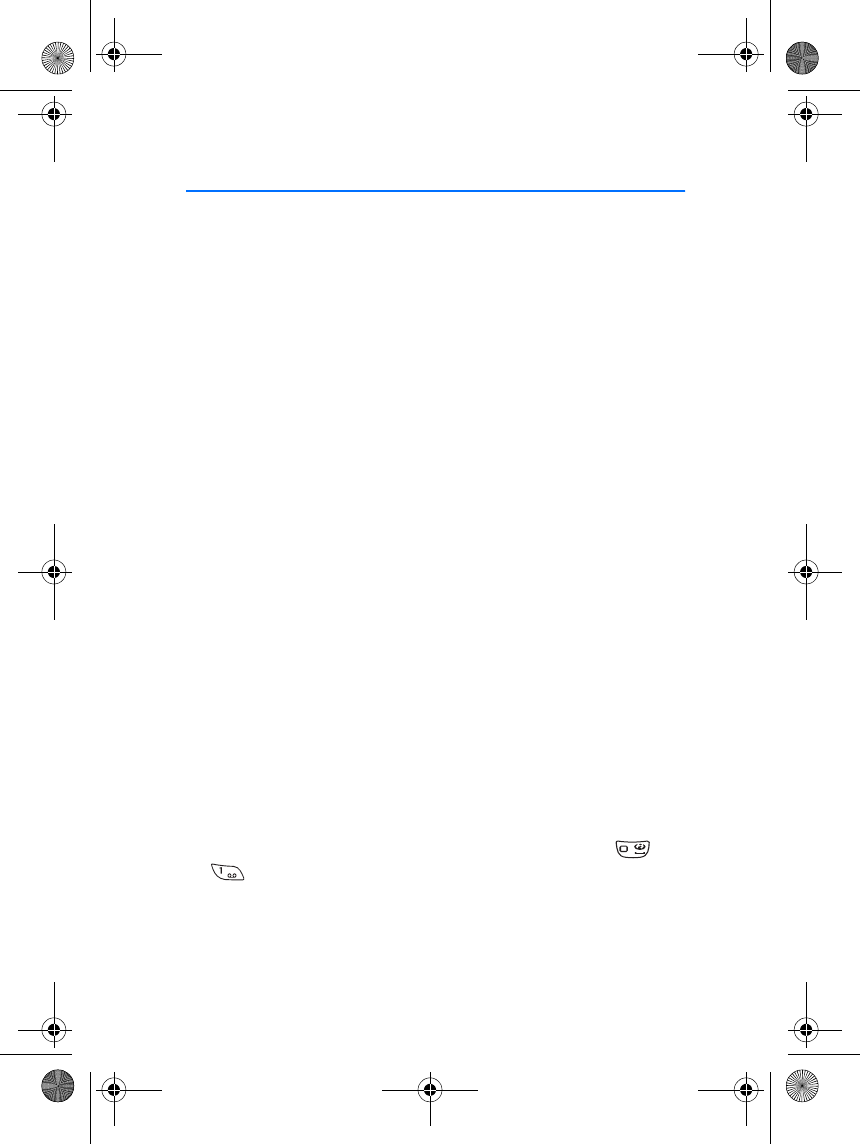
Using the menu
39
5. Using the menu
The phone offers you an extensive range of functions, which are
grouped into menus. Most of the menu functions are provided with a
brief help text. To view the help text, scroll to the menu function you
want and wait for 15 seconds. To exit the help text, press Back. See
Phone settings on page 90.
■Accessing a menu function
By scrolling
1. To access the menu, press Menu.
2. Scroll through the menu by moving the joystick up or down (or right
and left if the grid menu is selected), and select, for example,
Settings by pressing Select. To change the menu view, see Display
settings on page 82.
3. If the menu contains submenus, select the one you require, for
example Profiles.
4. If the selected submenu contains further submenus, repeat step 3.
Select the next submenu, for example Anykey answer.
5. Select the setting of your choice.
6. Press Back to return to the previous menu level, and Exit to exit the
menu.
By using a shortcut
The menus, submenus and setting options are numbered and you can
access most of them by using their shortcut number.
• To access the menu, press Menu. Key in quickly, within two seconds,
the index number of the menu function you want to access. Note
that to access the menu functions in menu 1, press Menu, ,
and then key in the rest of the desired shortcut number.
Press Back to return to the previous menu level, and Exit to exit the
menu.
rm-2_en1_FCC.fm Page 39 Monday, February 16, 2004 8:14 AM

Using the menu
40
■List of menu functions
1. Messages
1. Text messages
2. Multimedia
msgs.
3. E-mail
4. Chat
5. Voice messages
6. Info messages
7. Message settings
8. Service commands
2. Call register
1. Missed calls
2. Received calls
3. Dialled numbers
4. Delete recent call lists
5. Timers and counters
3. Contacts
1. Search
2. Add contact
3. Delete
4. My presence
5. Subscribed names
6. Copy
7. Settings
8. Speed dials
9. Voice tags
10.Info numbers1
11.Service numbers 1
12.My numbers
13.Caller groups
4. Settings
1. Profiles
2. Chat and my
presence settings
3. Tone settings
4. Display settings
5. Time and date settings
6. Personal shortcuts
7. Connectivity
8. More settings
9. Restore factory settings
5. Gallery
1. Video clips
2. Graphics
3. Tones
4. Recordings
6. Radio
7. Organiser
1. Alarm clock
2. Calendar
3. To-do list
4. Notes
5. Wallet
6. Synchronisation
8. Applications
1. Games
2. Collection
3. Extras
1. Shown if supported by your SIM card. For availability, contact your network op-
erator or service provider.
rm-2_en1_FCC.fm Page 40 Monday, February 16, 2004 8:14 AM
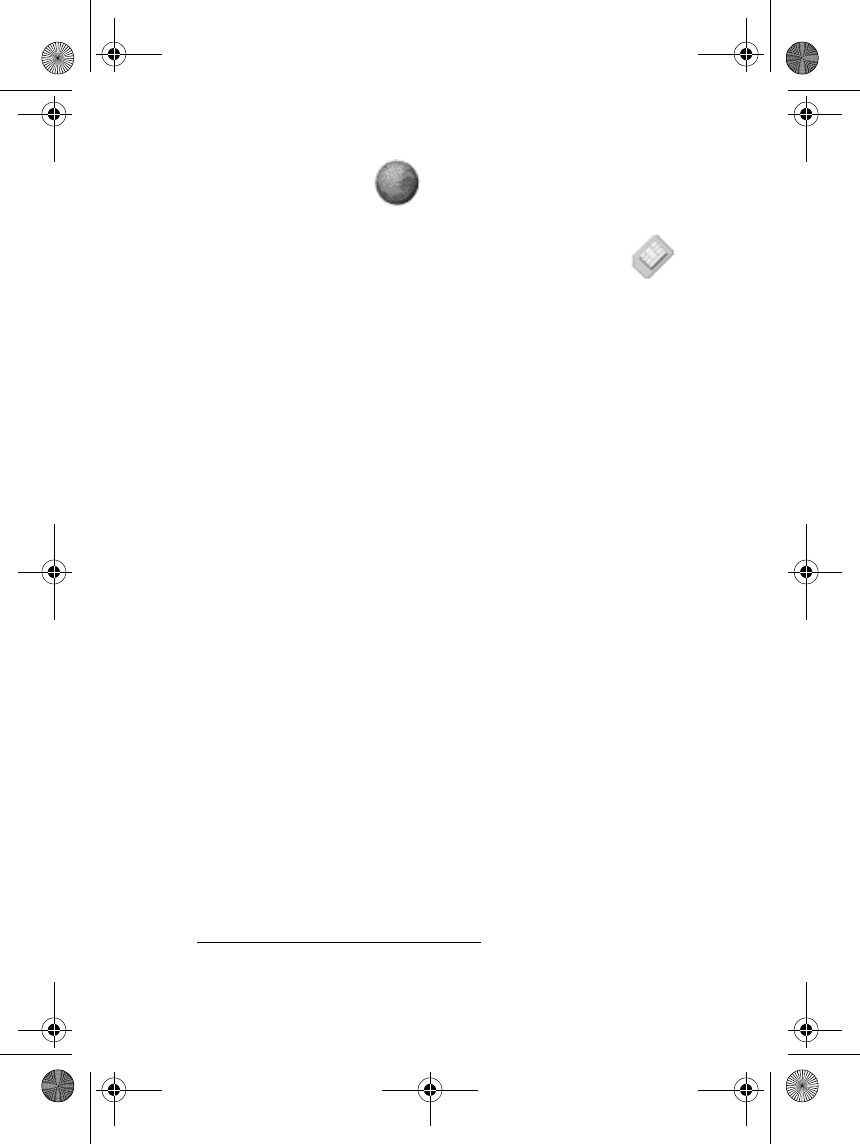
Using the menu
41
9. Services
1. Home
2. Bookmarks
3. Download links
4. Service inbox
5. Settings
6. Go to address
7. Clear the cache
10.SIM services1
1. Only shown if supported by your SIM card. The name and contents vary depend-
ing on the SIM card.
rm-2_en1_FCC.fm Page 41 Monday, February 16, 2004 8:14 AM

Menu functions
42
6. Menu functions
■Messages (Menu 1)
You can read, write, send and save text, multimedia,
and e-mail messages. All messages are organised in
folders.
Before you can send any text, picture or text (SMS) e-mail messages,
you need to save your message centre number, see Message settings on
page 62.
Text messages (SMS)
Using SMS (Short Message Service), your phone can send and receive
multi-part messages which consist of several ordinary text messages
(network service). This may affect the invoicing of the messages.
You can also send and receive text messages that contain pictures.
The text messages function uses shared memory, see Shared memory on
page 15.
Note: The picture message function can be used only if it is supported
by your network operator or service provider. Only phones that offer
picture message features can receive and display picture messages.
Writing and sending messages
The number of available characters and the current part number of a
multi-part message are shown on the top right of the display, for
example 120/2. Special (Unicode) characters, such as á, may take up
more space in the message than other characters.
1. Press Menu and select Messages, Text messages and Create message.
Tip: To quickly start writing a message, move the joystick to
the left in standby mode.
2. Key in a message, see Writing text on page 34. Use a template to
insert text or a picture into the message, see Templates on page 45.
Each picture message comprises several text messages. Therefore,
sending one picture message may cost more than sending one text
message.
rm-2_en1_FCC.fm Page 42 Monday, February 16, 2004 8:14 AM
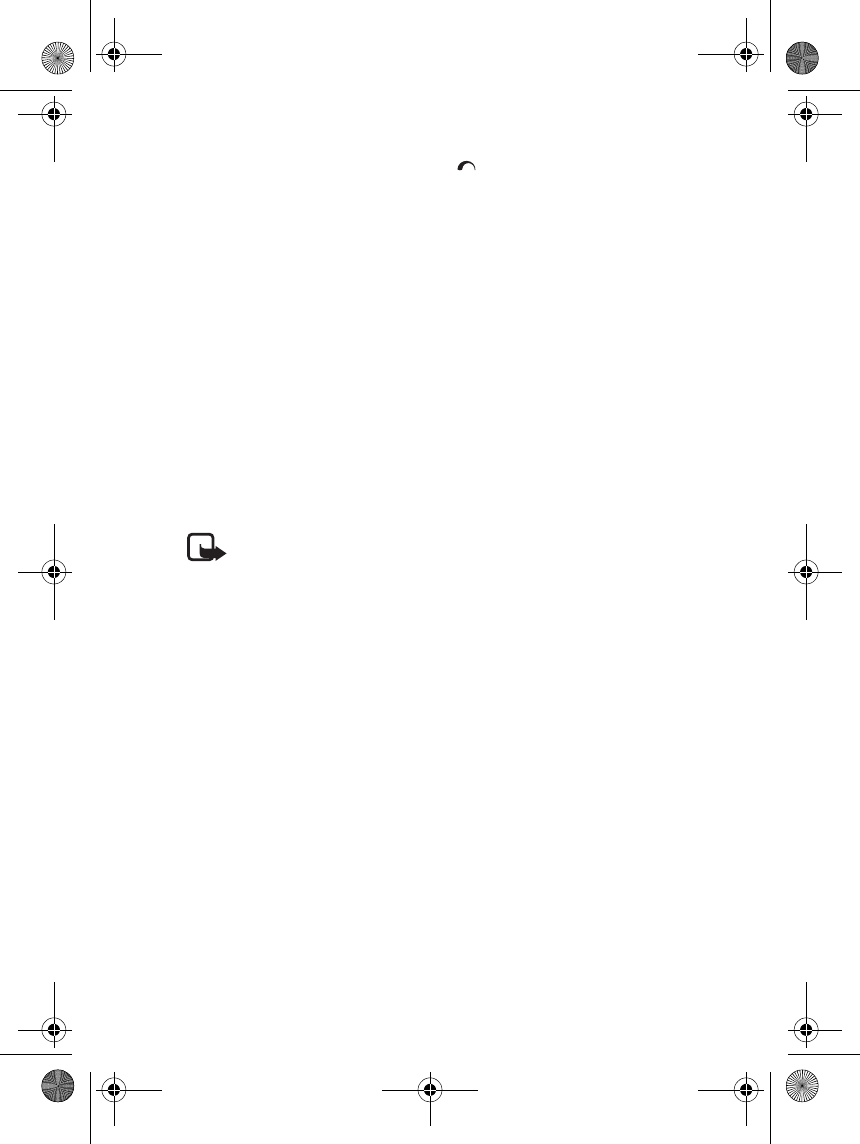
Menu functions
43
3. To send the message, press Send or .
4. Enter the recipient’s phone number or search for it in Contacts, and
press OK to send the message.
Options for sending a message
After you have written a message, press Options and select Sending
options.
• To send a message to several recipients, select Send to many. Select
the recipients one by one and press Send after each selection. When
you have sent the message to everyone you want to send it to, press
Done. Note that a separate message is sent to each recipient.
• To send a message using a distribution list, select Send to list. To
create a distribution list, see Distribution lists on page 46.
• To send a message using a message profile, select Sending profile and
the desired message profile. For defining a message profile, see
Message settings on page 62.
Note: When sending messages via the SMS network service, your phone
may display the words "Message sent". This is an indication that the
message has been sent by your phone to the message centre number
programmed into your phone. This is not an indication that the message
has been received at the intended destination. For more details about
SMS services, check with your service provider.
Writing and sending e-mail via SMS
Before you can send an e-mail via SMS, you need to save the settings for
sending e-mail, see Message settings on page 62. For availability and
subscription to the e-mail service, contact your network operator or
service provider. To save an e-mail address in Contacts, see Saving
multiple numbers and text items per name on page 70.
1. Press Menu, and select Messages, Text messages and Create SMS e-
mail.
2. Key in the recipient’s e-mail address or search for it in Contacts and
press OK.
3. If you wish, you can key in a subject for the e-mail and press OK.
4. Key in the e-mail message. See Writing text on page 34. The total
number of characters that you can key in is shown on the top right of
rm-2_en1_FCC.fm Page 43 Monday, February 16, 2004 8:14 AM
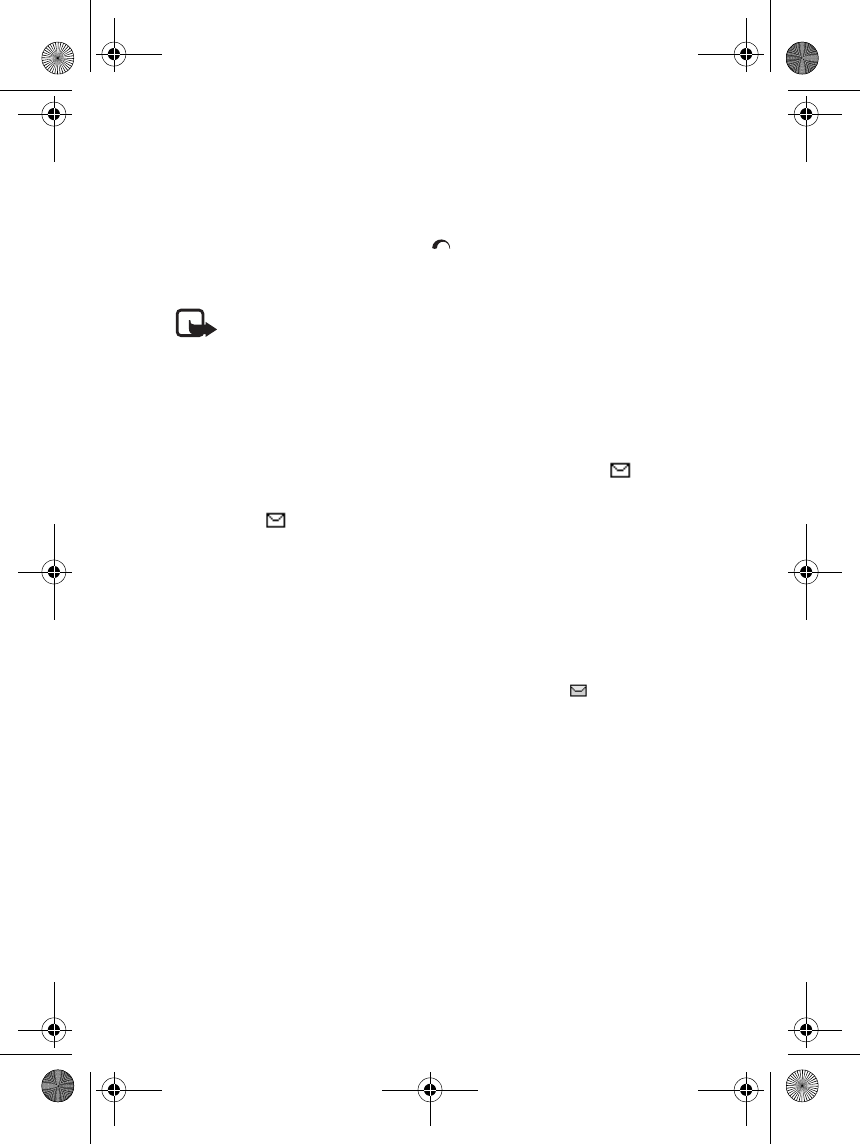
Menu functions
44
the display. The e-mail address and subject are included in the total
number of characters.
See also Templates on page 45. Pictures cannot be inserted.
5. To send the e-mail, press Send or . If you have not saved the
settings for sending e-mails, the phone requests the number of the
e-mail server. Press OK to send the e-mail.
Note: When sending e-mails via the SMS network service, your phone
may display the words Message sent. This is an indication that the e-
mail has been sent by your phone to the e-mail server. This is not an
indication that the e-mail has been received at the intended
destination. For more details about e-mail services, check with your
service provider.
Reading and replying to an SMS message or an SMS e-mail
When you have received a message or an e-mail, the indicator and
the number of new messages followed by messages received are shown.
The blinking indicates that the message memory is full. Before you
can receive new messages, delete some of your old messages from the
Inbox folder.
1. Press Show to view the new message, or press Exit to view it later.
Reading the message later:
Press Menu, select Messages, Text messages and Inbox.
2. If more than one message has been received, select the one that you
want to read. An unread text message is indicated by in front of
it.
3. While reading or viewing the message, press Options.
You can select an option, for example, to delete, forward or edit the
message as a text message or an e-mail, rename the message you are
reading or move it to another folder.
Select Copy to calendar to copy text from the beginning of the
message to your phone’s calendar as a memo for the current day.
Select Message details to view, if available, the sender’s name and
phone number, the message centre used, and the date and time of
receipt.
rm-2_en1_FCC.fm Page 44 Monday, February 16, 2004 8:14 AM

Menu functions
45
Select Use detail to extract numbers, e-mail and website addresses
from the current message.
When viewing a picture message, select Save picture to save the
picture in the Templates folder.
4. Press Reply to reply to a message. Select Original text to include the
original message in the reply, or select a standard answer to be
included in the reply, or select Empty screen.
When replying to an e-mail, confirm or edit the e-mail address and
subject first. Then write your reply message.
5. Press Send or to send the message to the displayed number.
Inbox and sent items folders
The phone saves incoming text messages in the Inbox folder and sent
messages in the Sent items folder of the Text messages submenu.
Text messages that you wish to send later can be saved in the Saved
items or Templates folder, or in any folder you have created.
Archive folder and my folders
To organise your messages, you can move some of them to the Saved
items folder, or add new folders for your messages.
While reading a message, press Options. Select Move, scroll to the
folder to which you want to move the message and press Select.
To add or delete a folder, press Menu, select Messages, Text messages
and My folders.
• To add a folder, press Options and select Add folder. If you have not
saved any folders, press Add to create one.
• To delete a folder, scroll to the folder that you want to delete, press
Options and select Delete folder.
Templates
Your phone includes text templates, indicated by , and picture
templates, indicated by .
To access the template list, press Menu and select Messages, Text
messages and Templates.
rm-2_en1_FCC.fm Page 45 Monday, February 16, 2004 8:14 AM
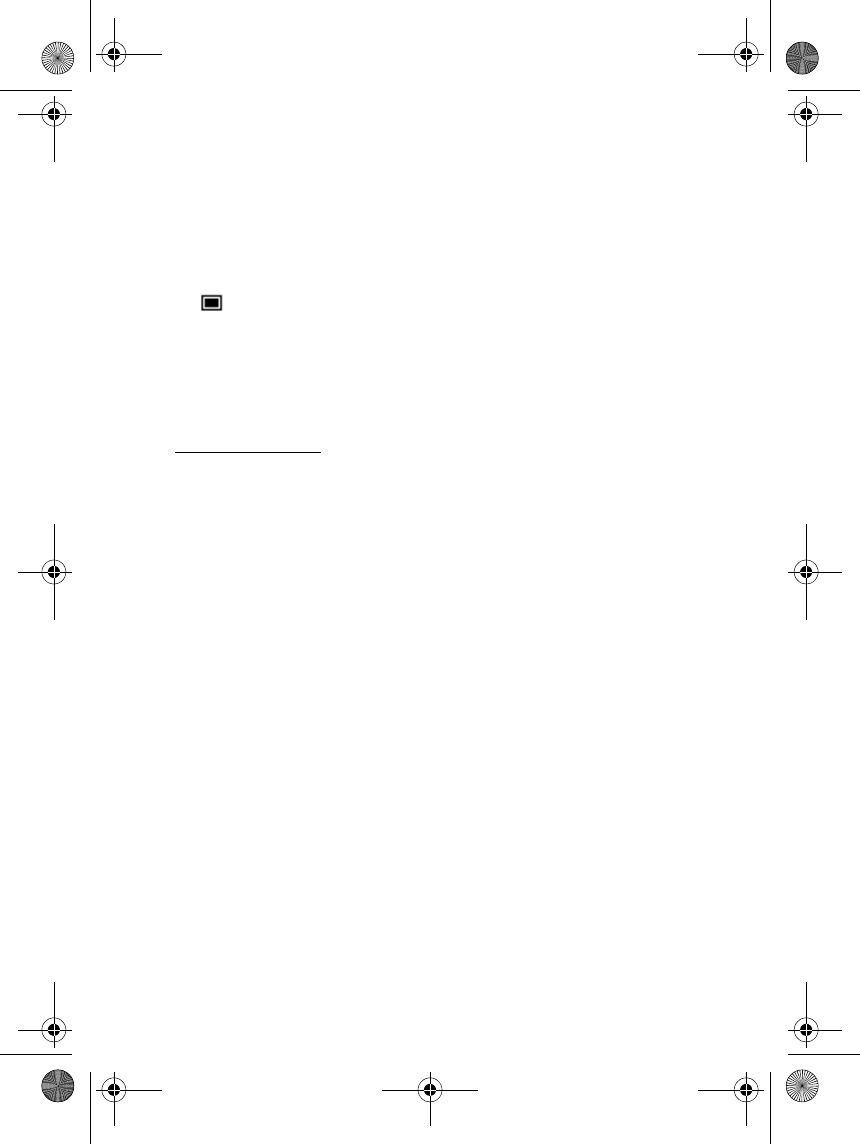
Menu functions
46
• To insert a text template into a message or an e-mail that you are
writing or replying to, press Options. Select Use template and select
the template that you want to insert.
• To insert a picture into a text message that you are writing or
replying to, press Options. Select Insert picture and select a picture
to view it. Press Insert to insert the picture into your message. The
indicator in the header of the message indicates that a picture
has been attached. The number of characters that you can include in
a message depends on the size of the picture.
To view the text and the picture together before sending the
message, press Options and select Preview.
Distribution lists
If you need to send messages frequently to a fixed group of people, you
can define a distribution list for that purpose. You can save to the
distribution lists contacts stored both in the phone’s and in the SIM
card’s memory. Note that the phone sends the message separately to
each recipient on the list. Therefore, sending a message using a
distribution list may cost more than sending a message to one recipient.
Make sure that the contacts that you want to add to the distribution
lists are saved in the phone’s internal contact memory.
Distribution lists use shared memory, see Shared memory on page 15.
1. Press Menu in standby mode, and select Messages, Text messages
and Distribution lists.
2. To create a new list, press Add if there are no distribution lists, or
press Options and select Add list if you have already created
distribution lists.
To view the names on a list, scroll to the desired list and press View.
To rename a list, clear it or delete it, press Options, and select the
appropriate function.
3. If you opened a distribution list by pressing View in step 2, you can
do one of the following:
• To add a new name to the list, press Add and select the desired
name from Contacts.
rm-2_en1_FCC.fm Page 46 Monday, February 16, 2004 8:14 AM

Menu functions
47
• To view the contact information of a recipient, scroll to the
desired name, press Options and select View details.
• To delete a recipient from the list, scroll to the desired name,
press Options and select Delete contact.
If the message fails to be sent to certain recipients on the distribution
list, failed messages are listed in the Undelivered folder. Press Resend to
send the message again, or press Options and select Delete list to delete
the Undelivered list or View message.
Text message counter
Text message counter shows the number of received and sent text and
picture messages. Picture messages may consist of more than one
message. You can, for example, view the recipient or sender of the
message or view the details of the message.
Multimedia messages
Note: This function can be used only if it is supported by your network
operator or service provider. Only phones that offer compatible
multimedia message features can receive and display multimedia
messages.
A multimedia message can contain text, one image, one sound clip, one
video clip or slides. The phone supports multimedia messages that are
up to 100 kB in size. If the maximum size is exceeded, the phone may
not be able to receive the message. Depending on the network, you may
receive a text message that includes an Internet address where you can
view the multimedia message on the PC.
If the message contains an image, the phone may scale it down to fit the
display area.
The multimedia function uses shared memory, see Shared memory on
page 15.
Copyright protections may prevent some images, ringing tones or other
content from being copied, modified, transferred or forwarded.
Note: If Allow multimedia reception is set to Yes or In home network,
your operator or service provider may charge you for every message you
receive.
rm-2_en1_FCC.fm Page 47 Monday, February 16, 2004 8:14 AM
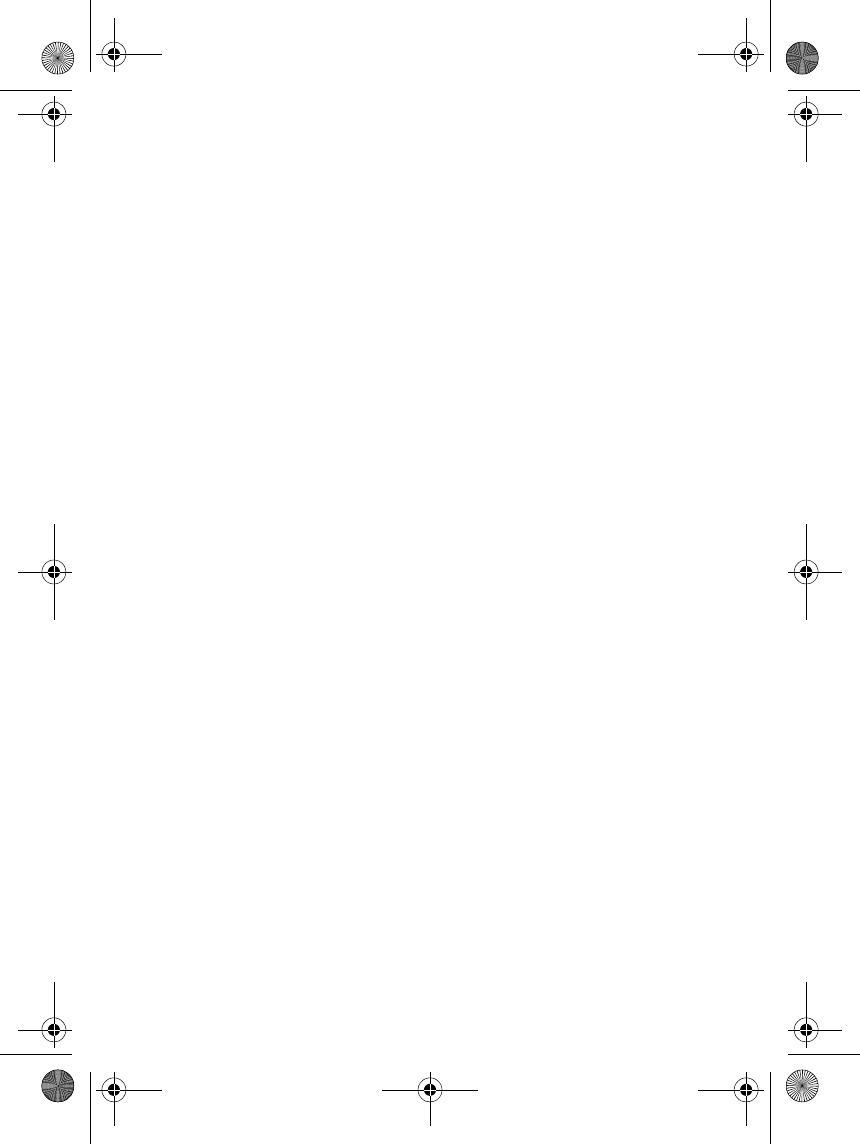
Menu functions
48
Multimedia messaging supports the following formats:
• Image: JPEG, GIF, WBMP, BMP, PNG and OTA-BMP
• Sound: Scalable Polyphonic MIDI (SP-MIDI), AMR audio and
monophonic ringing tones
• Video clips in H.263 format with SubQCIF image size and AMR audio.
The phone does not necessarily support all variations of the
aforementioned file formats. If a received message contains any
unsupported elements, they may be replaced with the file name and the
text Object format not supported.
Note that you cannot receive any multimedia messages if you have a
call in progress, a game or another Java application running, or an active
browsing session over GSM data (see Keying in the service settings
manually on page 114). Because delivery of multimedia messages can
fail for a variety of reasons, do not rely solely upon them for essential
communications.
Writing and sending a multimedia message
For defining the settings for multimedia messaging, see Settings for
multimedia messages on page 63. For availability and subscription to
the multimedia messaging service, contact your network operator or
service provider.
1. Press Menu and select Messages, Multimedia msgs. and Create
message.
2. Key in a message, see Writing text on page 34.
• To insert a file into the message, press Options, select Insert and
select the desired option. The list of available folders in the
Gallery menu is shown. Open the specific folder, scroll to the
desired file, press Options and select Insert. An attached file is
indicated by the file name in the message.
• Your phone supports the sending and receiving of multimedia
messages that contain several pages (‘slides’). To insert a slide
into the message, press Options, select Insert and Slide. Each
slide can contain text, one image, one video clip and one sound
clip.
rm-2_en1_FCC.fm Page 48 Monday, February 16, 2004 8:14 AM
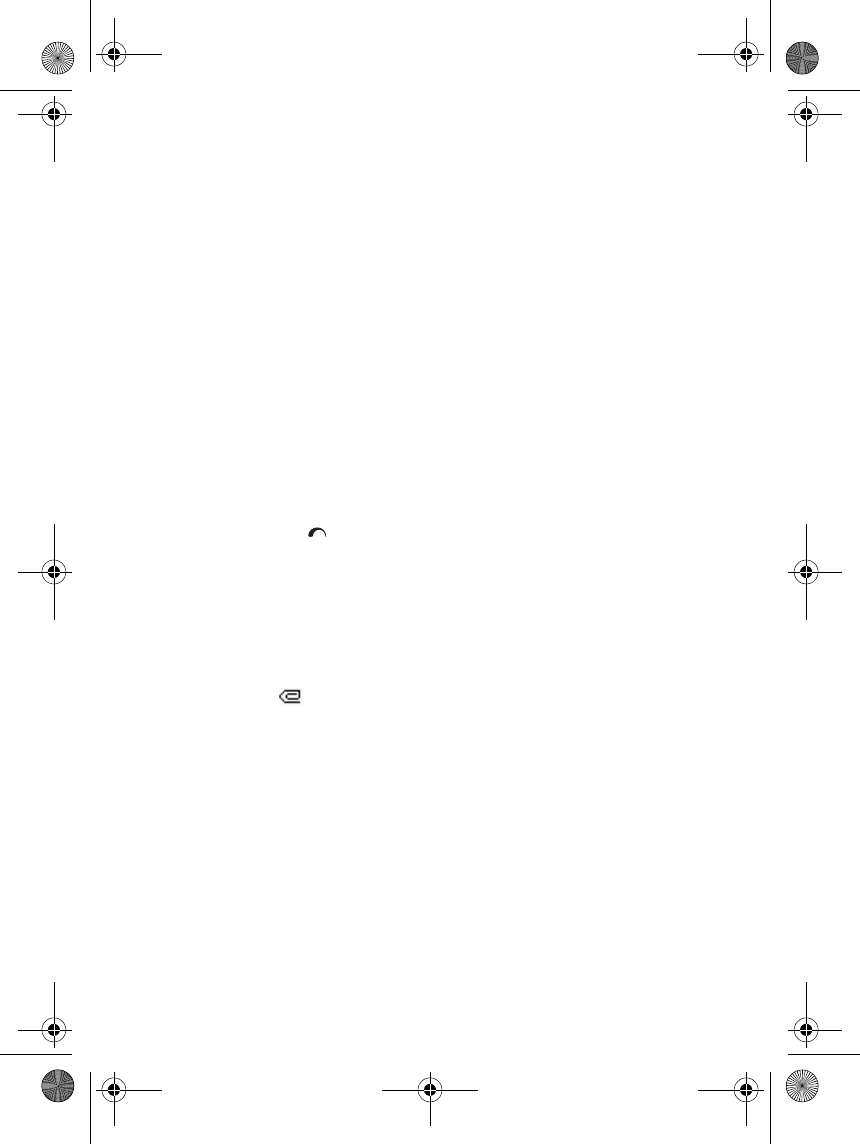
Menu functions
49
• If the message contains several slides, you can open the desired
one by pressing Options and selecting Previous slide, Next slide or
Slide list.
• To set the interval between the slides, press Options and select
Slide timing.
• To move the text part to the top or bottom of the message, press
Options and select Text on top or Text on bottom.
• To insert a name from Contacts, press Options, select More
options, Insert contact and scroll to the desired name and select
it.
• To insert a number, press Options, select More options and Insert
number. Key in the number or search for it in Contacts and press
OK.
3. To view the message before sending it, press Options and select
Preview.
4. Press Send or to send the message, or press Options and select
Send to e-mail or Send to many.
5. Enter the recipient’s phone number (or e-mail address) or search for
it in Contacts. Press OK and the message is moved to the Outbox
folder for sending.
It takes more time to send a multimedia message than a text
message. While the multimedia message is being sent, the animated
indicator is displayed and you can use other functions on the
phone. If there is an interruption while the message is being sent, the
phone tries to resend it a few times. If this fails, the message will
remain in the Outbox folder and you can try to resend it later.
The messages that you have sent will be saved in the Sent items
folder if the setting Save sent messages is set to Yes, see Settings for
multimedia messages on page 63. The fact that a message is sent is
not an indication that the message has been received at the intended
destination.
rm-2_en1_FCC.fm Page 49 Monday, February 16, 2004 8:14 AM
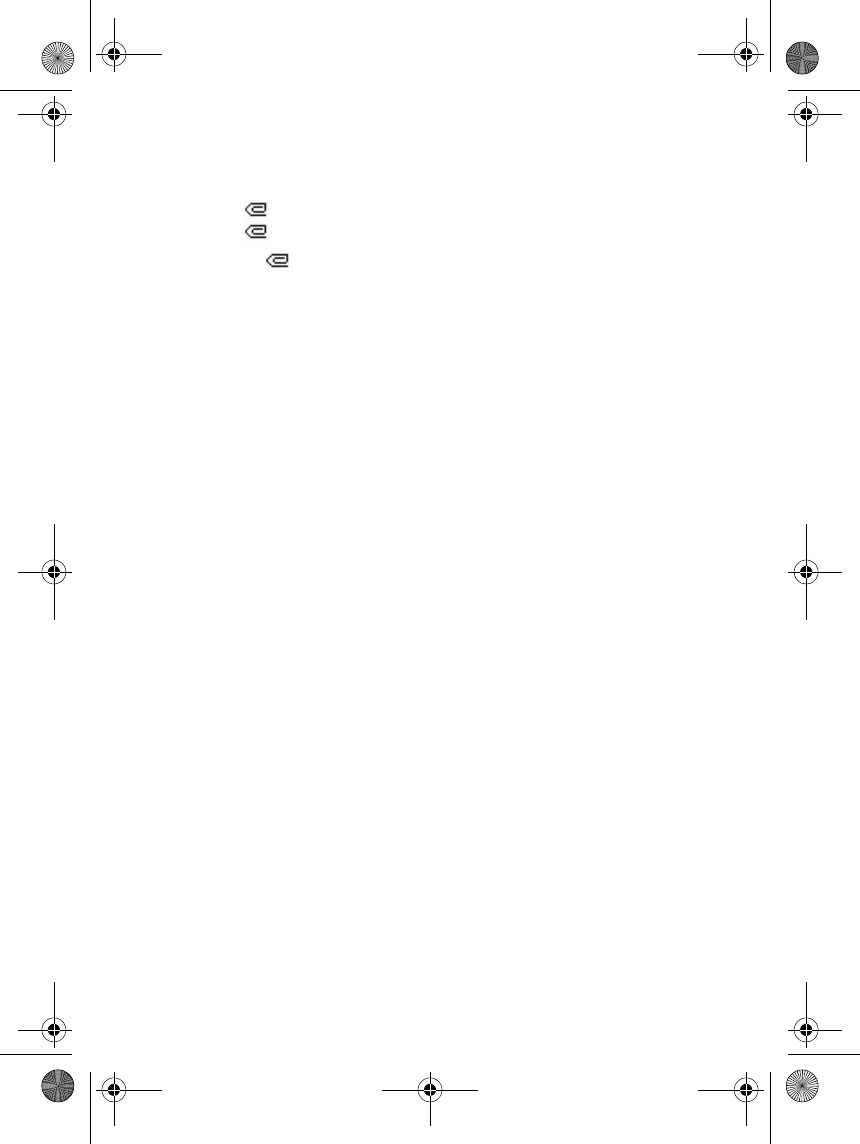
Menu functions
50
Reading and replying to a multimedia message
When your phone is receiving a multimedia message, the animated
indicator is displayed. When the message has been received, the
indicator and the text Multimedia message received are shown.
The blinking indicates that the memory for multimedia messages is
full, see Multimedia messages memory full on page 51.
The multimedia message function uses shared memory, see Shared
memory on page 15.
1. Press Show to view the message, or press Exit to view it later.
Reading the message later: Press Menu and select Messages,
Multimedia msgs. and Inbox. Scroll to view the message.
2. Press Select to view the message. The function of the middle
selection key changes according to the displayed object.
• To reply to the message, press Reply.
• To delete an object contained in the message, press Delete.
Otherwise, press Options and select Delete message.
• if the received message contains a presentation, press Play to
view the message.
Otherwise, press Play to listen to a sound clip or view the video
clip contained in the message, or press Zoom to zoom in on an
attached image or press View to view a business card or a
calendar note.
If you press Options, some of the following options are available:
•Delete message to delete a saved message.
•Reply or Reply to all to reply to the message. To send the reply, see
Writing and sending a multimedia message on page 48.
•Use detail to extract phone numbers, e-mail or web addresses
from the current message.
•Forward to no., Forward to e-mail or Send to many to forward the
message.
•Edit to edit a message that you have written. See Writing and
sending a multimedia message on page 48.
rm-2_en1_FCC.fm Page 50 Monday, February 16, 2004 8:14 AM
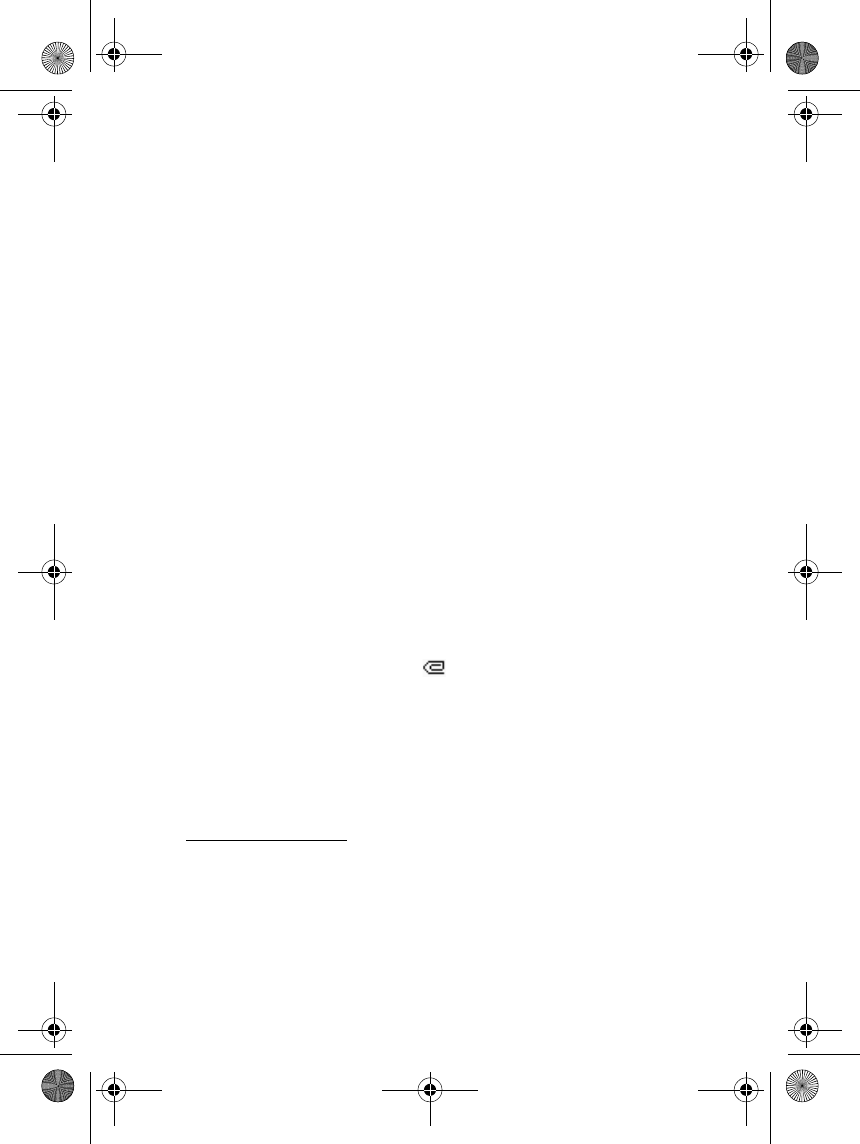
Menu functions
51
•Message details to view the subject, size and class of the
message.
•Play presentation to view the presentation contained in the
message.
•Open calend. note or Open bus. card to view a calendar note or a
business card.
See also the options in Gallery, see Gallery (Menu 5) on page 94.
Inbox, Outbox, Saved and Sent items folders
The phone saves the multimedia messages that have been received in
the Inbox folder of the Multimedia msgs. submenu.
Multimedia messages that have not yet been sent are moved to the
Outbox folder of the Multimedia msgs. submenu.
The multimedia messages that you wish to send later can be saved in the
Saved items folder of the Multimedia msgs. submenu.
The multimedia messages that have been sent are saved in the Sent
items folder of the Multimedia msgs. submenu, if the setting Save sent
messages is set to Yes, see Settings for multimedia messages on page
63.
Multimedia messages memory full
When you have a new multimedia message waiting and the memory for
the messages is full, the indicator blinks and Multimedia memory
full, view waiting msg. is shown. To view the waiting message, press
Show. To save the message, press Save and delete old messages by first
selecting the folder and then the message to be deleted.
To discard the waiting message, press Exit and Yes. If you press No, you
can view the message.
Deleting messages
• To delete text messages, press Menu and select Messages, Text
messages and Delete messages.
To delete all messages from all folders, select All messages and when
Delete all messages from all folders? is displayed, press Yes. If the
rm-2_en1_FCC.fm Page 51 Monday, February 16, 2004 8:14 AM
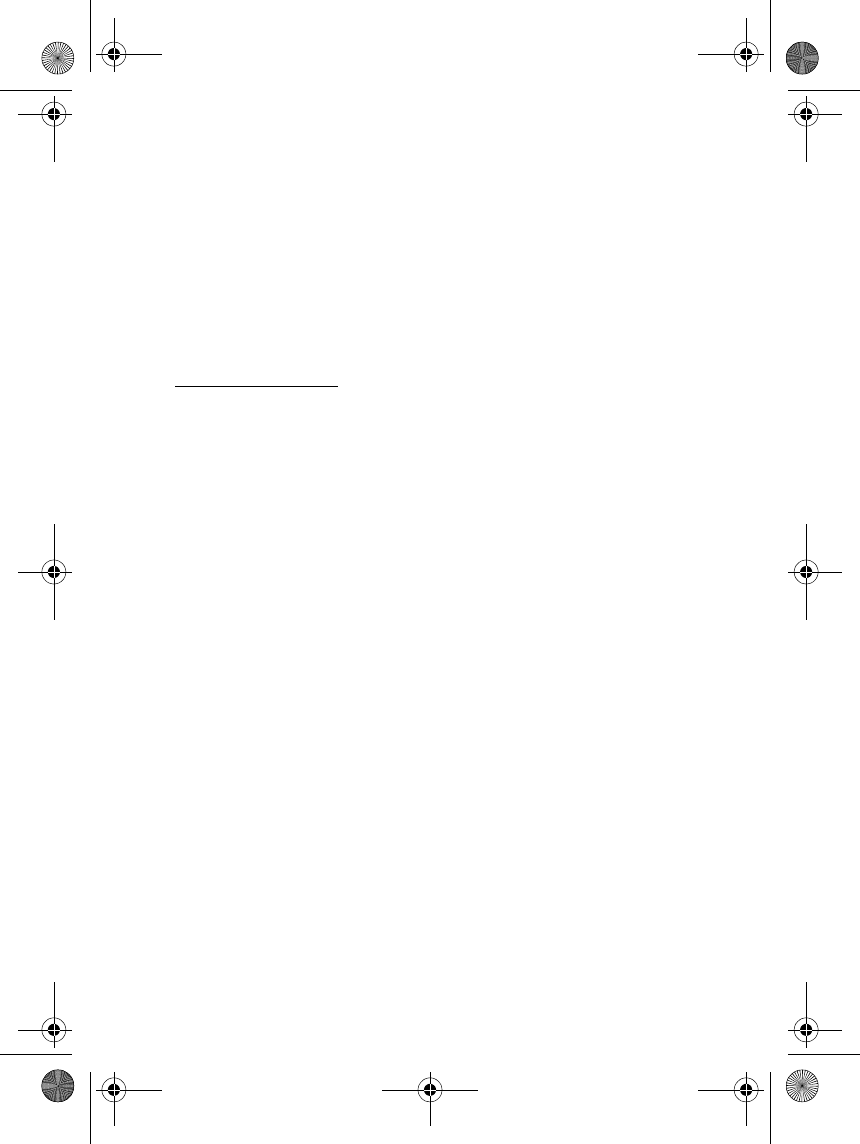
Menu functions
52
folders contain unread messages, the phone will ask whether you
want to delete them also.
To delete multimedia messages, press Menu and select Messages,
Multimedia msgs. and Delete messages.
• To delete all messages from a folder, select the folder from which you
want to delete the messages and press Yes. If the folder contains
unread messages, the phone will ask whether you want to delete
them also.
E-mail application
The e-mail application allows you to access your e-mail account via the
phone. The compatible e-mail system that you use in the office or at
home may be supported by the e-mail function on your phone. You can
write, send, and read e-mails with your phone. Your phone supports
POP3 and IMAP4 e-mail servers.
The e-mail function uses shared memory, see Shared memory on page
15.
Before you can send and retrieve any e-mails, you may need to do the
following:
• Obtain a new e-mail account or use the current one. To check the
availability of your e-mail account, contact your e-mail service
provider.
• For the settings required for e-mail, contact your network operator
or e-mail service provider. For receiving the e-mail settings over the
air, see Over-the-air settings service on page 28.
• To set the e-mail settings on your phone, press Menu and select
Messages, Message settings and E-mail messages. See Settings for
the e-mail application on page 64.
Writing and sending messages with the e-mail application
You can write your e-mail message before connecting to the e-mail
service, or connect to the service first, and then write and send your e-
mail.
1. Press Menu and select Messages, E-mail, and Create e-mail.
rm-2_en1_FCC.fm Page 52 Monday, February 16, 2004 8:14 AM
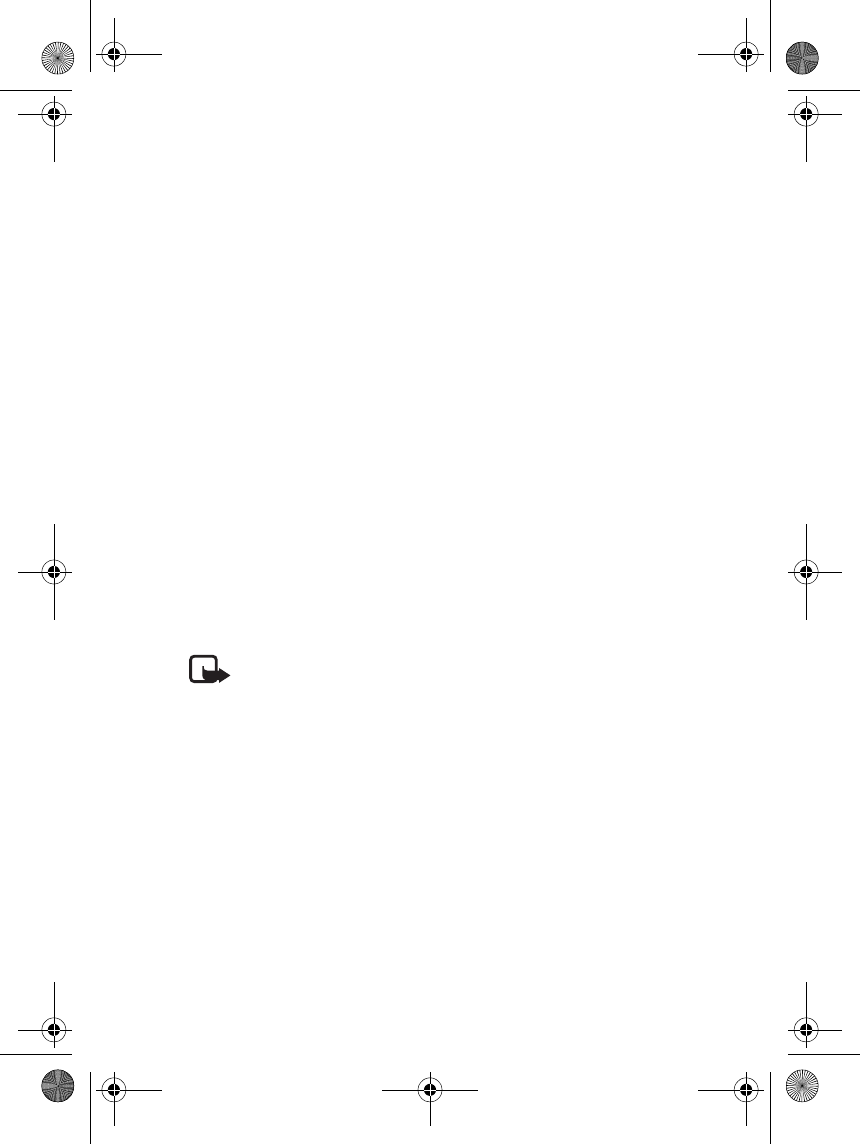
Menu functions
53
2. Key in the recipient’s e-mail address and press OK or press Edit and
key in the e-mail address, and press OK.
To search for the e-mail address in Contacts, press Options, and
select Search.
3. You can key in a subject for the e-mail if you want, and press OK.
If you press Options, you can select one of the following: the
message editor, add a new recipient, add a copy recipient or a hidden
copy recipient.
4. Press Options and select Message editor. Key in the e-mail message,
see Writing text on page 34. The number of characters that you can
key in is shown on the top right corner of the display.
5. To send the e-mail message, press Send. Select
•Send now to send the e-mail immediately. If you have not already
connected to the e-mail account, your phone establishes the
connection first and then sends the e-mail.
•Send later to send your e-mail later and the e-mail is saved in the
Outbox folder. If you want to edit or continue writing your e-mail
later, you can save it in Drafts by selecting Save draft msg..
Sending the e-mail later: Press Menu and select Messages, E-
mail, Other options, and Send now or Retrieve and send.
Note: When sending e-mails, your phone may display the words
Message sent. This is an indication that the e-mail has been sent by
your phone to the e-mail server. This is not an indication that the e-
mail has been received at the intended destination. For more details
about e-mail services, check with your service provider.
Downloading messages from your e-mail account using the e-
mail application
1. Press Menu and select Messages, E-mail, and Retrieve to download
e-mail messages that have been sent to your e-mail account. Or:
Press Menu and select Messages, E-mail, Other options, and Retrieve
and send to download new e-mail messages and to send e-mails that
have been saved in the Outbox folder.
If the message memory is full, delete some of your older messages
before you start to download new messages.
rm-2_en1_FCC.fm Page 53 Monday, February 16, 2004 8:14 AM
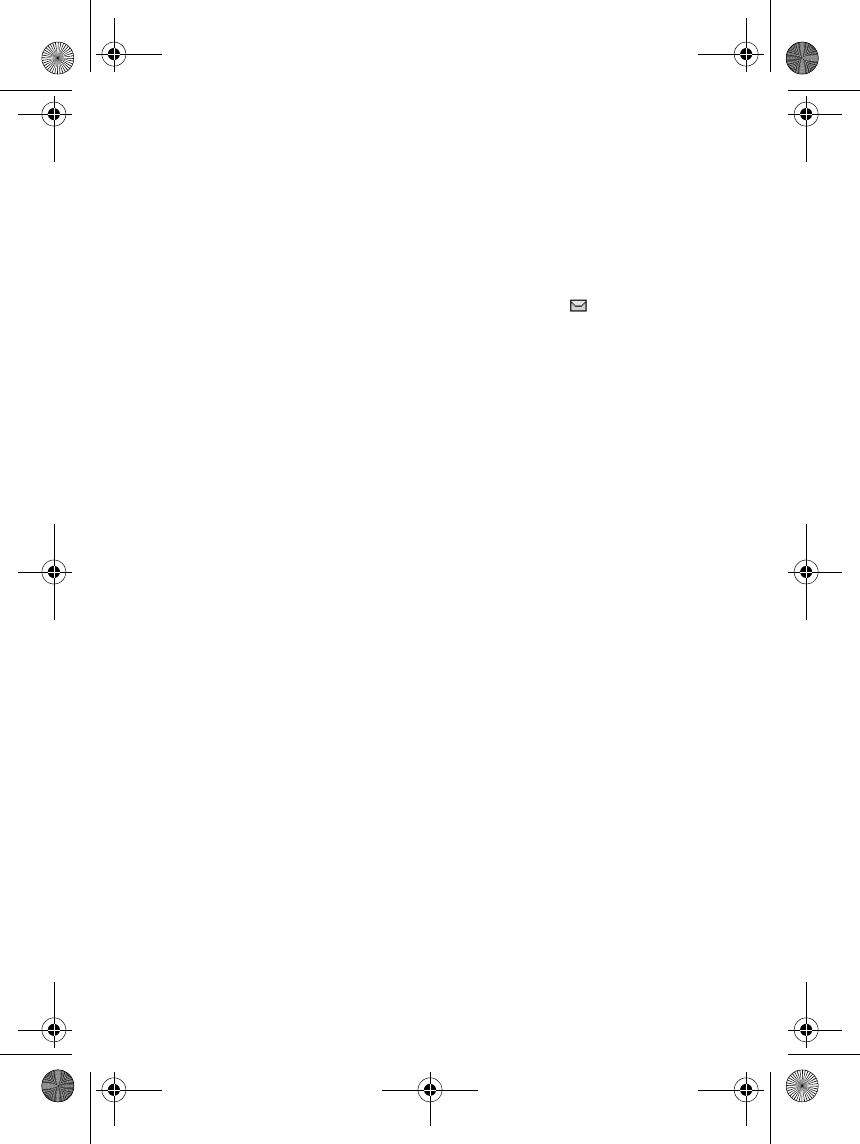
Menu functions
54
2. Your phone makes a connection to the e-mail service. A status bar is
shown while your phone is downloading e-mail messages to your
phone.
3. Press Select to view the new message in Inbox, or press Back to view
it later.
If more than one message is received, select the message that you
want to read. An unread text message is indicated by .
Reading and replying to a message with the e-mail application
1. Press Menu, select Messages, E-mail and Inbox.
2. While reading the message, press Options.
You can, for example, view the details of the selected message, mark
the message as unread, delete, reply, reply to all, forward or move the
message to another folder.
3. To reply to an e-mail, press Reply. Select Original text to include the
original message in the reply or select Empty screen.
When replying to an e-mail, write your reply and edit the e-mail
address and subject, if necessary.
4. To send the message, press Send and select Send now.
Inbox and Other folders (Drafts, Archive, Outbox and Sent
items)
Your phone has the following folders in the E-mail menu:
•Inbox for saving e-mails that you have downloaded from your e-mail
account.
•Other folders contains the folders: Drafts for saving unfinished e-
mails, Archive for organising and saving your e-mails, Outbox for
saving e-mails that have not been sent, if you have selected Send
later, see Writing and sending messages with the e-mail application
on page 52, and Sent items for saving e-mails that have been sent.
Deleting messages using the e-mail application
• To delete e-mail messages, press Menu and select Messages, E-mail,
Other options and Delete messages.
rm-2_en1_FCC.fm Page 54 Monday, February 16, 2004 8:14 AM
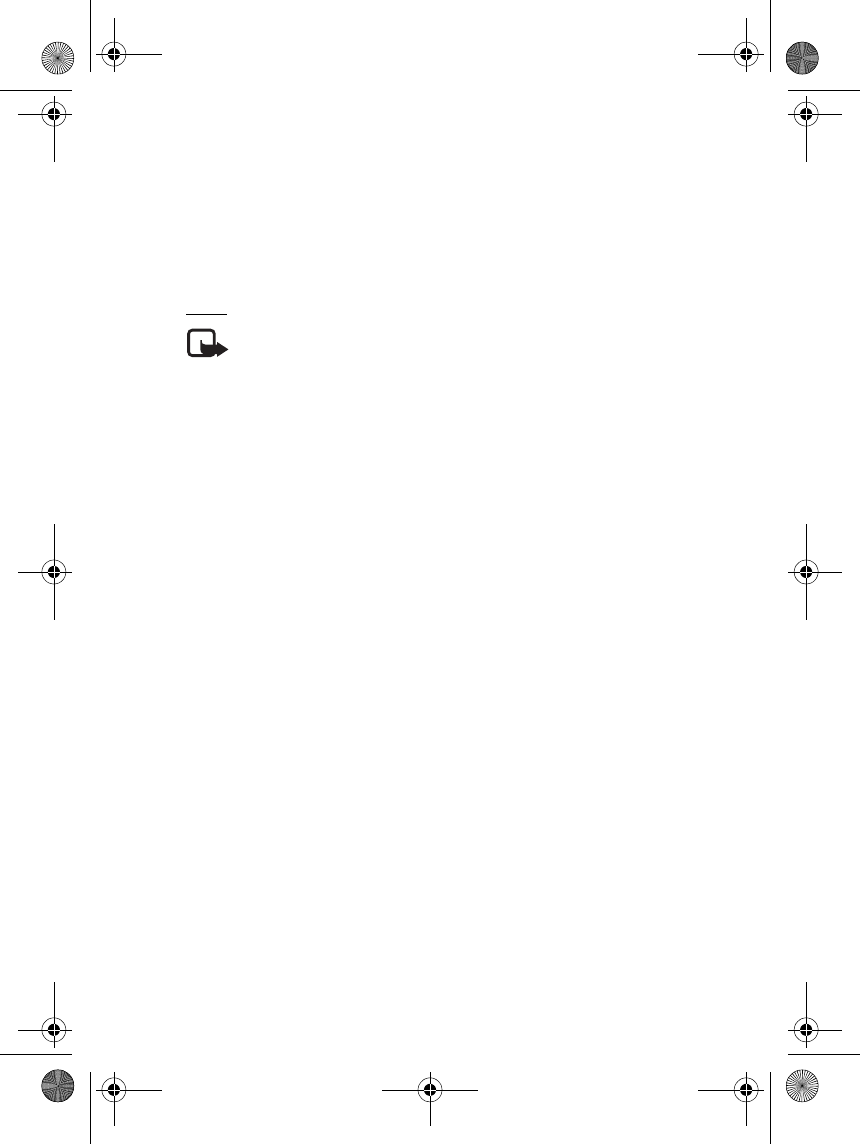
Menu functions
55
To delete all messages from a folder, select the folder from which you
want to delete the messages and press Yes. To delete all messages
from all folders, select All messages and press Yes.
Note that deleting an e-mail from your phone does not delete it from
the e-mail server.
Chat
Note: This function can be used only if it is supported by your network
operator or service provider. Only phones that offer compatible chat
features can receive and display chat messages.
Chat is a way of sending short text messages that are delivered over
TCP/IP protocols to online users (network service). Your contact list
shows you when the contacts on the list are online and available to
participate in a chat conversation. When you have written and sent your
message, it remains on the display. The reply message appears above
your original message.
Before you can use chat, you need to subscribe to the service. For
availability, charging and subscription to the service, contact your
network operator or service provider, from whom you also receive your
unique ID and password and the chat settings.
To set the required chat service settings, see Chat and my presence
settings on page 81.
You can use the other phone functions, while you have an active chat
session in the background. Depending on the network, the active chat
session may consume the phone’s battery faster and you may need to
connect the phone to a charger.
Chat uses shared memory, see Shared memory on page 15.
Basic steps for chat
• To enter the chat menu (offline), see Entering the chat menu on page
56.
• To connect to the chat service (online), see Connecting to and
disconnecting from the chat service on page 57.
• To start a chat session with a contact, see Chat contacts in Starting a
chat session on page 57.
rm-2_en1_FCC.fm Page 55 Monday, February 16, 2004 8:14 AM
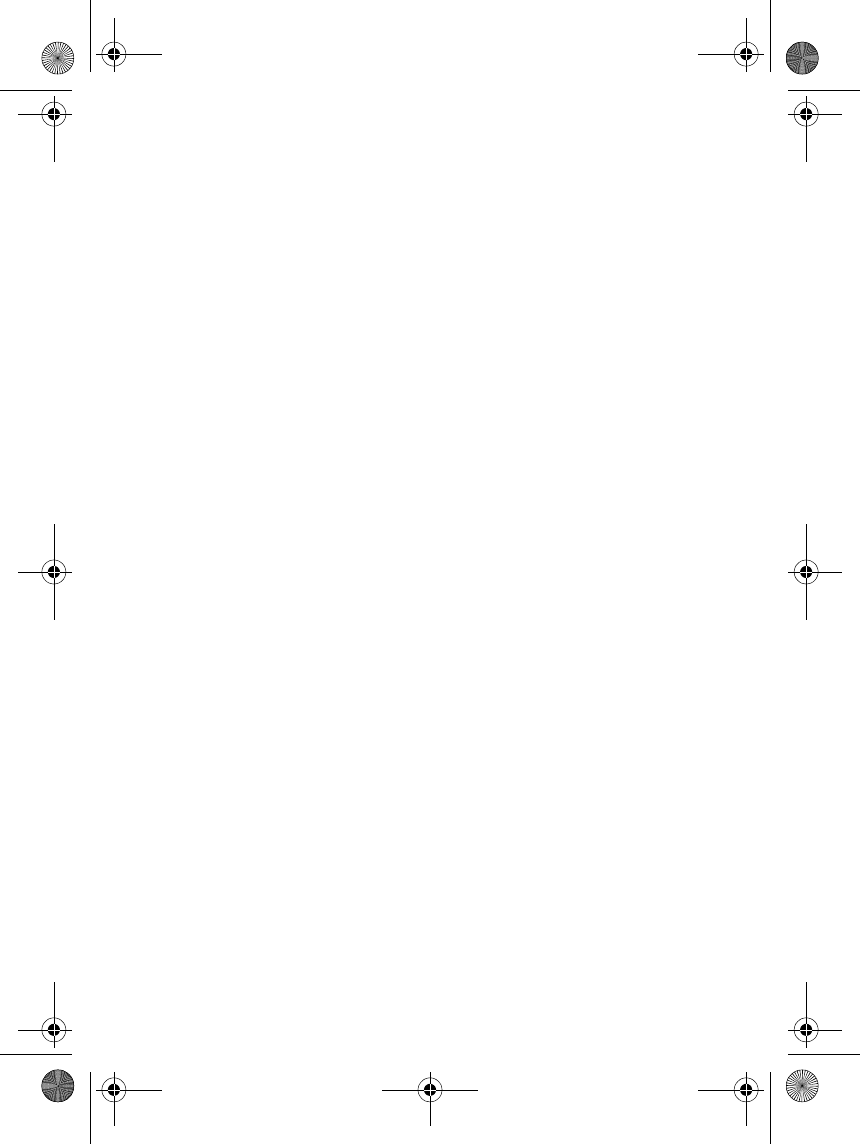
Menu functions
56
To create you own chat contact lists, see Contacts for the chat
session on page 60.
• To join a public chat session, see Groups in Starting a chat session on
page 57.
To join a group chat session via an invitation message, see Accepting
or rejecting a chat invitation on page 58.
To create your own chat groups, or to join or delete a public group,
see Groups on page 61.
• To edit your own information, see Editing your own information on
page 59.
• To search users and groups, see Search in Starting a chat session on
page 57.
• To read a message in a new chat session, see Reading a chat message
on page 58.
• To write and send messages during an active chat session, see
Participating in a chat conversation on page 59.
• To view, rename or delete saved conversations, select Saved convers.
when you have entered the Chat menu.
• To block/unblock contacts, see Blocking and unblocking messages on
page 60.
• To disconnect from the chat service, see Connecting to and
disconnecting from the chat service on page 57.
Entering the chat menu
To enter the Chat menu while still offline, press Menu, and select
Messages and Chat. You can select
•Login to connect to the chat service.
To set the phone to automatically connect to the chat service when
you enter the Chat menu, see Connecting to and disconnecting from
the chat service on page 57.
•Saved convers. to view, erase or rename the chat conversations that
you have saved during the chat session. You can select Saved
convers. also when you have connected to the chat service.
rm-2_en1_FCC.fm Page 56 Monday, February 16, 2004 8:14 AM
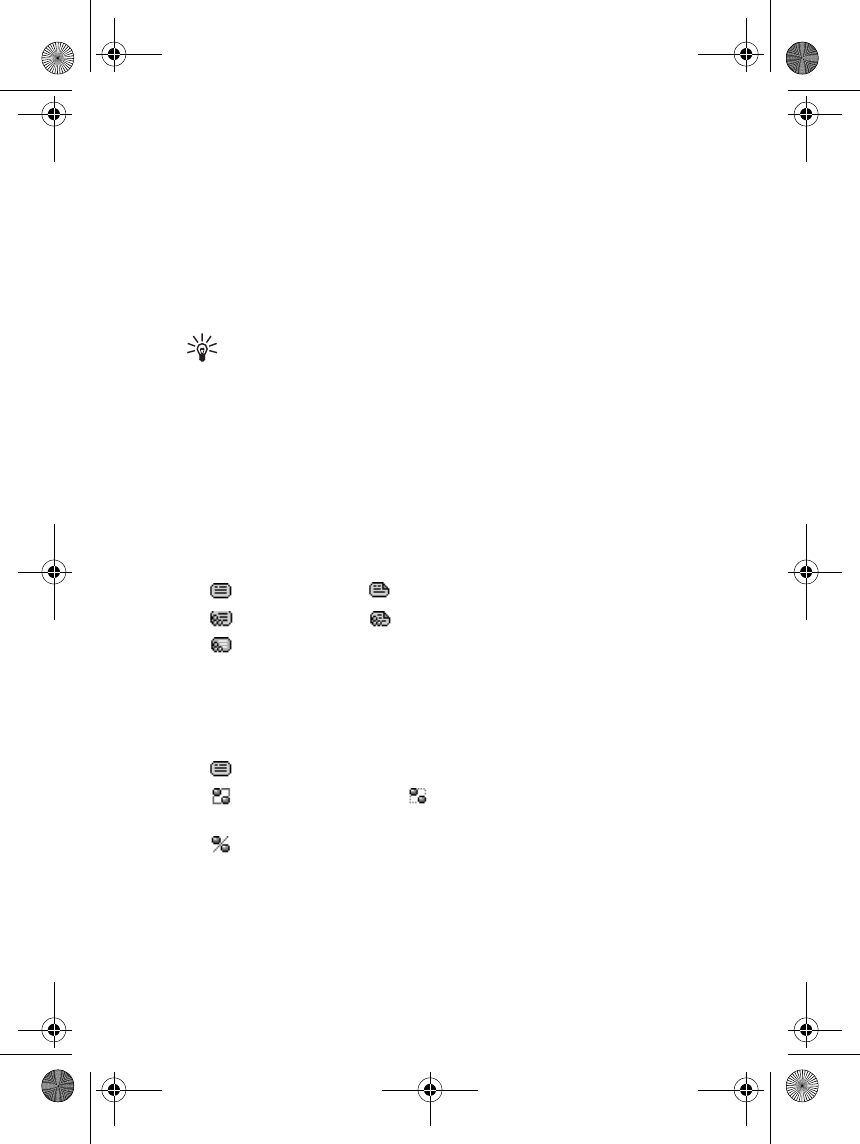
Menu functions
57
•Connect. settings to edit the settings needed for chat messaging and
presence connection. See Chat and my presence settings on page 81.
You can also select Connect. settings when you have connected to
the chat service.
Connecting to and disconnecting from the chat service
To connect to the chat service, enter the Chat menu, and select Login.
When the phone has successfully connected, Logged in is displayed.
Tip: To set the phone to automatically connect to the chat
service each time you enter the Chat menu, connect to the chat
service, select My settings, Automatic login and On Chat start-
up.
To disconnect from the chat service, select Logout.
Starting a chat session
Enter the Chat menu and connect to the chat service. You can select
•Conversations to view the list of new and read chats or invitations to
chats during the active chat session. Scroll to the message or
invitation that you want and press Open to read the message.
indicates new and read chat messages.
indicates new and read group messages.
indicates invitations.
•Chat contacts includes the contacts that you have added from the
phone’s contacts memory. Scroll to the contact with whom you
would like to chat and press Chat.
If you have received a new message from a contact, it is indicated by
.
indicates the online and the offline contacts in the phone’s
contacts memory.
indicates a blocked contact, see Blocking and unblocking
messages on page 60.
To add contacts to the list, see Contacts for the chat session on page
60.
•Groups and Public groups. The list of bookmarks to public groups
provided by the network operator or service provider is displayed. To
rm-2_en1_FCC.fm Page 57 Monday, February 16, 2004 8:14 AM

Menu functions
58
start a chat session with a group, scroll to a group and press Join.
Enter the screen name that you want to use in the conversation.
When you have successfully joined the group conversation, the
phone shows Joined group: and the group name. To create a private
group, see Groups on page 61.
•Search and select Users or Groups to search for other chat users or
public groups on the network.
• If you select Users, you can search for a user by phone number,
screen name, e-mail address or name.
• If you select Groups , you can search for a group by a group
member, group name, topic or ID.
To start the chat session when you have found the user or the group,
scroll to the user or the group that you want, press Options and
select Chat or Join group.
• To start a chat session from Contacts, see Viewing the subscribed
contacts on page 76.
Accepting or rejecting a chat invitation
In standby mode, when you have connected to the chat service and you
receive an invitation, New invitation received is displayed. Press Read to
read it.
If you receive more than one invitation, the number of messages
followed by new invitations received is displayed. Press Read, scroll to
the invitation you want, and press Open.
• To join the private group conversation, press Accept. Enter the screen
name that you want to use as a nickname. When you have
successfully joined the group, the phone shows Joined group: and the
group name.
• To reject or delete the invitation, press Options and select Reject or
Delete.
Reading a chat message
In standby mode, when you have connected to the chat service and you
receive a message from a person who is not taking part in the
conversation, New instant message is displayed. Press Read to read it.
rm-2_en1_FCC.fm Page 58 Monday, February 16, 2004 8:14 AM
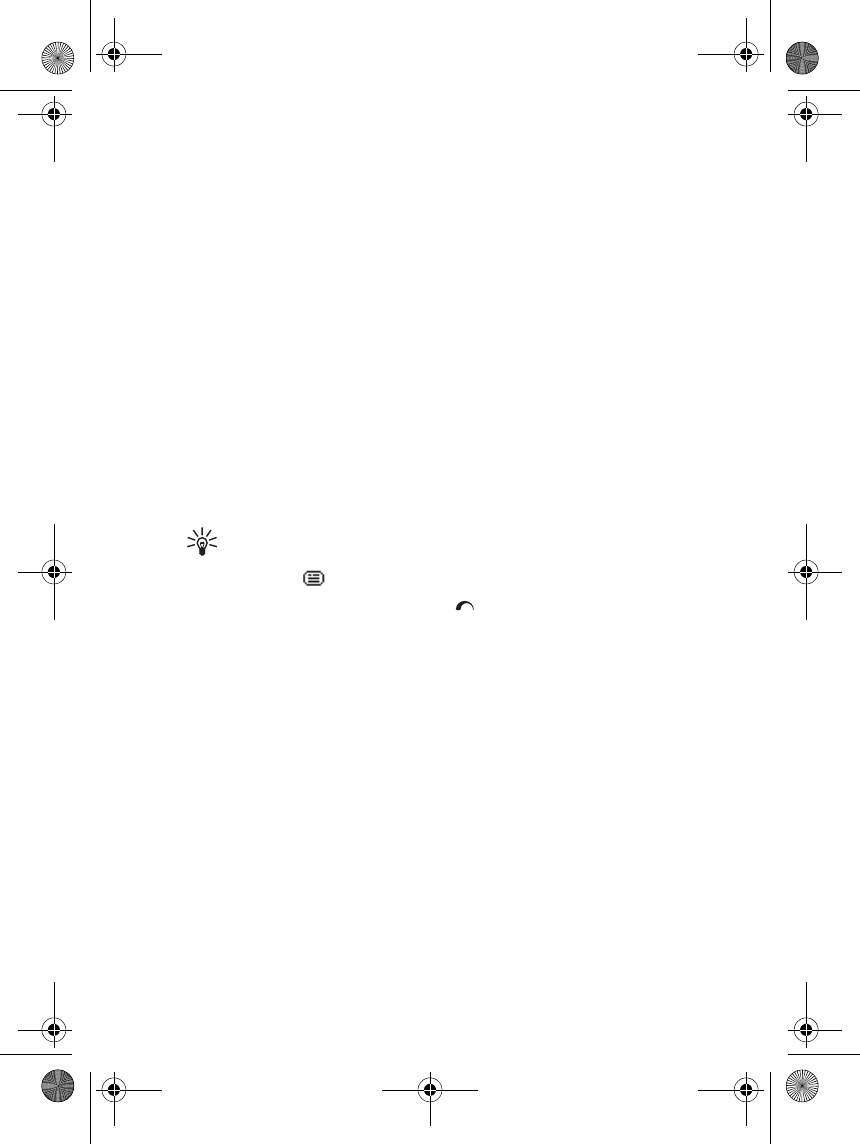
Menu functions
59
• If you receive more than one message, the number of messages
followed by new instant messages is displayed. Press Read, scroll to
the message, and press Open.
New messages received during an active chat session are held in the
Conversations of the Chat menu. If the message is from a person whose
contact information is missing from the contact list in Chat contacts,
the sender’s ID is shown. If the contact information can be found in the
phone’s memory for contacts and the phone recognises it, the sender’s
name is shown. To save a new contact in the phone’s memory, press
Options and select
•Save contact and enter the name of the person.
•Add to contact and select the contact to which you want to add the
detail and press Add.
Participating in a chat conversation
Join or start a chat session by pressing Write.
Tip: If you receive a new message during a chat session from a
person who is not participating in the current chat session, the
indicator is shown on the top of the display.
Write your message and press Send or to send it. If you press
Options, some of the following options are available.
•View conversation to view the ongoing chat conversation. To save
the chat conversation, press Save and enter the name for the
conversation.
•Save contact, see Reading a chat message on page 58.
•Add to contact, see Reading a chat message on page 58.
•Group members to view the members of the selected private group.
The option is only shown if you have created the group.
•End conversation to end the ongoing conversation.
•Dictionary, see Setting predictive text input on or off on page 35.
Editing your own information
Enter the Chat menu and connect to the chat service. Select My settings
to view or edit your own availability status or screen name. Select
Availability and either Available for all or Avail. for contacts (or Appear
rm-2_en1_FCC.fm Page 59 Monday, February 16, 2004 8:14 AM
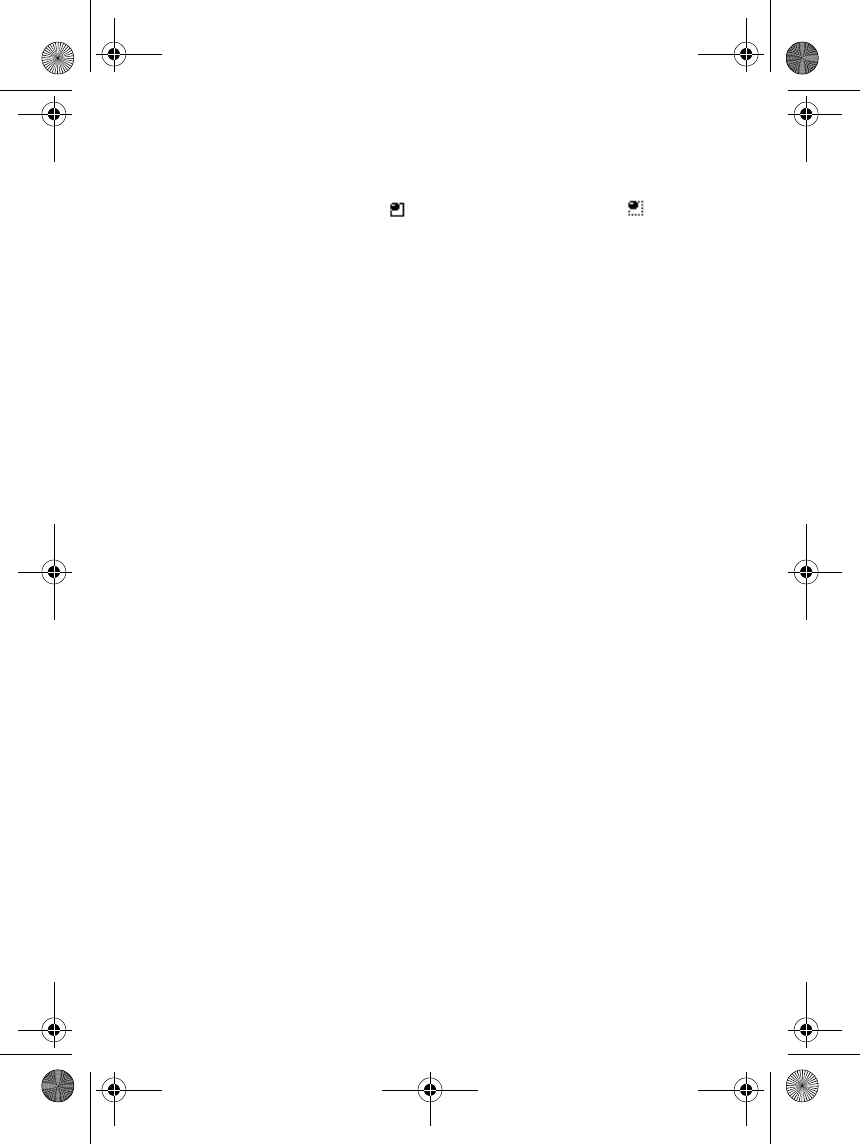
Menu functions
60
offline) to allow all chat users, or only the contacts on your chat contact
list to see whether you are online or offline when you have connected to
the chat service. The indicator shows that you are online and
that your online status is not visible to others.
Contacts for the chat session
You can add contacts from the phone’s contacts memory to the chat
contacts list.
Connect to the chat service, select Chat contacts, press Options and
select
•Add contact, or if you have no contacts added, press Add. Select from
Contacts the name that you want to add to the list of chat contacts.
When the contact is added, the phone displays Added to Chat
contacts: and the contact name.
Scroll to a contact, and press Chat to start to chat, or press Options and
select
•Contact info to view the details of the selected contact. If you want
to edit the details, see Editing or deleting details in contacts in the
Contacts menu on page 73.
•Block contact (or Unblock contact) to block (or unblock) messages
from the selected contact.
•Add contact to add a new contact from the phone’s contact memory.
•Remove contact to remove a contact from the chat contact list.
Blocking and unblocking messages
Connect to the chat service and select Conversations or Chat contacts.
Highlight the contact in the contacts list from whom you want to block
incoming messages. Press Options, select Block contact and press OK.
To unblock messages, connect to the chat service and select Blocked list.
Scroll to the contact from whom you want to unblock the messages and
press Unblock.
You can also unblock messages from the contact list, see Contacts for
the chat session on page 60.
rm-2_en1_FCC.fm Page 60 Monday, February 16, 2004 8:14 AM
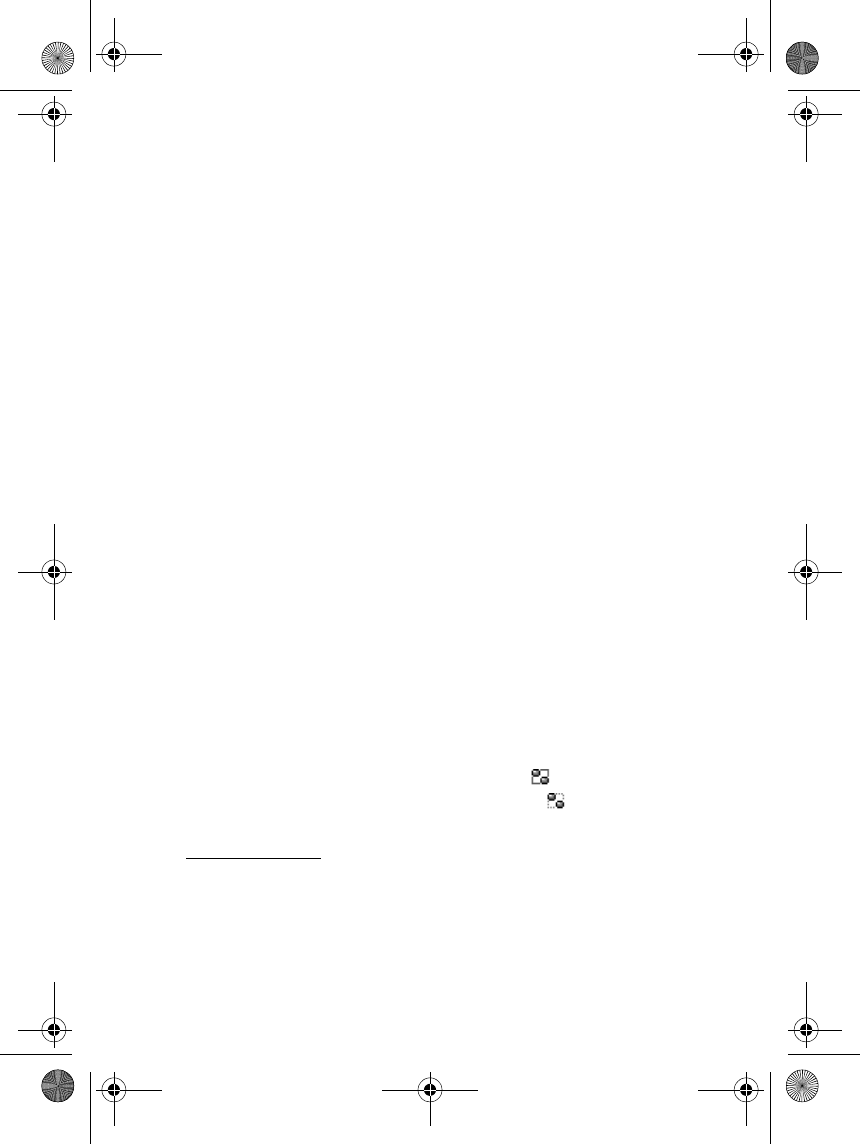
Menu functions
61
Groups
You can create your own private groups for a chat session, or use the
public groups provided by the service provider. The private groups exist
only during an active chat session. You can add to a private group only
the contacts that are in your contact list and thus in the phone’s
contacts memory, see Saving names and phone numbers (Add contact)
on page 70.
Public groups
You can bookmark public groups that your service provider may
maintain. Connect to the chat service, select Groups and Public groups.
Scroll to a group that you want to chat with and press Join. If you are
not in the group, key in your screen name as your nickname for the
group. If you press Options, you can select Delete group to delete a
group from your group list.
Creating a private group
Connect to the chat service, select Groups and Create group. Key in the
name for the group and the screen name you want to use in the group.
You can use a different screen name in another group. Press Add to view
the list of contacts. Select a name from the contacts list to add it to the
private group list. To add more names to the list, press Options and
select Add member and select a new name.
To remove a name from the private group list, scroll to it, press Options
and select Remove member.
To send an invitation to the new members that you have added to the
group, press Options and select Send invitation. Then write your
invitation.
You can only select online contacts, indicated by from the phone’s
contacts memory. Offline contacts are indicated by .
Voice messages
The voice mailbox is a network service and you may need to subscribe to
it. For more information and for the voice mailbox number, contact your
service provider.
Press Menu and select Messages and Voice messages. Select
rm-2_en1_FCC.fm Page 61 Monday, February 16, 2004 8:14 AM
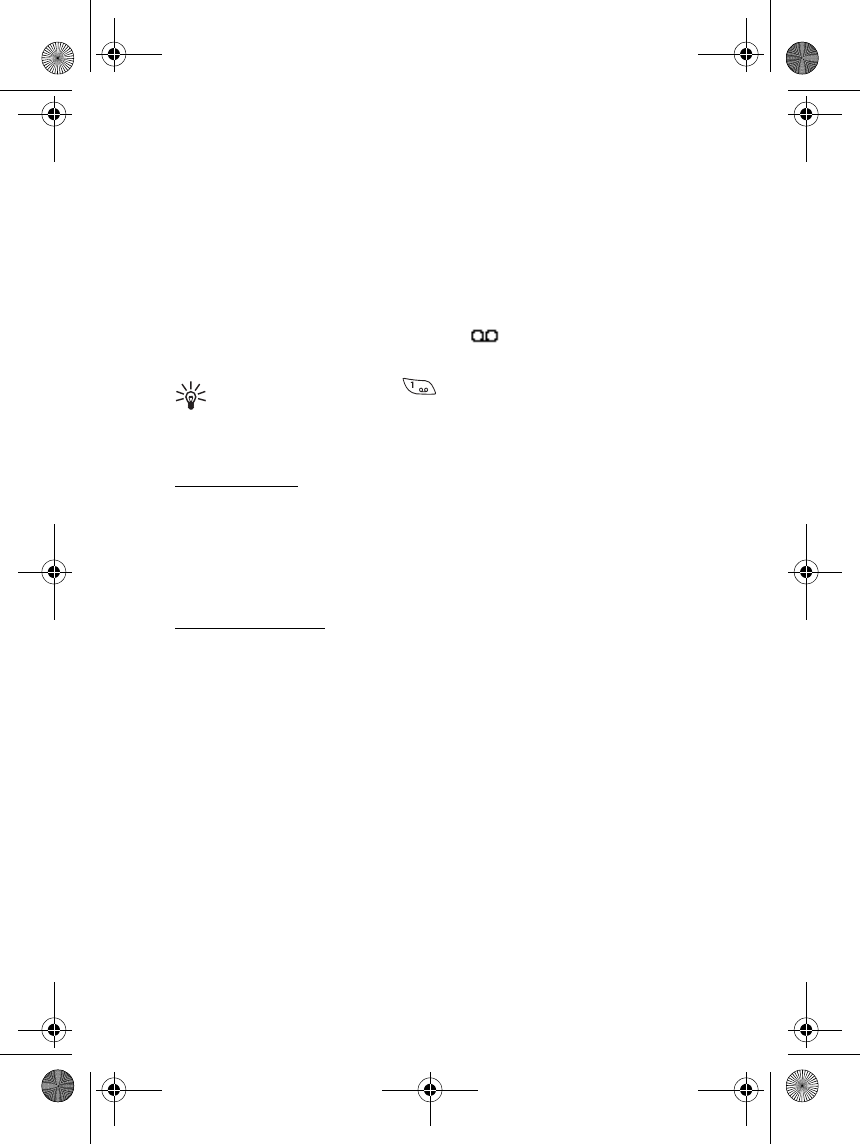
Menu functions
62
•Listen to voice messages to call your voice mailbox at the phone
number that you have saved in the Voice mailbox number menu.
If you have two phone lines available (network service), each phone
line may have its own voice mailbox number, see Call settings on
page 89.
•Voice mailbox number to key in, search for or edit your voice mailbox
number and press OK to save it.
If supported by the network, the indicator will indicate new voice
messages. Press Listen to call your voice mailbox number.
Tip: Pressing and holding calls your voice mailbox, when
the flip is closed. When the flip is open, press and hold the
corresponding number key.
Info messages
With the info message network service, you can receive messagesfrom
your service operator on various topics that may include for example
weather or traffic conditions. For availability, topics and the relevant
topic numbers, contact your service provider.
Message settings
The message settings affect the sending, receiving and viewing of
messages.
Settings for text and e-mail messages via SMS
1. Press Menu and select Messages, Message settings, Text messages
and Sending profile .
2. If more than one message profile set is supported by your SIM card,
select the set that you want to change.
• Select Message centre number to save the phone number of the
message centre that is required for sending text messages. You will
receive this number from your service provider.
• Select Messages sent via to select the message type: Text, E-mail,
Paging or Fax.
• Select Message validity to select the length of time for which the
network should attempt to deliver your message.
rm-2_en1_FCC.fm Page 62 Monday, February 16, 2004 8:14 AM
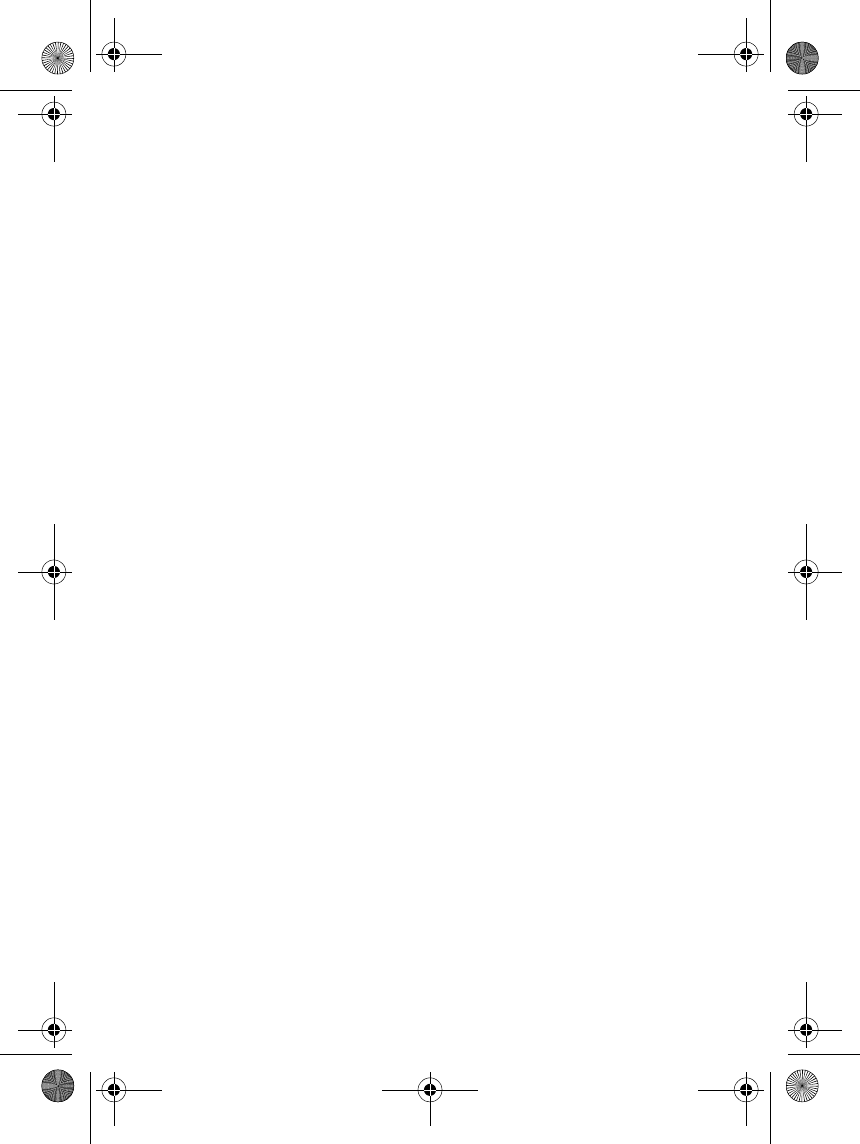
Menu functions
63
• For message type Text, select Default recipient number to save a
default number for sending messages for this message profile.
For message type E-mail, select E-mail server to save the e-mail
server number.
• Select Delivery reports to ask the network to send delivery reports
about your messages (network service).
• Select Use GPRS and Yes to set GPRS as the preferred SMS bearer.
Likewise, set the GPRS connection setting to Always online, see
EGPRS on page 87.
• Select Reply via same centre to allow the recipient of your message
to send you a reply via your message centre (network service).
• Select Rename sending profile to change the name of the selected
message profile. The message profile sets are only displayed if your
SIM card supports more than one set.
Overwrite settings
When the text message memory is full, the phone cannot receive or send
any new messages. However, you can set the phone to automatically
replace old text messages in the Inbox and Sent items folders with new
ones.
Press Menu and select Messages, Message settings and Text messages.
Select either Overwriting in inbox or Overwriting in sent items and
Allowed.
Settings for multimedia messages
You may receive the multimedia connection settings as an over-the-air
message from the network operator or service provider. To receive the
settings over the air, see Settings for the e-mail application on page 64.
Keying in the settings manually
Press Menu, and select Messages, Message settings and Multimedia
msgs.. Select
•Save sent messages. Select Yes to set the phone to save sent
multimedia messages in the Sent items folder. If you select No, the
sent messages are not saved.
rm-2_en1_FCC.fm Page 63 Monday, February 16, 2004 8:14 AM

Menu functions
64
•Delivery reports to ask the network to send delivery reports about
your messages (network service).
•Scale image down to define the image size when you insert the
image into the multimedia message.
•Default slide timing to set the timing for slides in multimedia
messages.
•Allow multimedia reception. Select No, Yes or In home network to use
the multimedia service. If you select In home network, you cannot
receive multimedia messages outside your home network.
•Incoming multimedia messages. Select Retrieve to set the phone to
automatically fetch newly received multimedia messages, or select
Reject if you do not wish to receive multimedia messages.
•Connection settings. Define connection settings for retrieving
multimedia messages. First select Active multimedia settings, and
activate the set in which you want to save the settings. Select Edit
active multimedia settings and edit the active settings.
Select each of the settings one by one and key in all the required
settings. Contact your network operator or service provider for the
settings.
•Allow adverts. You can receive or reject messages identified as
advertisements. The setting is not shown if Allow multimedia
reception is set to No.
Settings for the e-mail application
You may receive the e-mail settings from the network operator or
service provider over-the-air based on OMA (Open Mobile Alliance)
provisioning. For more information about using the OMA provisioning,
contact your network operator or service provider.
When you have ordered the settings as an OMA message, remain in
standby mode and do not open the E-mail application until you have
received the settings.
When you have received the connection settings, E-mail settings
received is displayed. To save the settings immediately, select Start.
• To save the settings, select Save. Confirm the action by selecting Yes.
rm-2_en1_FCC.fm Page 64 Monday, February 16, 2004 8:14 AM
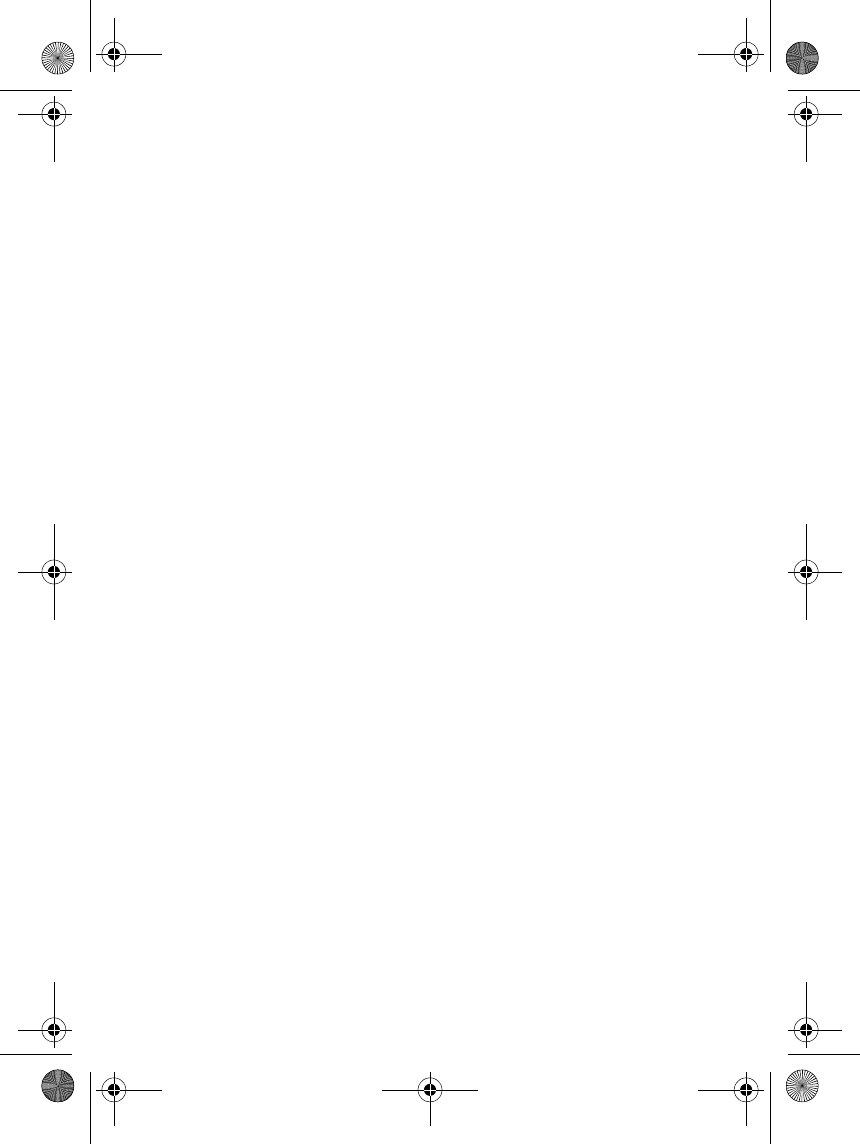
Menu functions
65
If all available settings are full, the phone asks if you want to replace
an existing set. Accept the replacement and select the set to be
replaced.
The existing sets are located in the Messages, E-mail, Connect via
menu.
The phone asks if you want to activate the saved settings. Accept the
activation if you want to use the new settings.
• To view the received settings first, select View.
• To discard the received settings, select Discard.
If the OMA provisioning service is not available, you can also key in the
settings manually. Press Menu and select Messages, Message settings,
and E-mail messages.
• First select Active e-mail settings and activate the set in which you
want to save the settings. Select Edit active e-mail settings and edit
the active settings.
Select each of the settings one by one and key in all the required
settings. Contact your network operator or e-mail service provider
for the settings.
•Mailbox name. Key in the name that you want to use for the
mailbox. You can use any name.
•E-mail address. Key in your e-mail address.
•My name. Key in your name or nickname. Your name and e-mail
address will be shown.
•Outgoing (SMTP) server. Key in the server address.
•Incoming server type. Select either POP3 or IMAP4 depending on
the type of e-mail system that you are using. If both types are
supported, select IMAP4. Changing the server type also changes
the incoming port number.
• If you have selected POP3 as a server type, then Incoming (POP3)
server, POP3 user name and POP3 password are shown. If you
have selected IMAP4 as a server type, then Incoming (IMAP4)
server, IMAP4 user name and IMAP4 password are shown. Key in
the e-mail server address for incoming e-mail, then key in the
user name and password to access the e-mail account. If you
rm-2_en1_FCC.fm Page 65 Monday, February 16, 2004 8:14 AM
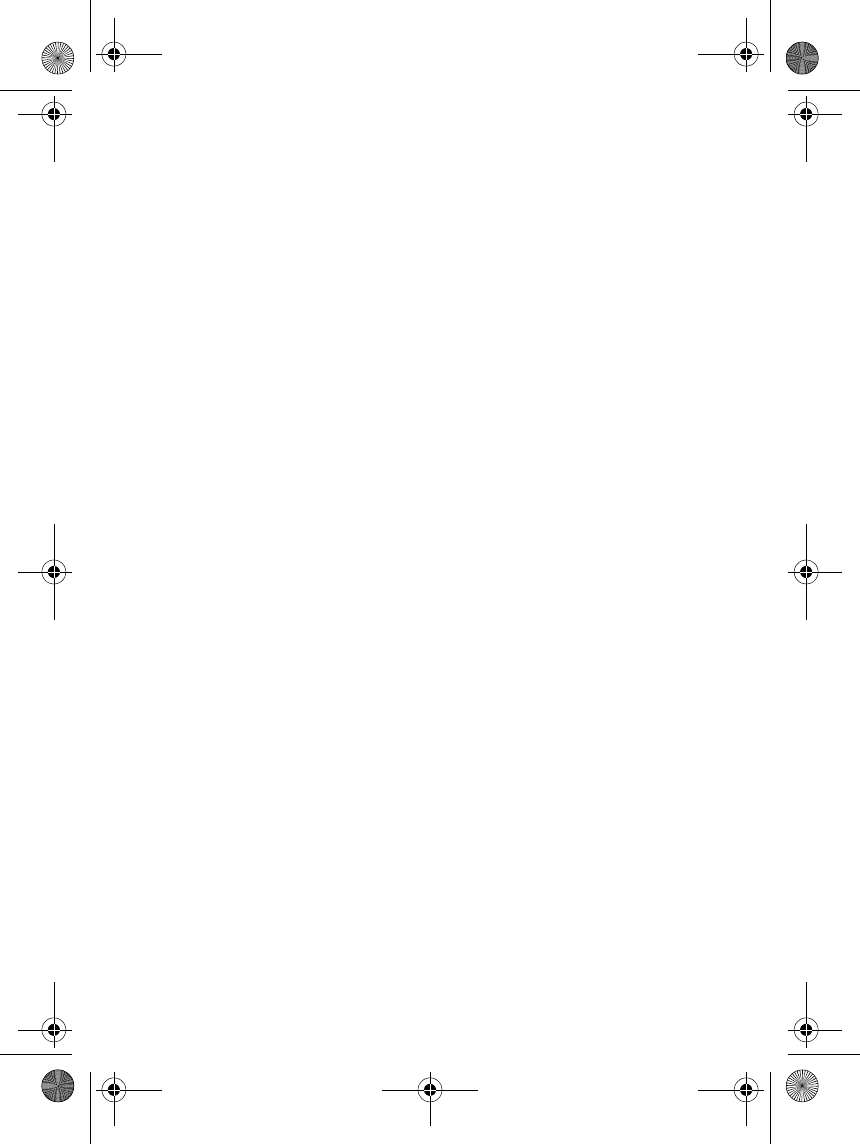
Menu functions
66
have not defined an SMTP user name or SMTP password, the e-
mail server uses the POP3/IMAP4 user name and password
instead.
•Other settings and select:
•Include signature. You can define a signature that is
automatically added to the end of your e-mail message.
•Use SMTP authorisation. If your e-mail service provider
requires authentication for sending e-mails, select Yes. In this
case, you must also define your SMTP user name and SMTP
password.
•SMTP user name. Key in the user name for outgoing e-mail
that you have obtained from your e-mail service provider.
•SMTP password. Key in the password that you want to use for
outgoing e-mail.
•Outgoing (SMTP) port. Key in the number of the e-mail server
port for outgoing e-mail. The most common default value is
25.
If you have selected POP3 as the server type, the following
options are shown:
•Incoming (POP3) port. Key in the port number that you have
obtained from your e-mail service provider.
•Reply-to address. Key in the e-mail address to which you want
the replies to be sent.
•Secure login. Select Secure login on if your connection
requires an encrypted login, otherwise leave it to Secure login
off. Contact your service provider if in doubt. Using encrypted
login enables increased security for user names and
passwords. It does not increase security for the connection
itself.
•Retrieve e-mails. Key in the maximum number of e-mails that
you want to retrieve at a time. The maximum number is 50.
•Retrieval method. Select Latest if you want to retrieve all
newly received e-mails or select Latest unread if you want to
retrieve only e-mails that you have not read.
rm-2_en1_FCC.fm Page 66 Monday, February 16, 2004 8:14 AM
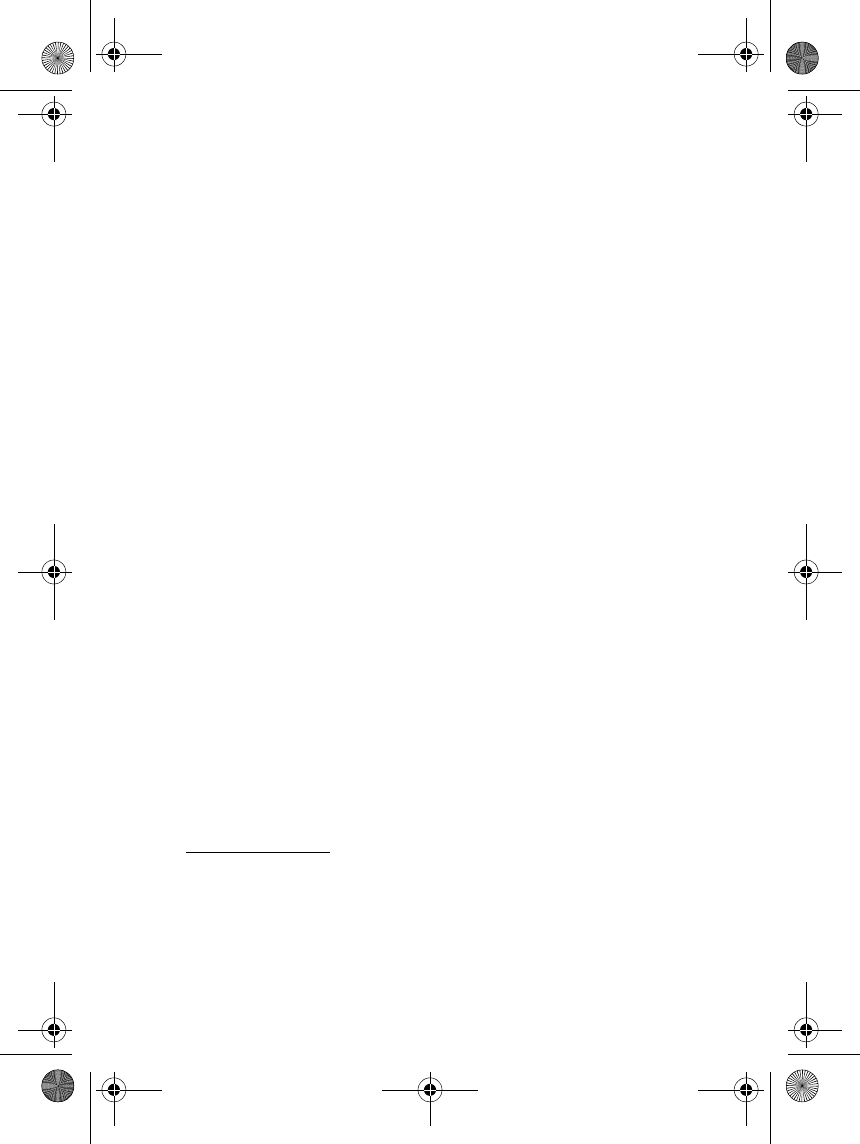
Menu functions
67
•SMTP connection settings to define the connection settings
required for outgoing e-mail.
•POP3 connection settings to define the connection settings for
incoming e-mail. See Keying in the service settings manually
on page 114.
Select each of the settings one by one and key in all the
required settings. Contact your e-mail service provider for the
settings.
If you have selected IMAP4 as the server type, the following
options are shown:
•Incoming (IMAP4) port. Key in the port number that you have
obtained from your e-mail service provider.
•Reply-to address. Key in the e-mail address to which you want
the replies to be sent.
•Retrieve e-mails. Key in the number of e-mails that you want
to retrieve at a time. The maximum number is 50.
•Retrieval method. Select Latest if you want to retrieve all
newly received e-mails or select Latest unread if you want to
retrieve only e-mails that you have not read.
•SMTP connection settings to define the connection settings
required for outgoing e-mail.
•IMAP4 connection settings to define the connection settings
required for incoming mail. See Keying in the service settings
manually on page 114.
Select each of the settings one by one and key in all the
required settings. Contact your e-mail service provider for the
settings.
Font size setting
To select the font size for reading and writing messages, press Menu and
select Messages, Message settings, Other settings, and Font size.
rm-2_en1_FCC.fm Page 67 Monday, February 16, 2004 8:14 AM
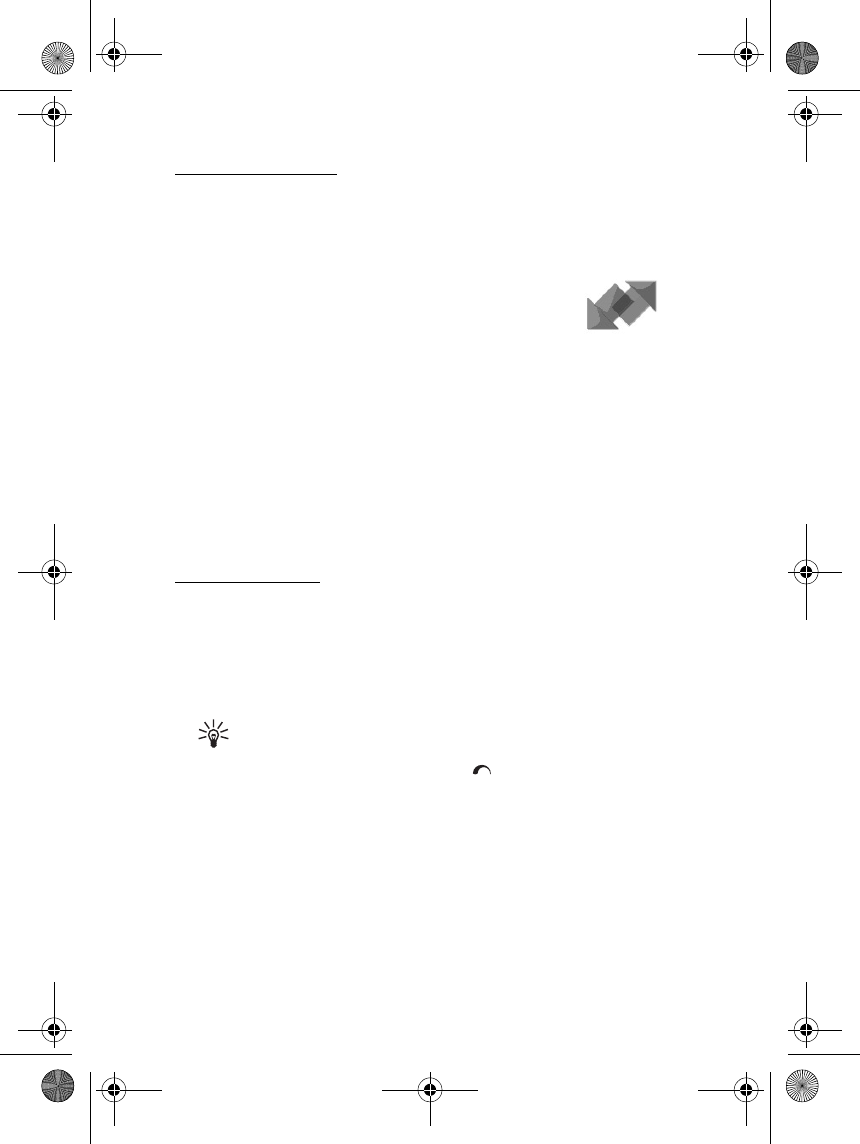
Menu functions
68
Service commands
Press Menu and select Messages and Service commands. Key in and
send service requests (also known as USSD commands), such as
activation commands for network services, to your service provider.
■Call register (Menu 2)
The phone registers the phone numbers of missed,
received and dialled calls, and the approximate length
of your calls.
The phone registers missed and received calls only if the network
supports these functions, and the phone is switched on and within the
network’s service area.
When you press Options in the Missed calls, Received calls and Dialled
numbers menu, you can, for example, view the date and the time of the
call, edit or delete the phone number from the list, save the number in
Contacts, or send a message to the number.
Recent calls lists
Press Menu and select Call register and then select
•Missed calls to view up to 20 phone numbers from which somebody
has tried to call you (network service). The number in front of the
(name or) phone number indicates the number of call attempts from
that caller.
Tip: When a note about missed calls is displayed, press List to
access the list of phone numbers. Scroll to the number you
would like to call back and press .
•Received calls to view up to 20 phone numbers from which you have
most recently accepted calls (network service).
•Dialled numbers to view up to 20 phone numbers that you have most
recently called or attempted to call. See also Last number redialling
on page 30.
•Delete recent call lists to delete the recent calls lists. Select whether
you want to delete all the phone numbers in the recent calls lists, or
rm-2_en1_FCC.fm Page 68 Monday, February 16, 2004 8:14 AM

Menu functions
69
only the numbers in the missed calls, received calls or dialled
numbers lists. You cannot undo the operation.
Timers and counters
Note: The actual invoice for calls and services from your service
provider may vary, depending upon network features, rounding-off for
billing, taxes and so forth.
Press Menu, select Call register and Timers and counters. Select
•Call duration. Scroll to view the approximate duration of your
incoming and outgoing calls in hours, minutes and seconds. The
security code is required to clear the timers.
If you have two phone lines available (network service), each phone
line has its own call duration timers. The timers of the selected line
are displayed. See Call settings on page 89.
•GPRS data counter. Scroll to check the amount of data that were
sent or received in bytes, sent and received data in total, and to clear
the counters. The security code is required to clear the counters.
•GPRS connection timer. Scroll to check the approximate duration of
the last GPRS connection or the total GPRS connection time. You can
also clear the timers. The security code is required to clear the timers.
■Contacts (Menu 3)
You can save names and phone numbers (contacts) in
both the phone’s memory and in the SIM card’s
memory.
• You may save up to 500 names with numbers and text notes for each
name in the phone’s memory. You can also save an image for a
certain number of names. The number of names that can be saved
depends on both the length of the names, and the number and
length of the phone numbers and text items.
Contacts use shared memory, see Shared memory on page 15.
• The phone supports SIM cards that can save up to 250 names and
phone numbers. Names and numbers that are saved in the SIM card’s
memory, are indicated by .
rm-2_en1_FCC.fm Page 69 Monday, February 16, 2004 8:14 AM

Menu functions
70
In dynamic contacts (Presence) you can publish your current availability
status to people with compatible devices who have access to this service
and who are requesting this information. You can view the availability
status of the contacts that you have subscribed to in the Subscribed
names menu and in the detailed view of a name in Contacts.
Selecting settings for contacts
Press Menu and select Contacts and Settings. Select
•Memory in use to select the memory, either SIM card or phone, that
you want to use for your contacts. To recall names and numbers from
both memories for contacts, select Phone and SIM. In this case, the
names and numbers will be saved in the phone’s memory.
•Contacts view to select how the names, numbers and images in
contacts are displayed.
•Memory status to view how much free memory is available for
contacts in both the SIM card and phone.
Saving names and phone numbers (Add contact)
Names and numbers will be saved in the memory in use, see Selecting
settings for contacts above.
1. Press Menu and select Contacts and Add contact.
2. Key in the name and press OK. See Using traditional text input on
page 36.
3. Key in the phone number, and press OK. To key in numbers, see
Making a call on page 30.
4. When the name and number have been saved, press Done.
Tip: Quick save: In standby mode, key in the phone number and
press Save. Key in the name, press OK and Done.
Saving multiple numbers and text items per name
You can save different types of phone numbers and short text items for
each name in the phone’s internal memory for contacts.
The first number saved is automatically set as the default number and it
is indicated by a frame around the number type indicator, for example
rm-2_en1_FCC.fm Page 70 Monday, February 16, 2004 8:14 AM

Menu functions
71
. When you select a name from Contacts, for example to make a
call, the default number is used unless you select another number.
1. Make sure that the memory in use is either Phone or Phone and SIM.
See Selecting settings for contacts on page 70.
2. To access the list of names and phone numbers, move the joystick
down in standby mode.
3. Scroll to the name saved in the phone’s internal memory for the
contact to which you want to add a new number or text item, and
press Details.
4. Press Options and select Add number or Add detail.
5. To add a number or detail, select one of the number types or text
types, respectively.
• If you select the text type User ID:
Select Search to search for an ID by a mobile phone number or an
e-mail address in the server of the operator or service provider if
you have connected to the presence service. See My presence on
page 73. If only one ID is found, it is automatically saved.
Otherwise, to save the ID, press Options, and select Save.
To key in the ID, select Enter ID manually. Key in the ID and press
OK to save it.
To change the number or text type, select Change type in the options
list. Note that you cannot change the type of an ID when it is on the
Chat contacts or in the Subscribed names list.
To set the selected number as the default number, select Set as
default.
6. Key in the number or text item and press OK to save it.
7. Press Back and then Exit to return to standby mode.
Adding an image to a name or number in contacts
You can add an image in supported format to a name or number saved in
the phone’s internal memory.
Move the joystick down in standby mode, scroll to the name (and
number) and press Details. Press Options and select Add image. The
rm-2_en1_FCC.fm Page 71 Monday, February 16, 2004 8:14 AM
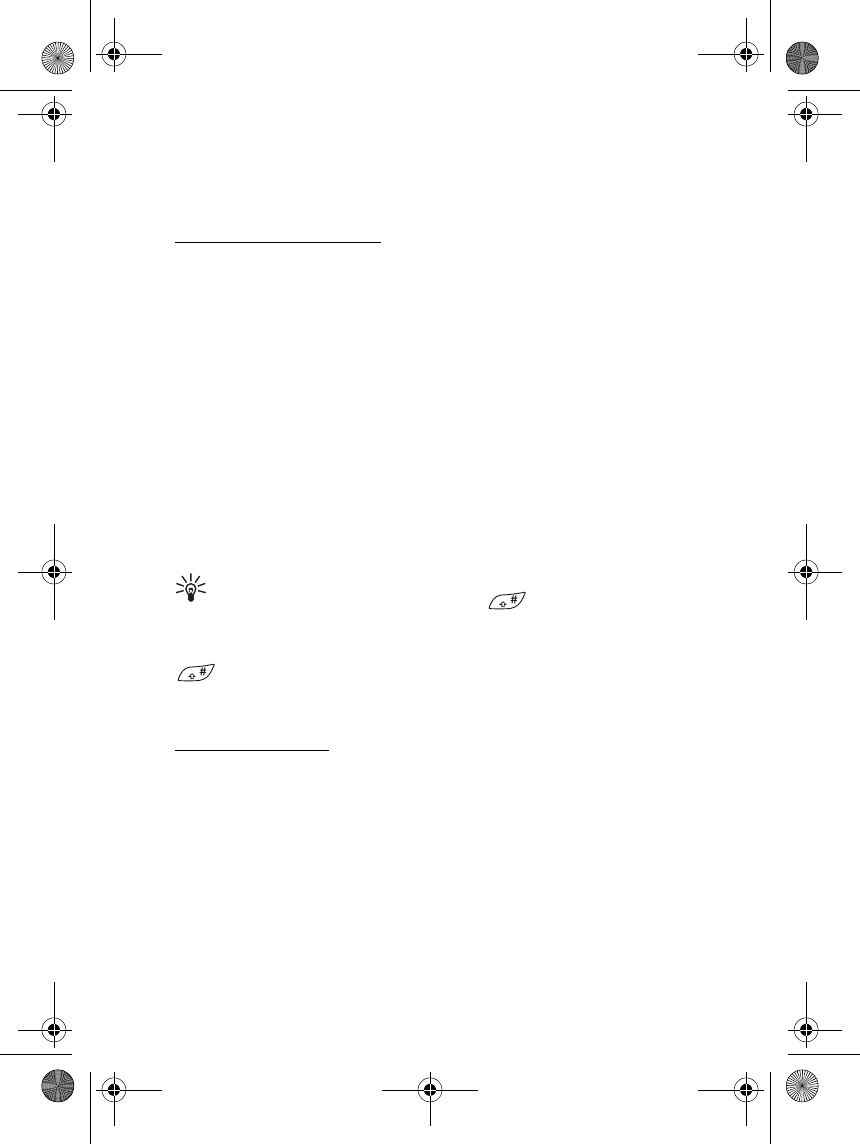
Menu functions
72
phone opens the list of folders in the Gallery. Scroll to the desired image,
press Options and select Save to contacts.
Searching for a contact
1. Press Menu and select Contacts and Search or move the joystick
down in standby mode.
2. You can key in the first characters of the name that you are
searching for in the pop-up window.
Move the joystick up or down to scroll through the names in the list,
and right or left to move the cursor in the pop-up window.
3. Scroll to the contact that you want, and press Details. Scroll to view
the details of the selected contact.
Depending on the Contacts view selection in Selecting settings for
contacts on page 70, the subscribed contacts are shown differently.
Either only the availability indicator or the availability indicator,
personal logo and the status message are shown. Press Details to
view all dynamic information.
Tip: To quickly view a specific name with the default number,
when the flip is closed, press and hold at the name while
scrolling through Contacts.
To view the status message in full, press Details and press and hold
at the dynamic contact while scrolling through the contact
names.
Deleting contacts
Press Menu, select Contacts and Delete to delete a contact and all the
details attached to it.
If the contact has an ID on the Chat contacts or in the Subscribed names
list, the note Presence information will be deleted is shown before the
contact is deleted.
• To delete names and numbers one by one, select One by one and
scroll to the name (and number) that you want to delete. Press
Delete and press Yes.
rm-2_en1_FCC.fm Page 72 Monday, February 16, 2004 8:14 AM

Menu functions
73
• To delete contacts all at once, select Delete all and then scroll to
either of the memories, Phone or SIM card, and press Delete. Press
Yes and confirm with the security code.
Editing or deleting details in contacts
Move the joystick down in standby mode, scroll to the contact that you
want to edit or delete and press Details. Scroll to the name, number, text
item or image that you want to edit or delete.
• Press either Edit or Change, or press Options and select Edit name,
Edit number, Edit detail or Change image depending on the Contacts
view selection in Selecting settings for contacts on page 70.
Note that you cannot edit or delete an ID when it is on the Chat
contacts or in the Subscribed names list.
• To delete a number or text item, select Delete number or Delete
detail.
• To delete an image that is attached to the contact, select Delete
image. Deleting an image from Contacts does not delete it from the
Gallery.
My presence
With the presence service (network service), you can share your
presence status with other users of the service. The presence status
includes your availability, status message and personal logo. Other users
who have access to the service and who request your information are
able to see your status. The requested information is shown in
Subscribed names in the viewer’s Contacts menu. You can personalise
the information that you want to share with others and control who can
see your status.
Before you can use presence, you need to subscribe to the service. To
check the availability and pricing, and to subscribe to the service,
contact your network operator or service provider, from whom you also
receive your unique ID and password and the settings for the service. To
set the required settings for the presence service, see Chat and my
presence settings on page 81. While you are connected to the presence
rm-2_en1_FCC.fm Page 73 Monday, February 16, 2004 8:14 AM
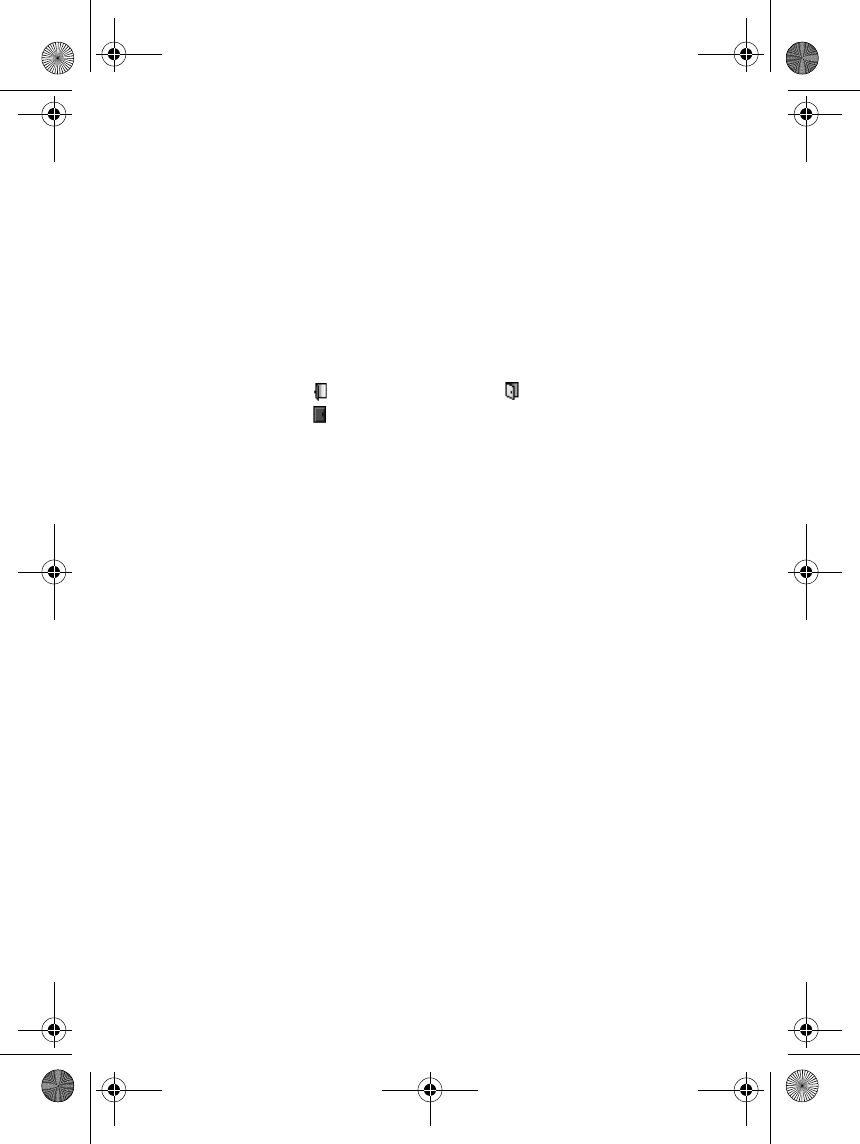
Menu functions
74
service, you can use the other functions of the phone, and the presence
service is active in the background.
Press Menu and select Contacts and My presence. Select
•Connect to ’My presence’ service (or Disconnect) to connect to or
disconnect from the service.
•My current presence to change your presence status. Select
•View current presence and select Private pres. or Public pres. to
view your current private or public status.
•My availability to set your availability status to Available
indicated by , or to Busy indicated by , or to Not available
indicated by .
•My presence message and key in the text to be shown to others or
press Options and select Previous msgs. and select an old
message as the status message.
•My presence logo to select your personal logo from the Graphics
folder in the gallery. If you select the default, the logo is not
published.
•Show to to select the groups to whom you want to show or not to
show your presence status.
Select Private and public and contacts in your private list are able
to see all your presence information: availability, status message
and logo. Other contacts can see only your availability.
Select Private viewers and the contacts in your private list can see
all your presence information (availability, status message and
logo). Other users will not see any information.
If you select No one, no one can see your presence information.
•Viewers and select
•Current viewers to view all the persons who have subscribed to
your presence information.
•Private list is a list of the persons who are allowed to view all your
presence information, including availability, status message and
logo. You can manage your own private list. Other persons who
are not in the private list, can see only your availability.
rm-2_en1_FCC.fm Page 74 Monday, February 16, 2004 8:14 AM
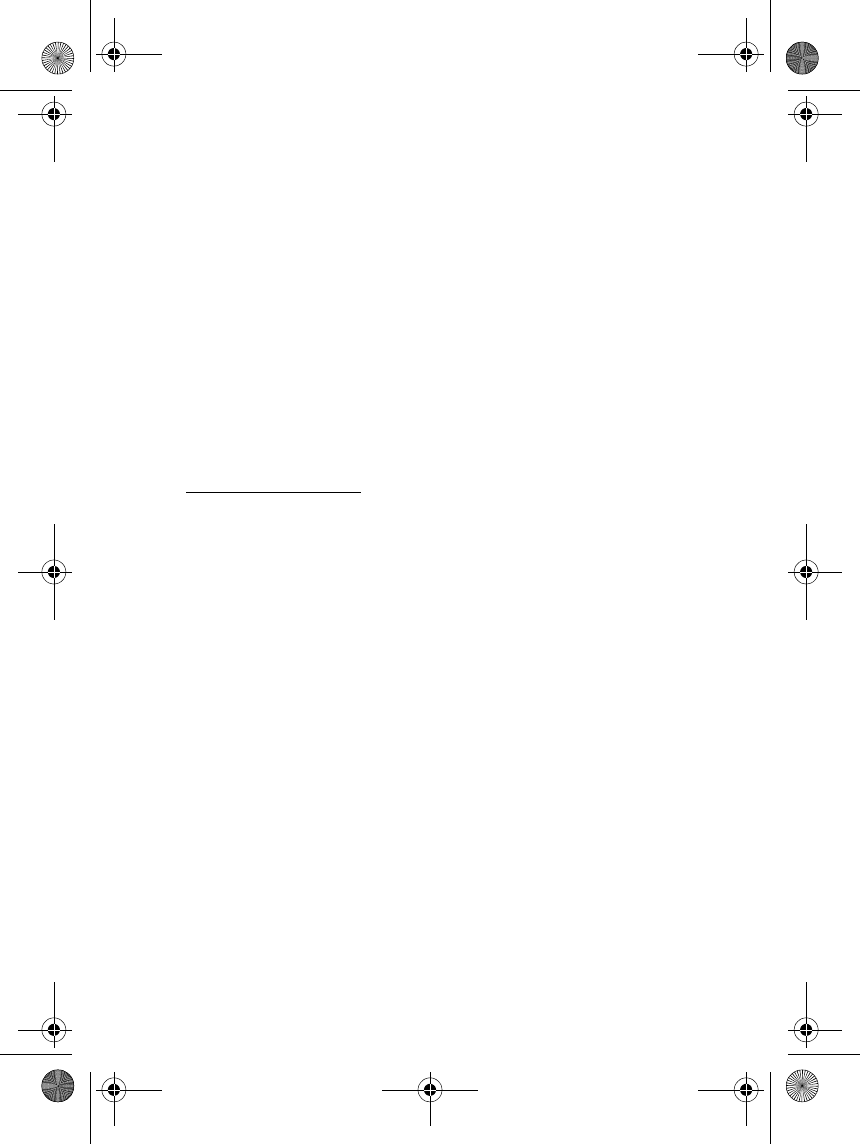
Menu functions
75
• Blocked list to view all the persons you have blocked from
viewing your presence information.
•Settings and select
•Show current presence in idle to show the current status indicator
in standby mode.
•Synchronise with profiles to select whether you want to link My
presence message and My availability manually or automatically
to the currently active profile. Note that you cannot link a
personalised status logo to a Profile. See also Profiles on page 80.
•Connection type to set the phone to automatically connect to the
service when the phone is switched on.
•Connect. settings see Chat and my presence settings on page 81.
Subscribed contacts
You can create a list for contacts whose presence status you wish to be
aware of (network service). You can view the information if allowed by
the contacts and if it is not prevented by the network. You can view the
subscribed contacts either by scrolling through the contacts or via the
Subscribed names menu.
Make sure that the memory in use is either Phone or Phone and SIM. See
Selecting settings for contacts on page 70.
To connect to the Presence service, press Menu and select Contacts, My
presence and Connect to ’My presence’ service. You can also view the
subscribed contacts when you are not connected to the presence
service, but you cannot see the presence status of the contact.
Adding contacts to the subscribed contacts
1. Press Menu and select Contacts and Subscribed names. If you have
not connected to the Presence service, the phone asks if you want to
connect now.
2. If you have no contacts on your list, press Add. Otherwise, press
Options and select Subscribe new. The list of contacts is shown.
3. Select a contact from the list and if the contact has an ID saved, the
contact is added to the subscribed contacts list. If there is more than
rm-2_en1_FCC.fm Page 75 Monday, February 16, 2004 8:14 AM

Menu functions
76
one ID, select one of them. After subscription to the contact,
Subscription activated is shown.
Tip: To subscribe to a contact from the Contacts list, move the
joystick down in standby mode and scroll to the contact that you
want to subscribe to. Press Details and press Options. To
subscribe, select Request presence and select As subscription.
If you only want to view the presence information without subscribing
to a contact, select Request presence and One time only.
Viewing the subscribed contacts
See also Searching for a contact on page 72 to view the presence
information.
1. Press Menu and select Contacts and Subscribed names.
The status information of the first contact on the dynamic contacts
list is shown and it may include text and some of the following icons:
, or indicate that the person is either available, busy or not
available.
indicates that the person’s presence information is not available.
2. Scroll to the desired contact and press Details to view the details of
the selected contact. If you press Options, you can select
•Subscribe new to add a new contact to the list of subscribed
contacts.
•Chat to start a chat conversation.
•Send message to send a text message to the selected contact.
•Send SMS e-mail to send an e-mail to the selected contact.
•Send bus. card to send a business card of the selected contact.
•Unsubscribe to remove the selected contact from the list of
subscribed contacts.
Unsubscribing a contact
• To unsubscribe a contact from the Contacts list, move the joystick
down in standby mode and scroll to the contact that you want to
unsubscribe. Press Details and select the ID and press Options. To
unsubscribe, select Unsubscribe and press OK to confirm.
rm-2_en1_FCC.fm Page 76 Monday, February 16, 2004 8:14 AM
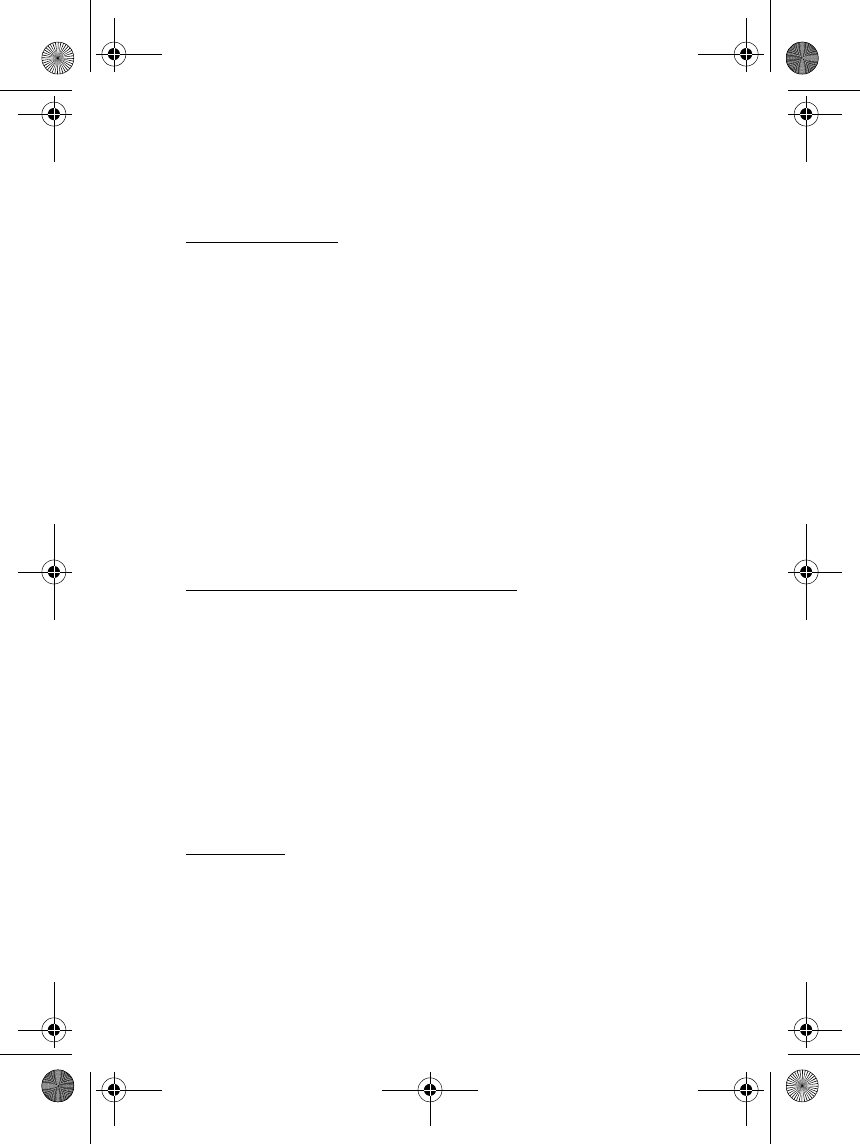
Menu functions
77
• To unsubscribe via the Subscribed names menu, see Viewing the
subscribed contacts on page 76.
Copying contacts
You can copy names and phone numbers from the phone’s memory to
your SIM card’s memory and vice versa. Note that any text items saved
in the phone’s internal memory, such as e-mail addresses, will not be
copied to the SIM card.
1. Press Menu and select Contacts and Copy.
2. Select the copying direction, From phone to SIM card or From SIM
card to phone.
3. Select One by one, All or Default numbers.
Default numbers is shown if you copy from the phone to the SIM
card. Only the default numbers will be copied.
4. To choose whether you want to keep or delete the original names
and numbers, select Keep original or Move original.
Sending and receiving a business card
You can send and receive a person’s contact information as a business
card from a compatible device.
When you have received a business card, press Show and Save to save
the business card in the phone’s memory. To discard the business card,
press Exit and then OK.
To send a business card, search for the name and phone number that
you want to send in Contacts, press Details and Options and select Send
bus. card. Select Via infrared, Via text message (network service), or Via
Bluetooth.
Speed dials
To assign a number to a speed-dialling key, press Menu and select
Contacts, Speed dials and scroll to the desired speed-dialling key
number.
Press Assign, or if a number has already been assigned to the key, press
Options and select Change. Press Search, and select first the name and
rm-2_en1_FCC.fm Page 77 Monday, February 16, 2004 8:14 AM
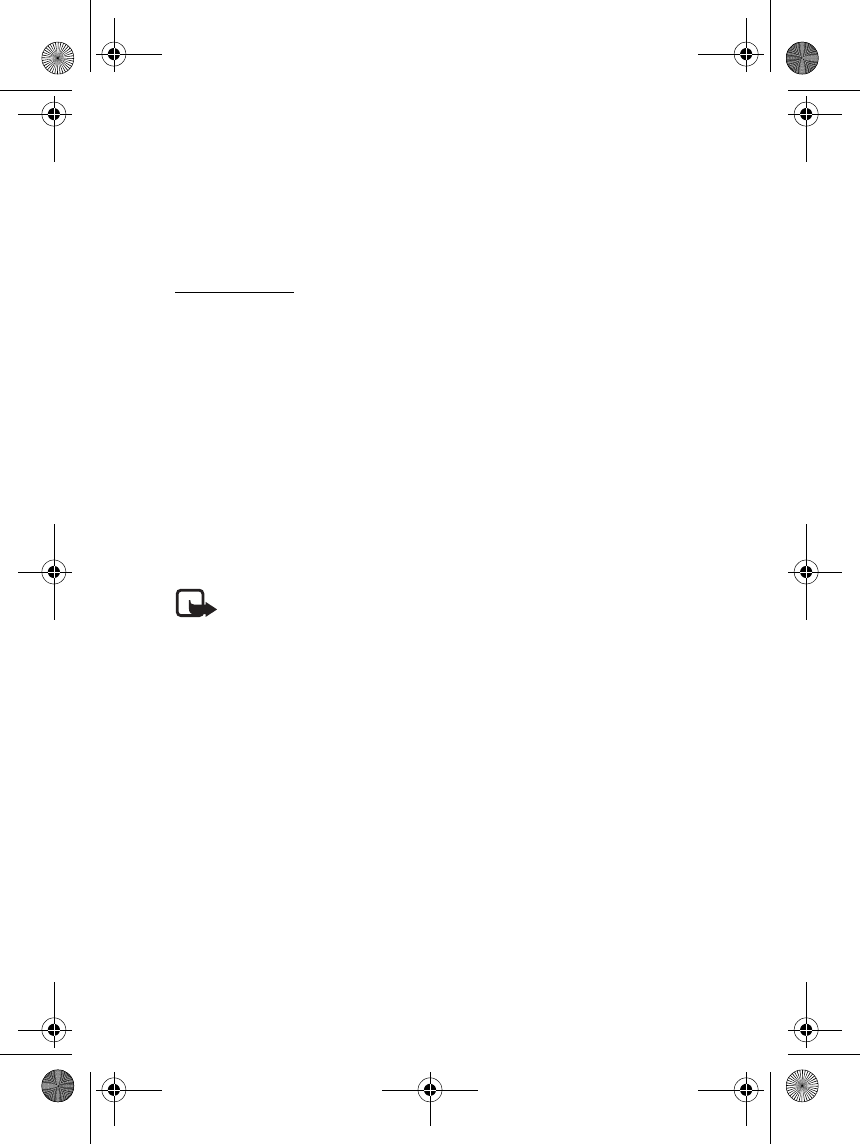
Menu functions
78
then the number you want to assign. If the Speed dialling function is off,
the phone asks whether you want to activate it.
To make a call using the speed-dialling keys, see Speed dialling a phone
number on page 31.
Voice dialling
You can make a phone call by saying a voice tag that has been added to
a phone number. Any spoken word(s), such as a person’s name(s), can be
a voice tag. You can add up to ten voice tags.
Before using voice dialling, note that:
• Voice tags are not language dependent. They are dependent on the speaker's
voice.
• Voice tags are sensitive to background noise. Record them and make calls in a
quiet environment.
• When recording a voice tag or making a call by saying a voice tag, hold the
phone in the normal position near to your ear.
• Very short names are not accepted. Use long names and avoid similar names
for different numbers.
Note: You must say the name exactly as you said it when you recorded
it. This may be difficult in, for example, a noisy environment or during
an emergency, so you should not rely solely upon voice dialling in all
circumstances.
Adding and managing voice tags
• Save or copy the contacts to which you want to add a voice tag into
the phone’s memory. You can also add voice tags to the names in the
SIM card, but if you replace your SIM card with a new one, you first
need to delete the old voice tags before you can add new ones. Voice
tags use shared memory, see Shared memory on page 15.
1. In standby mode, press Menu, and select Contacts and Search, scroll
to the desired contact and press Details.
2. Press Options and select Add voice tag.
3. Press Start, and say clearly the word(s) you want to record as a voice
tag. After recording, the phone plays the recorded tag.
rm-2_en1_FCC.fm Page 78 Monday, February 16, 2004 8:14 AM
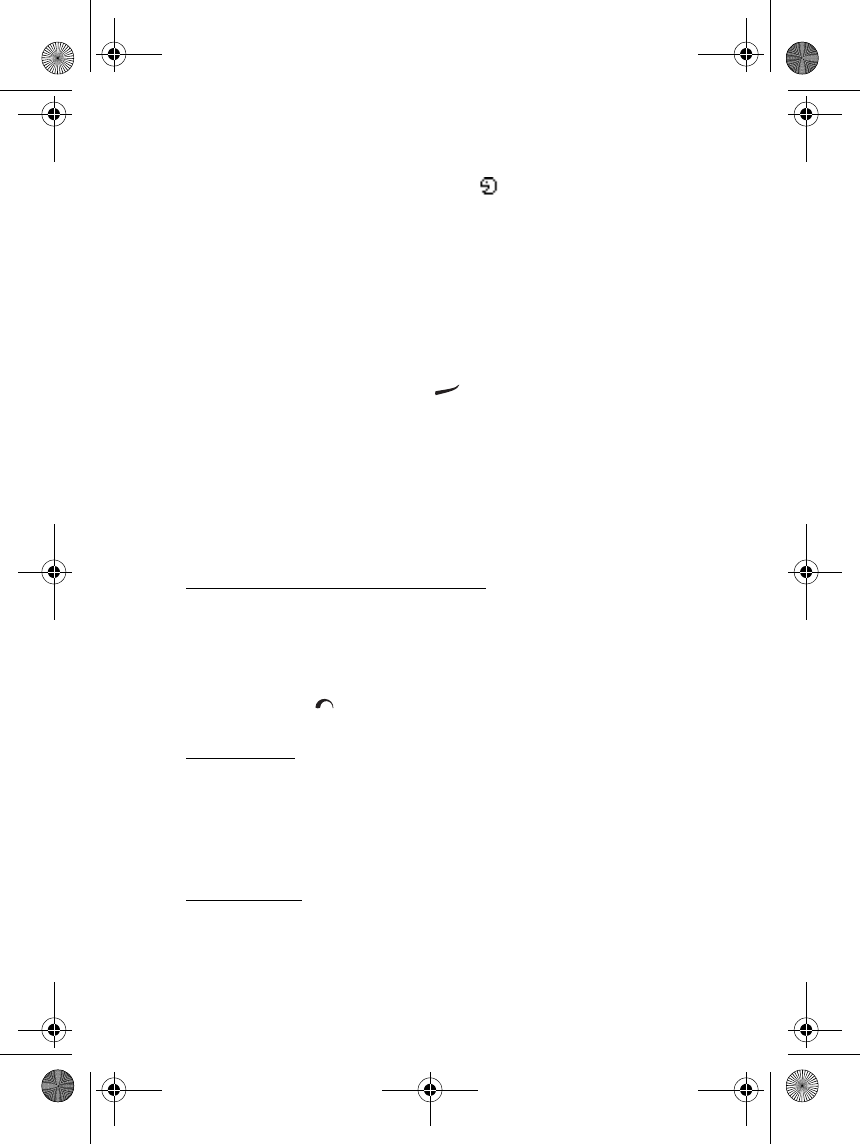
Menu functions
79
4. When the voice tag has been successfully saved, Voice tag saved is
displayed, a beep sounds and a symbol appears after the phone
number with a voice tag.
To check the voice tags, press Menu and select Contacts and Voice tags.
Scroll to the contact you require, select it and the function you require.
Making a call by using a voice tag
If the phone is using an application involving a GPRS connection which
is sending or receiving data, end the application in order to make a call
using voice dialling.
1. In standby mode, press and hold , or press and hold the volume
down key at the side of the phone. A short tone is heard and Speak
now is displayed.
2. Say the voice tag clearly. The phone plays the recognised voice tag
and then dials the phone number of the voice tag after 1.5 seconds.
If you are using a compatible headset, press and hold the headset key to
start the voice dialling.
Info numbers and service numbers
Your service provider may have included information numbers or service
numbers on your SIM card.
Press Menu and select Contacts and Info numbers or Service numbers.
Scroll through a category to an information number, or to a service
number and press to call the number.
My numbers
The phone numbers assigned to your SIM card are saved in My numbers
if this is allowed by the card. To view the numbers press Menu and select
Contacts and My numbers. Scroll to the desired name or number, and
press View.
Caller groups
You can arrange the names and phone numbers saved in Contacts into
caller groups. For each caller group, you can select a ringing tone and
you can turn on or off a logo that is shown on the display when you
rm-2_en1_FCC.fm Page 79 Monday, February 16, 2004 8:14 AM
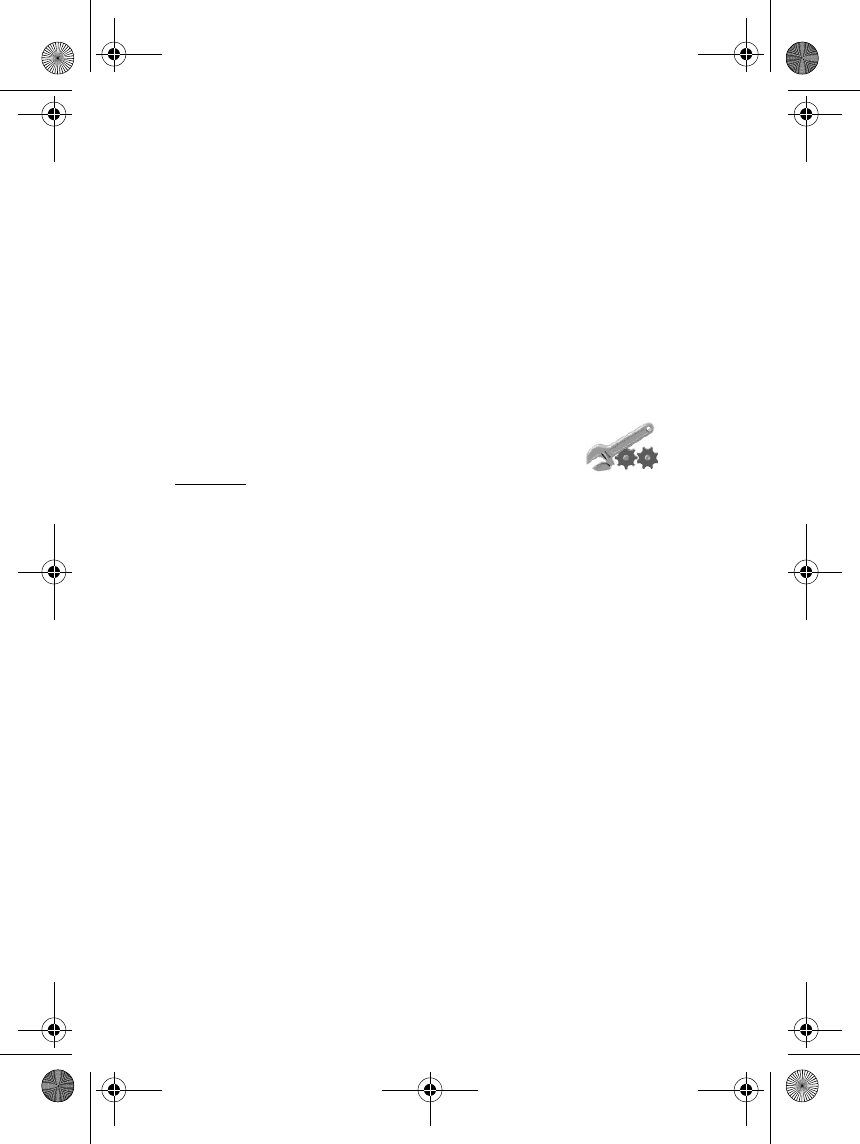
Menu functions
80
receive a call from a phone number in the group. To set the phone to ring
only upon calls from an identified phone number that belongs to a
selected caller group, see Alert for in Tone settings on page 81.
Press Menu and select Contacts, Caller groups and select the desired
caller group. You can select from the following functions Group name,
Group ringing tone, Group logo, Group members.
If you select Group members, press Add to add a name to the group.
Scroll to the name that you want and press Add.
To remove a name from a caller group, scroll to the desired name, and
press Remove.
■Settings (Menu 4)
Profiles
Your phone has a group of profiles that allow you to personalise the
tone settings of your phone and to activate a profile for different events
and environments. Available profiles are General, Silent, Meeting,
Outdoor, My style 1 and My style 2.
Press Menu and select Settings and Profiles. Scroll to a profile and press
Select.
• To activate the selected profile, select Activate.
• To activate the profile for a certain amount of time (up to 24 hours),
select Timed and set the end time. When the timed profile expires,
the previous profile that was not timed becomes active.
• To personalise the profile, select Personalise. Select the setting that
you want to change and make the changes.
The settings can also be changed in the Tone settings menu, see Tone
settings on page 81.
To rename a profile, select Profile name. The General profile cannot
be renamed.
• To change your presence status, select My presence. The menu is
available if you have set Synchronise with profiles to On, see My
presence on page 73. Select My availability to change your
rm-2_en1_FCC.fm Page 80 Monday, February 16, 2004 8:14 AM
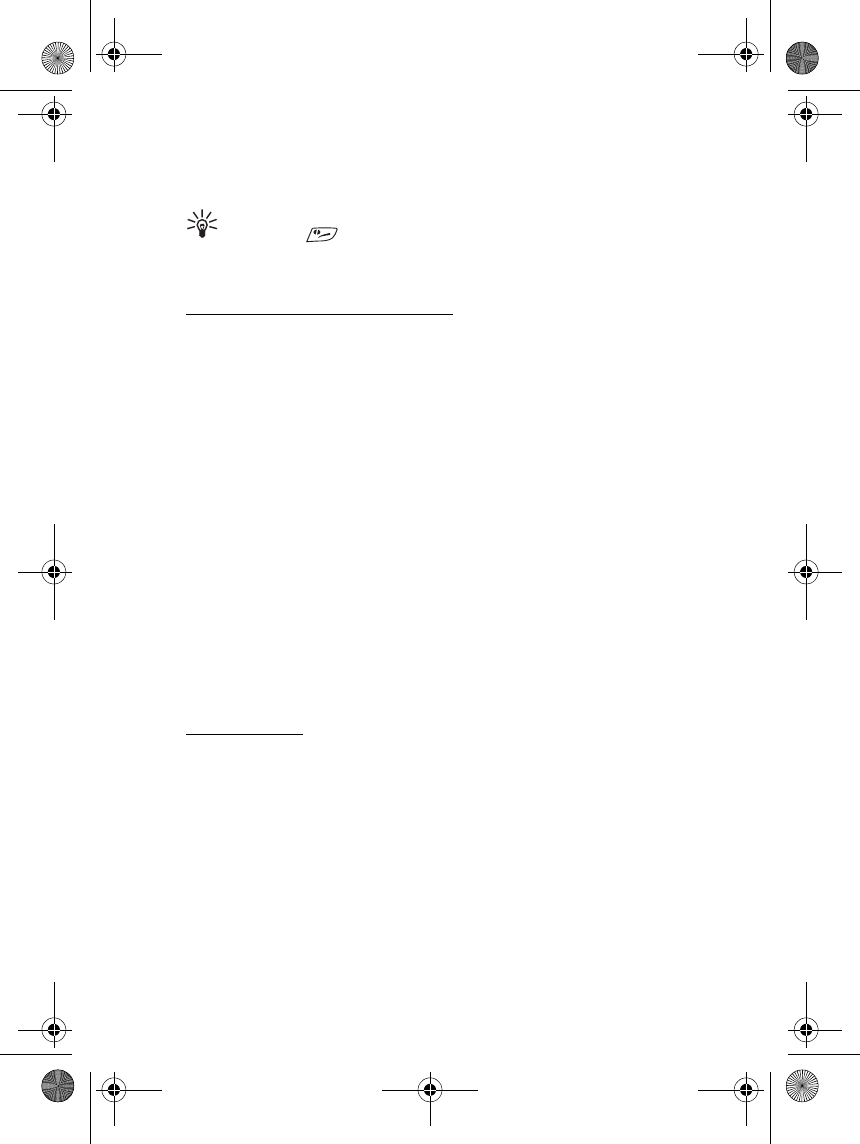
Menu functions
81
availability status and My presence message to edit your status
message.
Tip: To quickly change the profile in standby mode, press the
power key , scroll to the profile that you want to activate
and press Select.
Chat and my presence settings
For the settings required for chat, contact your network operator or
service provider. To receive the chat and presence settings over the air,
see Over-the-air settings service on page 28.
Keying in the settings manually
1. Press Menu, and select Settings, Chat and my presence settings and
Current chat and presence settings.
2. Scroll to the set you would like to activate and press Activate.
You need to activate the connection set where you want to save the
settings. A connection set is a collection of settings required to make
a connection to the chat and presence services.
3. Select Edit current chat and presence sett..
Select each of the settings one by one and key in all the required
information that you have received from your network operator or
service provider. Note that the connection settings are in the
Connection settings menu.
Tone settings
You will find the same settings in the Profiles menu, see Profiles on page
80. Note that the settings you make will change the settings in the
active profile.
Press Menu and select Settings and Tone settings. Select
•Incoming call alert and select how the phone notifies you of an
incoming voice call.
•Ringing tone to select a tone for incoming voice calls. To select
ringing tones that have been saved in the Gallery, select Open gallery
from the ringing tone list.
rm-2_en1_FCC.fm Page 81 Monday, February 16, 2004 8:14 AM
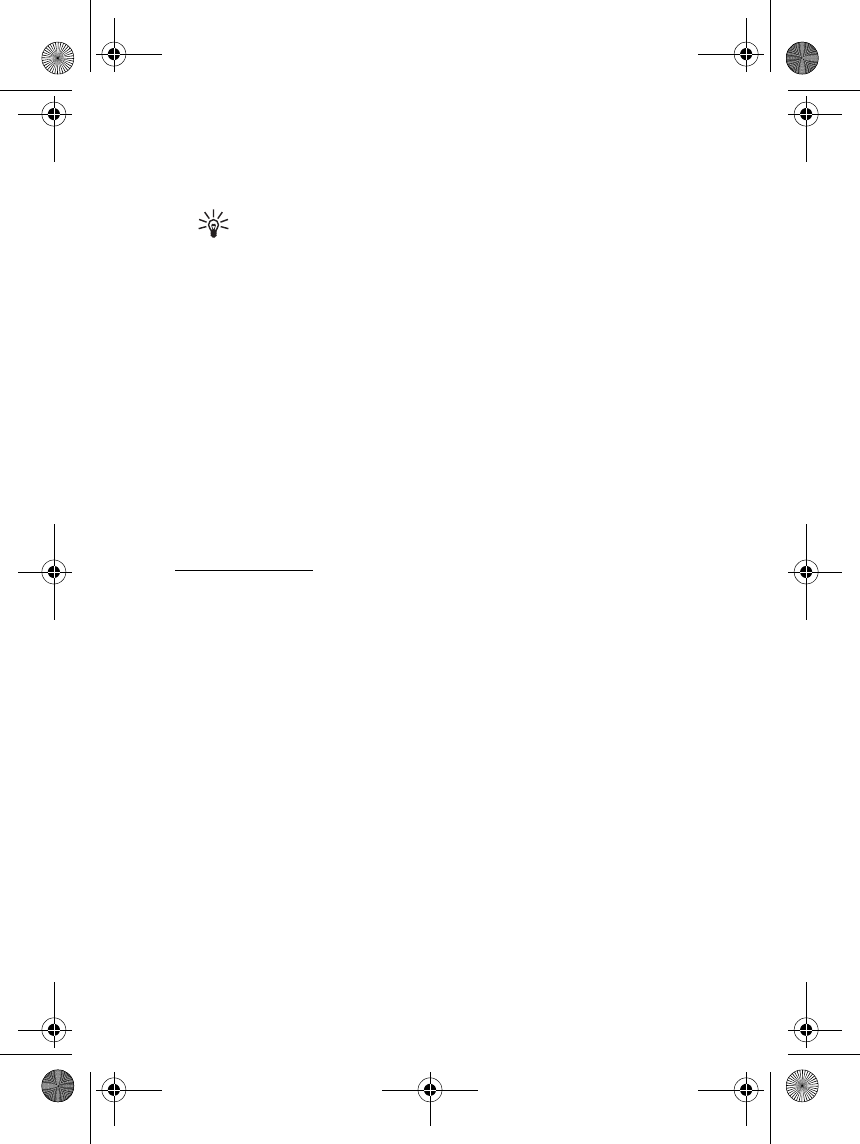
Menu functions
82
•Ringing volume to set the tone level for incoming voice calls and
incoming messages.
Tip: If you download a ringing tone or receive one via OTA, you
can save it in the Gallery.
•Vibrating alert to set the phone to vibrate for incoming voice calls
and incoming messages. The vibrating alert does not work when the
phone is connected to a charger, a desktop stand, or a car kit.
•Message alert tone to set the alert tone for incoming messages.
•Chat alert tone to set the alert tone for incoming instant messages.
•Keypad tones to adjust the tone level of the keypad.
•Warning tones to set the phone to sound tones, for example when
the battery is running out of power.
•Alert for to set the phone to ring only on calls from phone numbers
that belong to a selected caller group. Scroll to the caller group that
you want or All calls and press Mark.
Display settings
Press Menu and select Settings, Display settings. Select
•Wallpaper to set the phone to display a background image, known as
wallpaper, when the phone is in standby mode. Some images are pre-
saved in the Gallery menu. You can also receive images, for example
via multimedia messages, or use PC Suite to transfer them from a
compatible PC and then save them in the Gallery. Your phone
supports JPEG, GIF, WBMP, BMP, OTA-BMP and PNG formats, but not
necessarily all variations of these formats.
• Select Select wallpaper and open an image folder. Scroll to the
desired image you want to set as wallpaper, press Options and
select Set as wallpaper.
• To activate/deactivate the wallpaper, select On or Off.
Note that the wallpaper is not displayed when the phone
activates the screen saver.
•Colour schemes to change the colour of some display components,
for example indicators and signal bars.
rm-2_en1_FCC.fm Page 82 Monday, February 16, 2004 8:14 AM
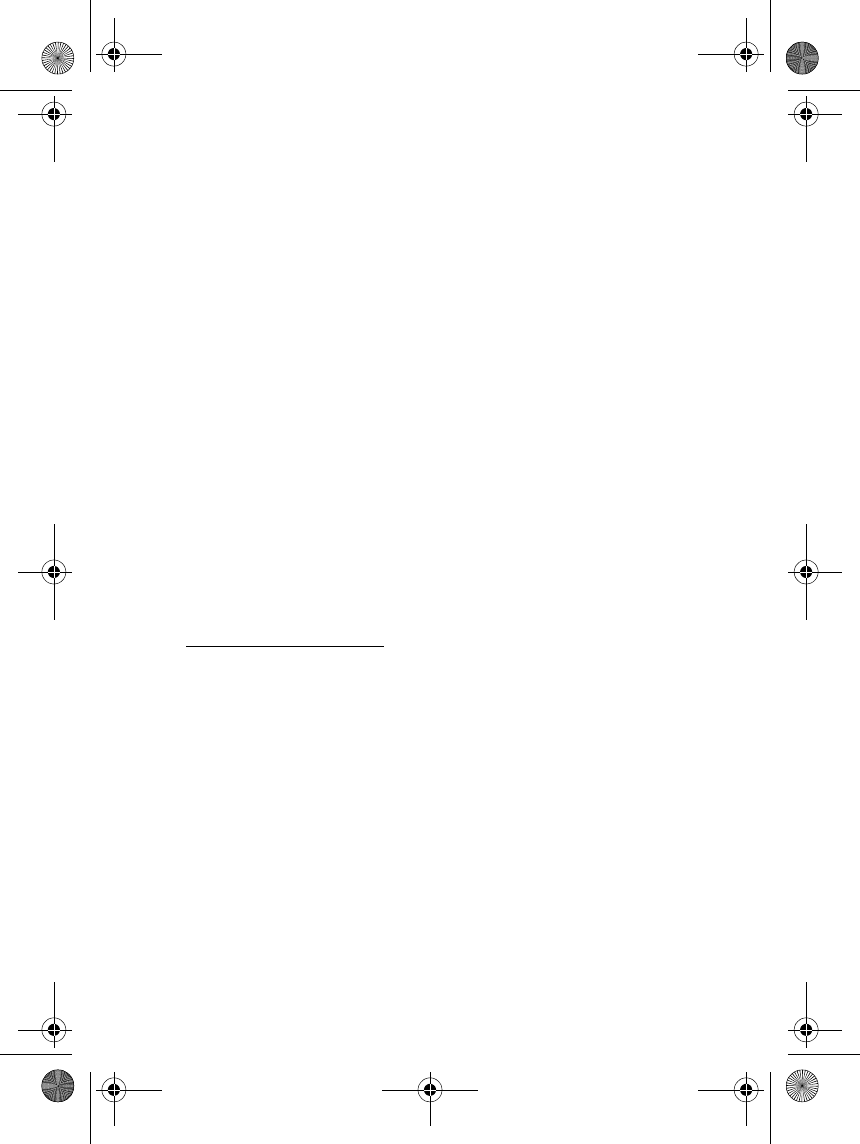
Menu functions
83
•Menu view to select how the main menu items are displayed on the
phone. Select List or Grid.
•Operator logo to set the phone to show or hide the operator logo. If
you have not saved any operator logos, the Operator logo menu is
dimmed.
The operator logo is not displayed when the phone activates the
screen saver.
•Screen saver time-out and select the timeout after which the screen
saver will be activated. The length of the timeout can vary from 5
seconds to 60 minutes.
The digital clock screen saver is used for power saving. It is activated
when no phone function has been used for a set length of time. Press
any key to deactivate the screen saver. The screen saver is also
deactivated when the phone is out of the network coverage area. The
screen saver overrides graphics and texts on the display in standby
mode.
•Display contrast to change the brightness level of the phone display.
Move the joystick to the left to decrease and to the right to increase
the brightness level, and press OK to accept it.
Time and date settings
Press Menu and select Settings, Time and date settings. Select
•Clock and select Show clock (or Hide clock ) to show (or hide) the
time on the top right of the display in standby mode. Select Set the
time to adjust the clock to the correct time, and Time format to
select the 12-hour or 24-hour time format.
The clock is also used for the functions Messages, Call register, Alarm
clock, timed Profiles, Calendar, Notes, and screen saver, for example.
If the battery is removed from the phone for a long time, you may
need to reset the time.
•Date and select Show date (or Hide date) to show (or hide) the date
on the display in standby mode. Select Set the date to adjust the
date. You can also select the date format and the date separator.
rm-2_en1_FCC.fm Page 83 Monday, February 16, 2004 8:14 AM
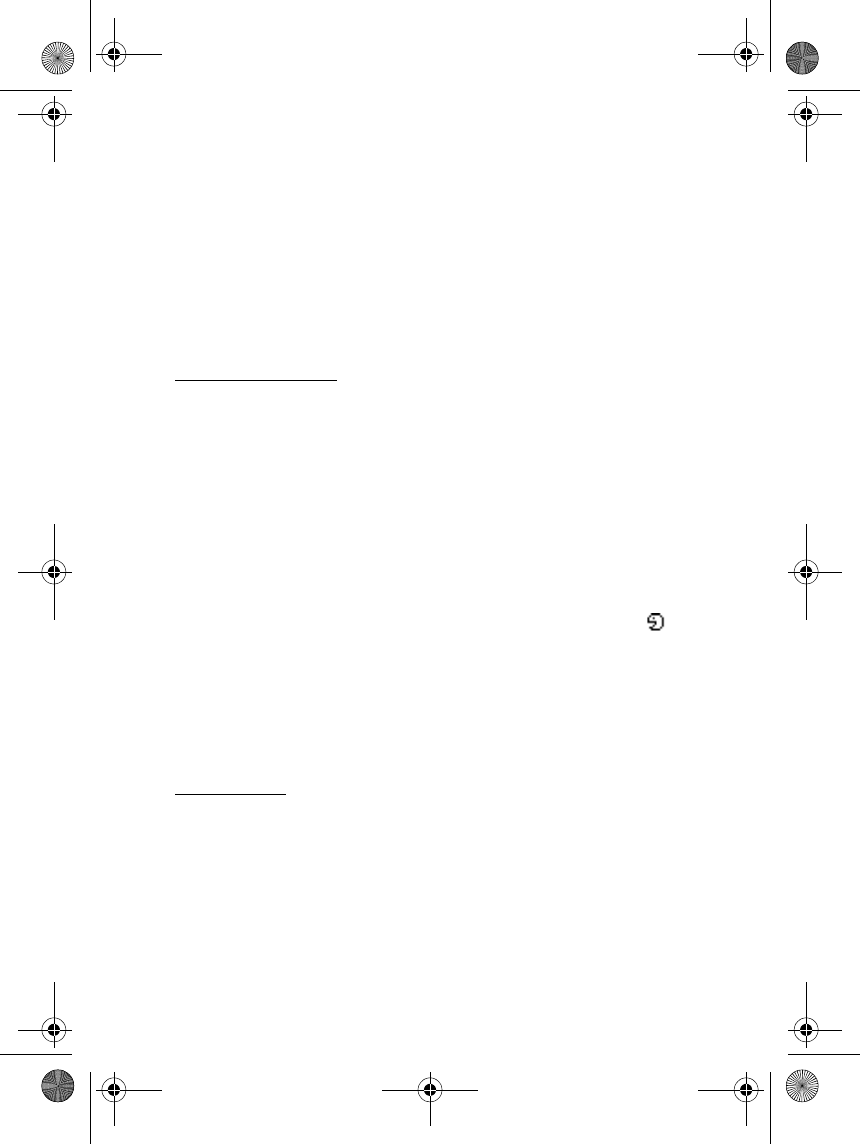
Menu functions
84
•Auto-update of date & time (network service) to set the phone to
automatically update the time and date according to the current
time zone, select On. To set the phone to ask for confirmation before
the update, select Confirm first.
The automatic update of date and time does not change the time you
have set for the alarm clock, calendar or the alarm notes. They are in
local time. Updating may cause some alarms that you have set to
expire.
Personal shortcuts
You can select the function for the right selection key displayed in
standby mode.
You also have a list of phone functions that can be activated by saying a
voice tag. Up to five voice tags for the voice commands can be added.
Press Menu, and select Settings and Personal shortcuts. Select
•Right selection key to view the list of available functions for the right
selection key. Scroll to the function that you want and select it.
•Voice commands and select the voice command folder that you
want, scroll to the function to which you want to add a voice tag and
press Add. If the command already has a voice tag, the indicator
is shown. For adding and activating a voice command, see Voice
dialling on page 78.
During a call or when an application using the EGPRS connection is
sending or receiving data, you cannot activate or add a voice
command.
Connectivity
You can connect the phone to a compatible device via infrared or
Bluetooth connection. You can also define the settings for EGPRS dial-
up connections. Note that the Bluetooth and infrared connections
cannot be active at the same time.
Bluetooth wireless technology
The phone supports Bluetooth wireless technology which allows you to
connect the phone to a compatible device within 10 metres. The
rm-2_en1_FCC.fm Page 84 Monday, February 16, 2004 8:14 AM
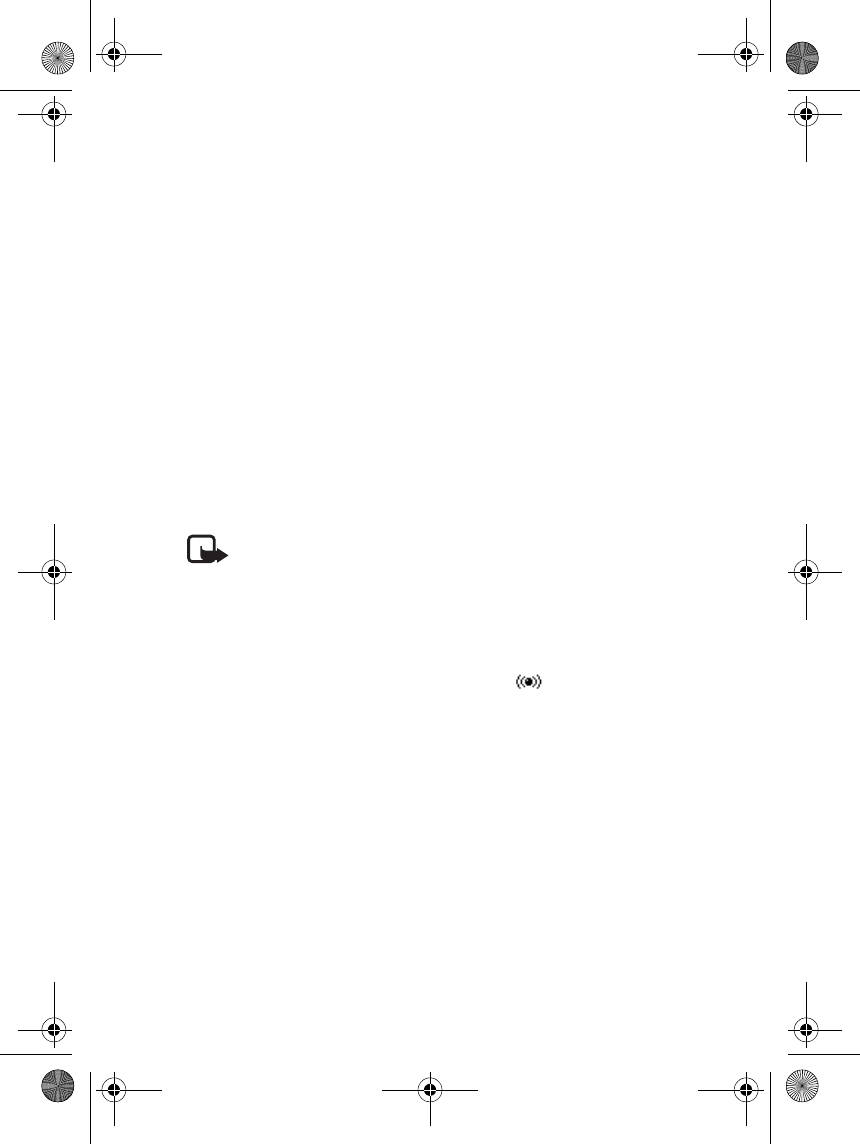
Menu functions
85
Bluetooth connection can be subject to interference from obstructions
such as walls or other electronic devices.
This phone is compliant with Bluetooth Specification 1.1 which
supports the following Bluetooth profiles: Serial Port Profile, Dial-up
Networking Profile, Object Push Profile, File Transfer Profile and Headset
Profile. Handsfree Profile is supported by Specification 1.0 and SIM
Access Profile by version 0.95.
To ensure interoperability between Bluetooth devices, use Nokia-
approved accessories for this model. Check with the manufacturers of
other Bluetooth devices to determine their compatibility with this
phone. In some countries, there may be restrictions on using Bluetooth
devices. Check with your local authorities.
The SIM Access Profile allows you to connect to compatible devices,
such as the Nokia car enhancement RAN 610. When the SIM Access
Profile is active, the phone is disconnected from the GSM network, and
thus, all phone functions are deactivated.
Note: Using Bluetooth consumes the battery and the phone's operating
time will be reduced. Be careful not to let it run in the background when
performing other operations with your phone.
Setting up a Bluetooth connection
1. Press Menu, and select Settings, Connectivity and Bluetooth.
2. To activate the Bluetooth function, select Bluetooth and On. The
active Bluetooth connection is indicated by at the top of the
display.
If you do not use the Bluetooth feature for some time, you can
deactivate it to save power.
3. Select Search for audio enhancements to search for compatible
Bluetooth devices and select the device that you want to connect to
the phone.
4. Enter the Bluetooth passcode of the device to associate (’pair’) and
connect the device to your phone and start using the device.
You only need to give this passcode when you connect to the device
for the first time.
rm-2_en1_FCC.fm Page 85 Monday, February 16, 2004 8:14 AM
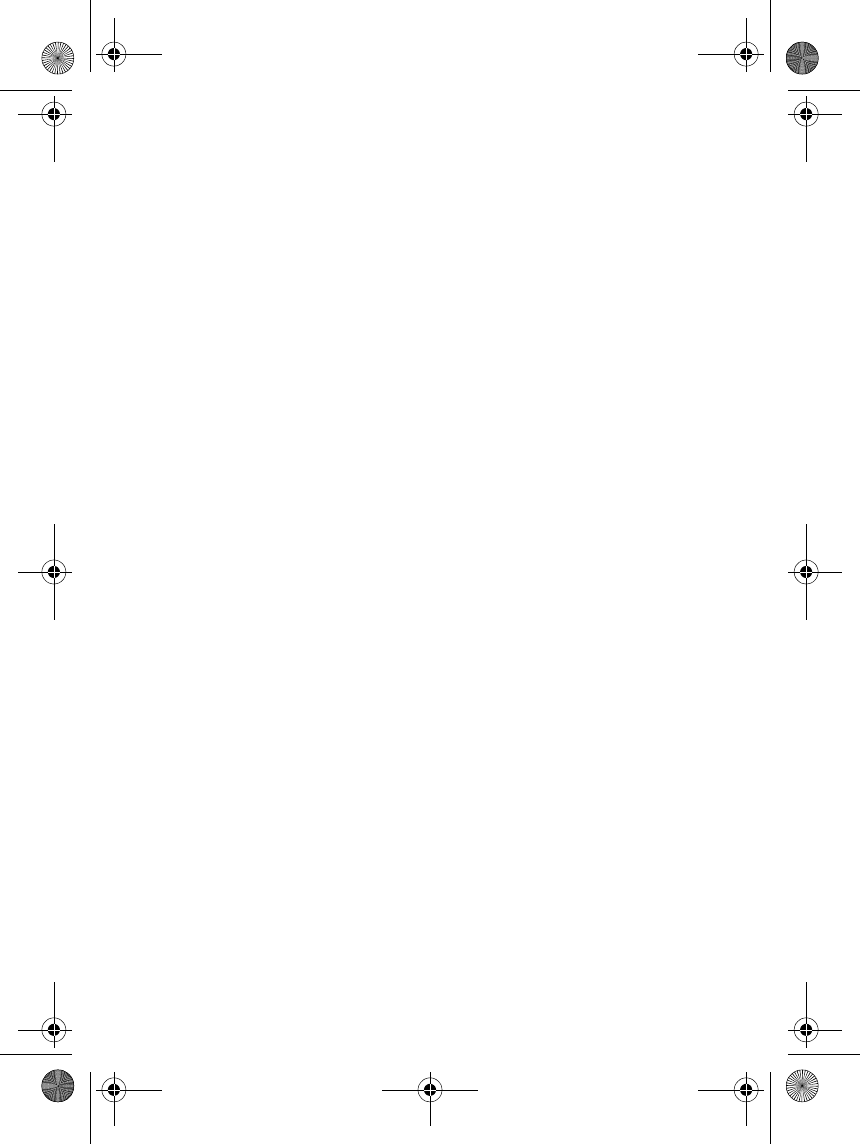
Menu functions
86
Bluetooth connection
Press Menu, and select Settings, Connectivity and Bluetooth. Select
•Active device to check which Bluetooth connection is currently
active. If you want to close the connection to the selected device,
press Disconnect.
•Paired devices to view a list of Bluetooth devices that are currently
paired with the phone. Scroll to the desired device. If you want to
delete the pairing, press Delete.
Press Options to access some of the following functions depending on
the status of the device and the Bluetooth connection. Select
•Connect to connect to the selected device.
•Assign short name to give a nickname (only visible to you) to the
selected device.
•Auto-conn. without confirmation and select No if you want the
phone to automatically connect to the selected device, or select Yes
if you want the phone to ask for your permission first.
Bluetooth settings
Press Menu, and select Settings, Connectivity, Bluetooth and Bluetooth
settings to define how your phone is shown to other Bluetooth devices.
Select
•My phone's visibility and Shown to all to show the phone to all other
Bluetooth devices or Hidden to show the phone only to the paired
devices.
•My phone's name to change your phone’s Bluetooth device name
that can be seen by other Bluetooth device users.
Infrared
The phone has an infrared port that you can use for connecting your
phone to another IrDA compliant device. You can send or receive data
such as business cards and calendar notes to or from a compatible
phone or data device (for example a computer).
Do not point the IR (infrared) beam at anyone's eye or allow it to interfere with
other IR devices. This device is a Class 1 Laser product.
rm-2_en1_FCC.fm Page 86 Monday, February 16, 2004 8:14 AM
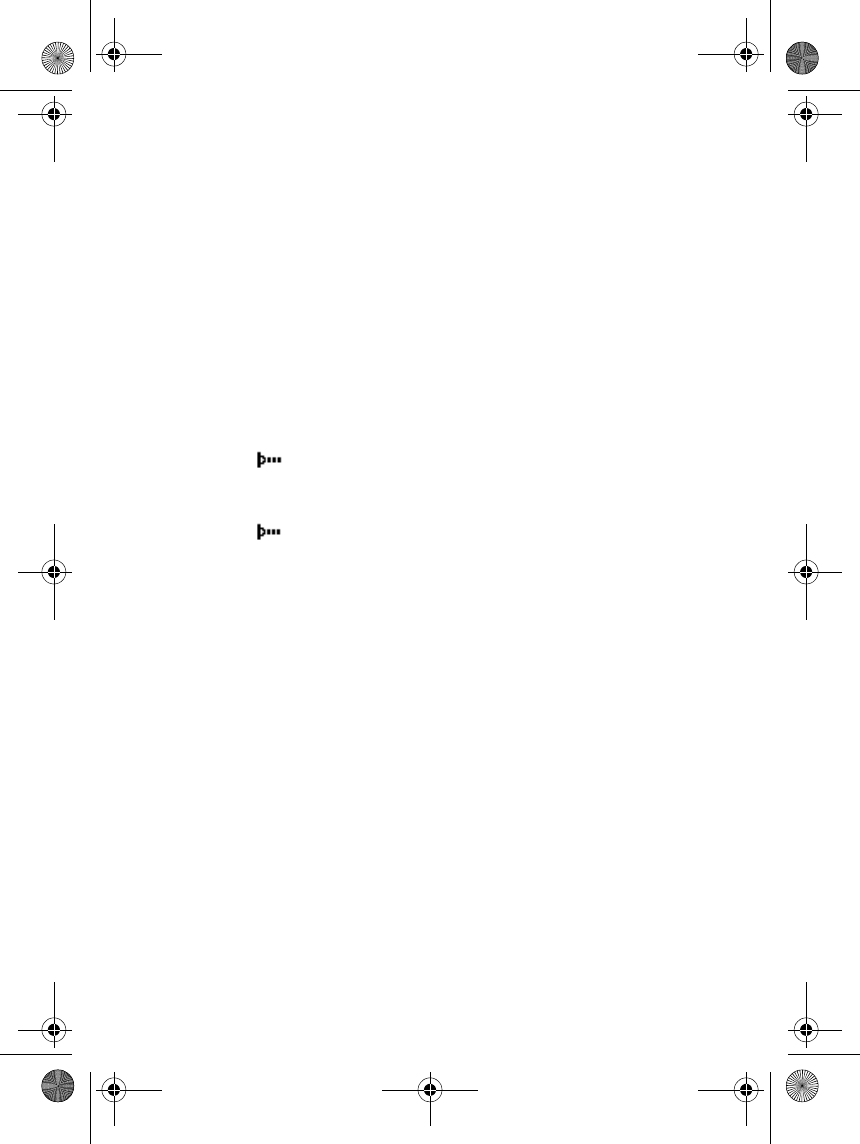
Menu functions
87
Sending and receiving data via IR
• Ensure that the IR ports of the sending and receiving devices are
pointing at each other and that there are no obstructions between
them. The preferable distance between the two devices in an infrared
connection should be one metre at most.
• To activate the IR port of your phone to receive data via IR, press
Menu and select Settings, Connectivity and Infrared.
• The user of the sending phone selects the desired IR function to start
data transfer.
If the data transfer is not started within two minutes of the activation of
the IR port, the connection is cancelled and has to be started again.
IR connection indicator
• When is shown continuously, the IR connection has been
activated and your phone is ready to send or receive data via its IR
port.
• When blinks, your phone is trying to connect to the other device
or a connection has been lost.
Note that the IR connection deactivates automatically.
EGPRS
GPRS (General Packet Radio Service) is a network service that allows
mobile phones to be used for sending and receiving data over an
Internet Protocol (IP)-based network.
EGPRS (Enhanced GPRS), also known as EDGE (Enhanced Data Rates for
Global Evolution) is similar to GPRS but it enables faster connection. For
more information on the availability of EGPRS and data transfer speed,
contact your network operator or service provider.
The applications that may use EGPRS are multimedia, chat and text
messaging, browsing sessions, e-mail, remote OMA Data
Syncronization, Java application downloading and the PC dial-up (for
example, Internet and e-mail).
Before you can use EGPRS technology:
• Contact your network operator or service provider for availability
and subscription to the EGPRS service.
rm-2_en1_FCC.fm Page 87 Monday, February 16, 2004 8:14 AM
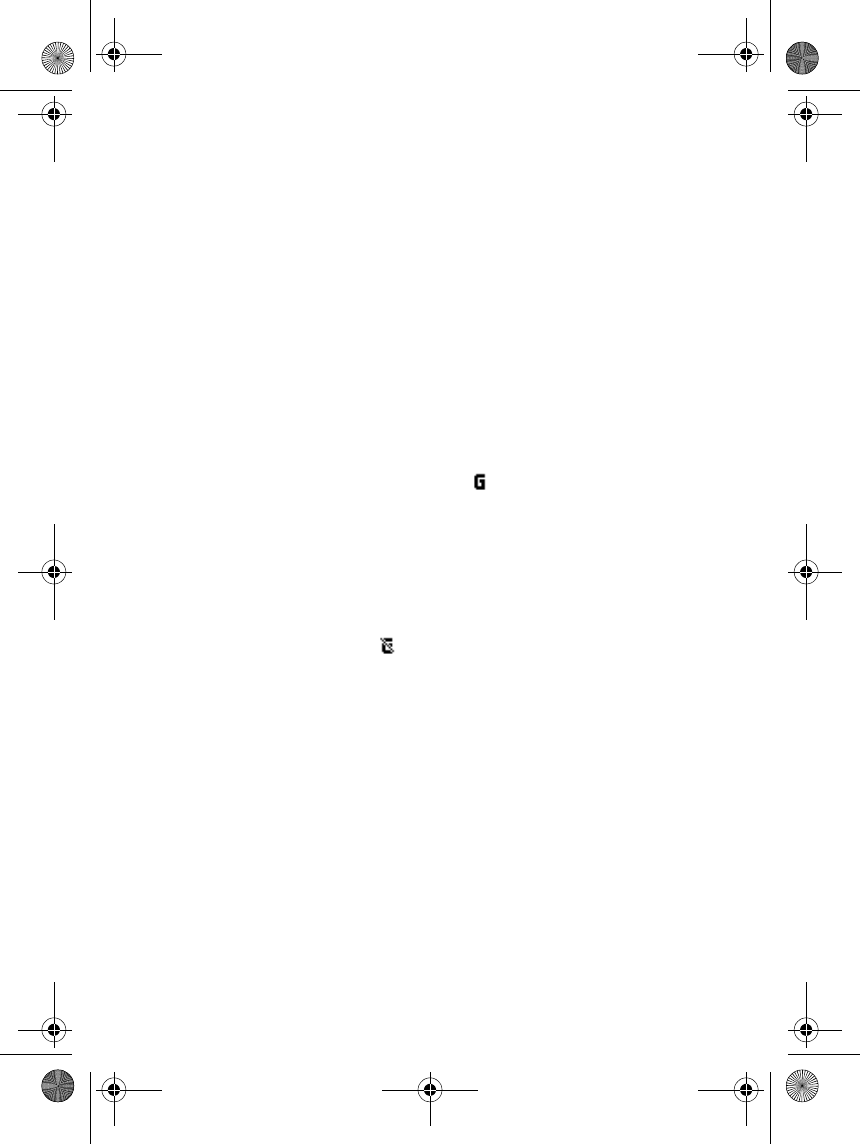
Menu functions
88
• Save the EGPRS settings for each of the applications used over
EGPRS.
For information on pricing, contact your network operator or service
provider.
Note that when you have selected GPRS as a data bearer, the phone uses
EGPRS instead of GPRS if this is available in the network. You cannot
choose between EGPRS and GPRS but for some applications you may be
able to select either GPRS or GSM data (CSD, Circuit Switched Data).
EGPRS connection
Press Menu and select Settings, Connectivity, GPRS and GPRS
connection.
• Select Always online to set the phone to automatically register to an
EGPRS network when you switch the phone on. When the GPRS
connection is established, the indicator is shown on the top left of
the display.
When you start an application using EGPRS, the connection between
the phone and the network is established, and data transfer is
possible. When you end the application, the EGPRS connection is
ended but the registration with the EGPRS network remains.
If you receive a call or a text message, or make a call during a GPRS
connection, the indicator will be shown on the top right of the
display to indicate that the EGPRS connection has been suspended
(put on hold).
The GPRS and EGPRS connections are indicated by the same
indicators.
• If you select When needed, the EGPRS registration and connection
are established when required by an application using GPRS and
closed when you end the application.
Note that your phone supports three simultaneous EGPRS connections.
For example, depending on the network, you can simultaneously browse
xHTML pages, receive multimedia messages and have an ongoing PC
dial-up connection.
rm-2_en1_FCC.fm Page 88 Monday, February 16, 2004 8:14 AM

Menu functions
89
EGPRS modem settings
You can connect the phone to a compatible PC via infrared, Bluetooth
wireless technology or a data cable connection and use the phone as a
modem to enable EGPRS connectivity from the PC.
Press Menu and select Settings, Connectivity, GPRS and GPRS modem
settings. Select Active access point to activate the desired access point.
Select Edit active access point to change the access point settings.
• Scroll to Alias for access point and press Select. Key in the name that
you would like for the activated access point and press OK.
• Scroll to GPRS access point and press Select. Key in the Access Point
Name (APN) to establish a connection to an EGPRS network. Contact
your network operator for the APN.
You can also set the EGPRS dial-up service settings (Access Point Name)
on your PC using the Nokia Modem Options software, see PC Suite on
page 123. If you have set the settings on both your PC and on your
phone, note that the PC’s settings will be used.
More settings
Call settings
Press Menu and select Settings, More settings and Call settings. Select
•Call divert (network service) to direct your incoming calls, for
example to your voice mailbox number. Divert options that are not
supported by your SIM card or your network operator may not be
shown. Contact your service provider for details.
For example, select Divert if busy to divert your voice calls when your
number is busy or when you reject an incoming call.
To set the divert setting to on, select Activate and then select the
timeout after which the call is diverted, if this is available for the call
divert option. To set the call divert option to off, select Cancel. To
check whether the call divert is activated or not, select Check status
if this is available for the divert option. Several divert options may be
active at the same time.
To see the divert indicators in standby mode, see Essential indicators
in standby mode on page 26.
rm-2_en1_FCC.fm Page 89 Monday, February 16, 2004 8:14 AM

Menu functions
90
•Anykey answer and select On and you can answer an incoming call
by briefly pressing any key, except , selection keys and
when the flip is closed ( and when the flip is open), and .
•Automatic redial and select On and your phone will make a
maximum of ten attempts to connect a call after an unsuccessful
call attempt.
•Speed dialling and select On and the names and phone numbers that
are assigned to the speed-dialling keys, from to with the
flip closed, or the corresponding number keys of the keyboard, can be
dialled by pressing and holding the corresponding number key.
•Call waiting and select Activate and the network will notify you of an
incoming call while you have a call in progress (network service). See
Call waiting on page 32.
•Summary after call and select On and after each call the phone will
briefly display the approximate duration of the call.
•Send my caller ID and select Yes and your phone number will be
displayed to the person you are calling (network service). Select Set
by network and the setting agreed upon with your service provider is
used.
•Line for outgoing calls (network service) to select the phone line 1 or
2 for making calls, for example you can use line 1 for personal calls
and line 2 for business calls. For more information on availability,
contact your network operator or service provider.
If you select Line 2 and have not subscribed to this network service,
you will not be able to make calls. However, calls on both lines can be
answered regardless of the selected line.
If supported by your SIM card, you can prevent the line selection by
selecting the Lock option.
Phone settings
Press Menu and select Settings, More settings, Phone settings. Select
•Phone language to set the language for the display texts. If
Automatic is selected, the phone selects the language according to
the information on the SIM card.
rm-2_en1_FCC.fm Page 90 Monday, February 16, 2004 8:14 AM

Menu functions
91
•Memory status to view the amount of free, used and total amount of
memory for each function. You may also find memory information in
the menus of some functions, for example in the Applications menu.
• Select Automatic keyguard to set the keypad of your phone to lock
automatically after a pre-set time delay when the phone is in
standby mode and no function of the phone has been used. Select On
and you can set the time from 5 seconds to 60 minutes.
See also Keypad lock (Keyguard) on page 28.
•Security keyguard to lock the keypad of the phone with a security
code, see Security code (5 to 10 digits) on page 13.
• Enter the security code. To set the security keyguard, select On.
The keypad lock remains active, if you open the flip.
To activate the security keyguard, press Menu and within
1.5 seconds, when the flip is closed. To deactivate the keyguard
when the flip is open, press Unlock and OK, then key in the
security code. If the flip is closed, press Unlock and within
1.5 seconds, then key in the security code.
When the keypad is locked, appears on top of the display.
Note that if you have activated the security keyguard, it does not
protect your phone data from PC Suite access.
•Cell info display and select On to set the phone to indicate when it is
used in a cellular network that is based on Micro Cellular Network
(MCN) technology (network service).
•Welcome note and key in the note that you would like to be shown
briefly when the phone is switched on. To save the note, press Save.
•Operator selection and Automatic and the phone automatically
selects one of the cellular network operators available in your area.
If you select Manual, you can select a network operator that has a
roaming agreement with your home network operator. If No network
access is displayed, you must select another network operator. The
phone stays in manual mode until the automatic mode is selected or
another SIM card is inserted into the phone.
•Confirm SIM service actions. See SIM services (Menu 10) on page
122.
rm-2_en1_FCC.fm Page 91 Monday, February 16, 2004 8:14 AM

Menu functions
92
•Help text activation to set the phone to show the help texts. See also
Using the menu on page 39.
•Start-up tone to set the phone to play a start-up tone when it is
switched on.
Enhancement settings
The enhancement settings menu is only shown if the phone is or has
been connected to mobile enhancements, for example to handsfree
units.
Press Menu and select Settings, More settings and Enhancement
settings. Then select an appropriate enhancement from a list, if the
corresponding enhancement is or has been connected to the phone.
Select
•Default profile to automatically activate the desired profile when
you connect to the selected enhancement. You can select another
profile while the enhancement is connected.
•Automatic answer to set the phone to automatically answer an
incoming call after five seconds. If the Incoming call alert is set to
Beep once or Off, automatic answer will not be used.
•Lights to set the lights permanently to On. Select Automatic to set
the lights on for 15 seconds after a keypress. The Lights option is
available only when Handsfree is selected.
• When the phone is connected to the full car kit, select Ignition
detector and On to automatically switch off the phone
approximately 20 seconds after you have switched off the car’s
ignition.
•For Text phone, select Use text phone and select Yes to use the text
phone settings instead of the headset or loopset settings.
Security settings
Note: When security features that restrict calls are in use (call barring,
closed user group and fixed dialling), calls may be possible to certain
emergency numbers in some networks (e.g. 112 or other official
emergency numbers).
rm-2_en1_FCC.fm Page 92 Monday, February 16, 2004 8:14 AM

Menu functions
93
Press Menu and select Settings, More settings and Security settings.
Select
•PIN code request to set the phone to ask for your PIN code every time
the phone is switched on. Some SIM cards do not allow the PIN code
request to be turned off.
•Call barring service (network service) to restrict incoming calls to and
outgoing calls from your phone. A barring password is required.
•Fixed dialling to restrict your outgoing calls and text messages to
selected phone numbers if this function is supported by your SIM
card. The PIN2 code is required.
When the fixed dialling setting is on, GPRS connections are not
possible except while sending text messages over a GPRS
connection. In this case, the recipient’s phone number and the
message centre number must be included in the fixed dialling list.
•Closed user group. Closed user group is a network service that
specifies the group of people whom you can call and who can call
you. For more information, contact your network operator or service
provider.
•Security level. Select Phone and the phone will ask for the security
code whenever a new SIM card is inserted into the phone.
Select Memory to set the phone to request the security code when
the SIM card’s memory is selected and you want to change the
memory in use, see Selecting settings for contacts on page 70, or
copy from one memory to another, see Copying contacts on page 77.
•Access codes to change the security code, PIN code, PIN2 code or
barring password. Codes can only include numbers from 0 to 9.
Restore factory settings
To reset the menu settings to their original values, press Menu and
select Settings and Restore factory settings. Key in the security code and
press OK. Note that the data you have keyed in or downloaded, for
example the names and phone numbers saved in Contacts, are not
deleted.
rm-2_en1_FCC.fm Page 93 Monday, February 16, 2004 8:14 AM

Menu functions
94
■Gallery (Menu 5)
Note: Your phone must be switched on to use this
function. Do not switch the phone on when wireless phone use is
prohibited or when it may cause interference or danger.
In the Gallery menu you can manage images, photos, recordings, tones
and video clips that you have, for example, received in multimedia
messages, see Reading and replying to a multimedia message on page
50.
Your phone supports a usage rights system to protect acquired content.
A piece of content, for example a ringing tone, can be protected and
associated with certain usage rules, for example a number of usage
times and a certain usage period. The rules are defined in the content’s
usage rights, which can be delivered either together with the content or
independently depending on the service provider. You may be able to
update these rights. Always check the delivery terms of any content and
usage rights before acquiring them, as they may be subject to a fee.
The gallery uses shared memory, see Shared memory on page 15.
1. Press Menu and select Gallery. A list of folders is shown. Video clips,
Graphics, Tones and Recordings are the original folders on the phone.
2. Scroll to the desired folder and press Open to view a list of files in the
folder or press Options and one of the following options may be
available:
•Delete folder, Move, Rename folder, Details, Type of view, Sort,
Add folder, Activation key list and Downloads
You cannot delete, rename or move the original folders on the
phone.
•Type of view to select how the folders are displayed.
•Activation key list to view the list of available usage rights.
•Downloads to download more images and tones. Select Graphic
downloads or Tone downloads. The list of available browser
bookmarks is shown. Select More bookmarks to access the list of
bookmarks in the Services menu, see Bookmarks on page 117.
rm-2_en1_FCC.fm Page 94 Monday, February 16, 2004 8:14 AM

Menu functions
95
Select the appropriate bookmark to connect to the desired site. If
the connection fails, you may not be able to access the page with
the currently activated service settings. In this case, enter the
Services menu and activate another set of service settings, see
Connecting to a service on page 114. Try again to connect to the
site.
For the availability of different services, pricing and tariffs,
contact your network operator and/or the service provider.
Download content only from sources you trust.
3. If you opened a folder in step 2, select the file you want to view and
press Open.
Or: Press Options and use one of the following functions that may be
available for the selected file (functions such as Rename are not
available for read-only files):
•Delete, Send, Move, Rename, Set as wallpaper, Set as ring tone,
Edit image, Details, Type of view, Sort, Delete all, Open in
sequence, Play, Mute audio (Unmute audio), Set contrast.
•Send to send the selected file via MMS, Bluetooth or IR
connection.
•Delete all to delete all the files in the selected folder.
•Edit image to insert text, a frame or clip-art into the selected
picture.
•Open in sequence to view the files in the folder one by one.
•Play to listen to or to view a sound or image file that is contained
in the message.
•Mute audio (Unmute audio) to mute (unmute) the sound of a
video file.
•Set contrast to adjust the contrast level of the image.
•Activate content to update the usage rights of the selected file.
This option is only shown if the rights update is supported by the
file.
Copyright protections may prevent some images, ringing tones, and
other content from being copied, modified, transferred or forwarded.
rm-2_en1_FCC.fm Page 95 Monday, February 16, 2004 8:14 AM

Menu functions
96
■Radio (Menu 6)
Note: Your phone must be switched on to use this
function. Do not switch the phone on when wireless phone use is
prohibited or when it may cause interference or danger.
To listen to the radio on your phone, connect the compatible headset to
the headset connector on the bottom of the phone. The lead of the
headset functions as the radio antenna, so let it hang freely.
Note that the quality of the radio broadcast depends on the radio
station’s coverage in that particular area.
1. To turn on the radio, press Menu and select Radio. The following are
shown on the display:
• The channel location number and the name of the radio channel,
if you have previously saved it.
• The frequency of the radio channel.
2. If you have pre-saved radio channels, you can scroll to the channel
that you would like to listen to, or select a radio channel location
from 1 to 9 by pressing the corresponding number key.
When using the compatible headset, press the headset key to scroll
to the desired radio channel that you have saved.
3. When the radio is on, press Options and select Switch off to turn off
the radio.
Tip: To return to standby mode, press briefly; to quickly turn
off the radio, press and hold .
Tuning a radio channel
When the radio is on, move the joystick up or down to start the channel
search. Searching stops when a channel has been found. To save the
channel, press Options and select Save channel. Key in the name of the
channel and press OK. Select the location to which you want to save the
channel.
Tip: To quickly save the channel in locations 1 to 9, press and hold
the corresponding number key, then key in the name of the
channel and press OK.
rm-2_en1_FCC.fm Page 96 Monday, February 16, 2004 8:14 AM

Menu functions
97
Using the radio
When the radio is on, press Options and select
•Switch off to turn off the radio.
•Save channel to save the radio channel that you have found, refer to
Tuning a radio channel above. Up to 20 radio channels can be saved.
•Automatic tuning. Move the joystick up or down to start searching
upwards or downwards for channels. The search stops when a
channel has been found, press OK. To save the channel, see Save
channel above.
•Manual tuning. Move the joystick up or down to start searching
upwards or downwards for channels, or hold the joystick in the up or
down position to search for channels more quickly. To save the
channel, press OK and see Save channel above.
Tip: To quickly select Manual tuning, press when in the
Radio menu.
•Set frequency. If you know the frequency of the radio channel to
which you would like to listen (between 87.5 MHz and 108.0 MHz),
key it in and press OK. To save the channel, see the Save channel
option.
Tip: To quickly select Set frequency, press when in the
Radio menu.
•Delete channel. To delete a saved channel, scroll to the desired
channel, select Delete and OK.
•Rename. Key in a new name for the saved channel and press OK.
•Loudspeaker (or Headset) to listen to the radio through a
loudspeaker (or headset). Keep the headset connected to the phone
because the lead of the headset functions as the radio antenna. Note
that if you receive an incoming call, it is always routed to the
headset.
•Mono output (or Stereo output) to listen to the radio in mono (or in
stereo).
When you make a call or answer an incoming call while listening to the
radio, the radio is muted. When you end the call, the radio will
automatically be turned back on. You can also use other functions of the
rm-2_en1_FCC.fm Page 97 Monday, February 16, 2004 8:14 AM

Menu functions
98
phone, for example write messages or play games, while listening to the
radio.
When an application using a GPRS or HSCSD connection is sending or
receiving data, it may interfere with the radio.
Warning: Listen to music at a moderate level. Continuous
exposure to high volume may damage your hearing.
■Organiser (Menu 7)
Note: Your phone must be switched on to use the
functions in the Organiser menu. Do not switch the phone on when
wireless phone use is prohibited or when it may cause interference or
danger.
Alarm clock
The alarm clock uses the time format that has been set for the clock. The
alarm clock works even when the phone is switched off.
Press Menu and select Organiser and Alarm clock.
• Select Alarm time, key in the alarm time and press OK.
To change the alarm time, select On.
• Select Alarm tone and you can select a default alarm tone,
personalise your alarm tone by selecting one from the ringing tone
list or from the gallery, or set the radio as your alarm tone.
If you select the radio as an alarm tone, your phone plays the last
radio channel that you listened to via loudspeaker. If the headset is
removed, the default alarm tone will be used instead of the radio.
When the alarm time expires
The phone will sound an alert tone, and flash Alarm! and the current
time on the display.
Press Stop to stop the alarm (if radio is selected as an alarm tone, you
can select whether to leave the radio on). If you let the alarm continue
for a minute or if you press Snooze, the alarm stops for about ten
minutes and then resumes.
rm-2_en1_FCC.fm Page 98 Monday, February 16, 2004 8:14 AM

Menu functions
99
If the alarm time is reached while the phone is switched off, the phone switches
itself on and starts sounding the alarm tone. If you press Stop, the phone asks
whether you want to activate the phone for calls, Switch the phone on?. Press No
to switch off the phone or Yes to make and receive calls.
Note: Do not press Yes when wireless phone use is prohibited or when it
may cause interference or danger.
Calendar
The calendar helps you to keep track of reminders, calls that you need to
make, meetings, and birthdays.
The calendar uses shared memory, see Shared memory on page 15.
Press Menu and select Organiser and Calendar.
Tip: To quickly view the current Calendar month, move the
joystick to the right in standby mode.
Scroll to the day that you want. The current day is indicated by a frame
around the day. If there are any notes set for the day, the day is shown in
bold type.
• To view a single note, scroll to the desired note, and press View. You
can scroll through the note.
• To view the list of options, press Options and you can select from
making a note, or sending a note via IR or the Bluetooth connection,
or sending a note as a note or as a text message directly to a
compatible phone’s calendar.
• There are options for deleting, editing, moving and repeating a note
and for copying a note to another day.
•Settings to set the date, time, date or time format, or the first day of
the week. In the Auto-delete option you can set the phone to
automatically delete old notes after a specified time. However, the
repeated notes, for example birthday notes, will not be deleted.
Making a calendar note
For keying in letters and numbers, see Writing text on page 34.
Press Menu and select Organiser and Calendar or move the joystick to
the right in standby mode to go to the monthly view. Scroll to the date
that you want, and press View. Press Add note if there are no notes for
rm-2_en1_FCC.fm Page 99 Monday, February 16, 2004 8:14 AM

Menu functions
100
the day, or press Options and select Make a note and select one of the
following:
• Meeting - Key in the subject and press Save (or press Options
and search for the name in Contacts). Key in the location of the
meeting, and press Save. Key in the start time for the meeting and
press OK, and then key in the end time and press OK. To set the alarm
for the note, select With tone or Silent (no alarm tone) and then set
the alarm time.
• Call - Key in the phone number, and press Save. Key in the name,
and press Save. (Instead of keying in the phone number, search for
the name and number in Contacts). Key in the time for the call and
press OK. To set the alarm for the note, select With tone or Silent (no
alarm tone) and then set the alarm time.
• Birthday - Key in the person’s name (or press Options and search
for it in Contacts) and press Save. Then key in the year of birth and
press OK. To set the alarm for the note, select With tone or Silent (no
alarm tone) and then set the alarm time.
• Memo - Key in the subject and press Save. Key in the end day for
the note and press OK. To set the alarm for the note, select With tone
or Silent (no alarm tone) and set the alarm time.
• Reminder - Key in the subject for the reminder, and press Save.
To set the alarm for the note, select Alarm on and set the alarm time.
When you have set the alarm, the indicator is displayed when you
view the notes.
When the phone sounds an alarm for a note
The phone beeps and displays the note. When a call note indicator is
shown on the display, you can call the displayed number by pressing .
To stop the alarm and view the note, press View. Press Snooze and the
phone returns to standby mode. To stop the alarm without viewing the
note, press Exit.
To-do list
In the to-do list, you can save notes for tasks that you have to do and
manage the tasks in different ways.
rm-2_en1_FCC.fm Page 100 Monday, February 16, 2004 8:14 AM

Menu functions
101
The to-do list uses shared memory, see Shared memory on page 15.
Press Menu and select Organiser and To-do list.
• To add a new note when the task list is empty, press Add note, or
press Options and select Add if you have saved tasks. Press Save and
select the priority for the note High, Medium or Low. The phone
automatically sets the deadline without an alarm for the note. To
change the deadline, view the note and select the option for the
deadline.
For Dictionary, see Setting predictive text input on or off on page 35.
• In the task list, you can press Options, and select an option, for
example to sort the tasks by priority or by deadline, send them to
another phone, save them as a calendar note, or access the calendar.
• To view a task, scroll to the desired task on the list and press View. To
edit the displayed task, press Edit.
Notes
You can use the Notes application for writing and sending notes via IR,
Bluetooth connection or as a text (SMS) or MMS message to another
compatible phone. The Notes application uses shared memory, see
Shared memory on page 15.
1. Press Menu, select Organiser and Notes, or type a character when
the messaging keyboard is open.
2. To add a new note, press Add note if the list of notes is empty, or
press Options and select Make a note.
To view a note, scroll to the desired note on the list and press View.
To edit the displayed note, press Edit.
3. Key in the note and press Save.
If you press Options, you can select Insert time & date to add the
current time and date to the note. If there is not enough space for
time and date, the phone will ask you to delete the appropriate
number of characters from your note.
If the note is too long to be sent as a message, the phone will ask you
to delete the appropriate number of characters from your note.
rm-2_en1_FCC.fm Page 101 Monday, February 16, 2004 8:14 AM

Menu functions
102
Wallet
You can use the wallet to pay for your purchases via the browser. You
can save your personal information, such as credit card numbers and
addresses in the wallet, and then use the data that are saved in the
wallet during browsing. You can also save access codes to mobile
services that request a user name and password.
The data in the wallet are protected with a wallet code that you can
define when you access the wallet for the first time. At Create wallet
code: key in the code and press OK to confirm it and at Verify wallet
code: key in the code again and press OK.
If you want to delete all the contents of the wallet and the wallet code,
key in *#7370925538# (*#res wallet# in letters) in standby mode. You
also need the phone’s security code, see Access codes on page 13.
Accessing the wallet
Press Menu and select Organiser and Wallet. Key in your wallet code
and press OK. Select
•Wallet profiles to create card combinations, for example, for
different services. A wallet profile is helpful if the service asks you to
fill in many data items during browsing. You can select the
appropriate wallet profile instead of selecting different cards
separately, see Creating a wallet profile on page 104.
•Cards to save personal card information. You can save payment card,
loyalty card and access card information, for example, username and
password combinations, for different services and also addresses and
user data. See Saving card details on page 103.
•Tickets to save the notifications of e-tickets that you have bought
via mobile service. To view the tickets, scroll to the desired ticket and
press View.
•Receipts to save receipts for mobile purchases.
•Personal notes to save all kinds of personal information that you
want to protect by saving it in the wallet. See Personal notes on page
103.
•Settings, see Wallet settings on page 104.
rm-2_en1_FCC.fm Page 102 Monday, February 16, 2004 8:14 AM

Menu functions
103
Saving card details
1. Press Menu and select Organiser, Wallet and Cards.
2. Scroll to one of the following card types to save the details and press
Select.
•Payment card for credit and debit cards.
•Loyalty card for membership cards.
•Access card for personal usernames and passwords to online
services.
•User info card for customised personal preferences for online
services.
•Address cards for basic contact information for home/office.
3. If there are no cards in the folder, press Add new to create a new
card.
To view the saved details of the card, scroll to the desired card and
press View.
4. Key in a card name or accept the suggested card name, and fill in the
fields for the details.
You can also receive card information to your phone over the air from a
card issuer or service provider. You will be notified as to which category
the card belongs to. Save or discard the received card. You can view, but
not edit the saved card. For the availability of receiving card information
over the air, contact the card issuer or service provider.
Personal notes
You can save personal notes, for example, account numbers, passwords,
codes or notations.
Access the wallet and select Personal notes. To create a new personal
note, press Add new.
To view a note, scroll to the desired note on the list and press View. To
edit the displayed note, press Edit.
When viewing a note, you can select the following options Send via text
msg., Copy to calendar, Use detail or Delete.
rm-2_en1_FCC.fm Page 103 Monday, February 16, 2004 8:14 AM

Menu functions
104
Creating a wallet profile
When you have saved your personal card details, you can combine them
together to create a wallet profile. You can use the wallet profile to
retrieve wallet data from different cards while browsing.
1. Access the wallet and select Wallet profiles.
2. To create a new wallet profile, press Add new.
3. Fill in the following fields and press OK. Some of the fields contain
data that are selected from the wallet. You need to save the data
before you can create a wallet profile.
•Select payment card next - select a card from the payment card
list.
•Select loyalty card next - select a card from the loyalty card list.
•Select access card next - select a card from the access card list.
•Select user info card next - select a card from the user data card
list.
•Select billing address next - select an address from the address
card list.
•Select shipping address next - select an address from the address
card list.
•Select receipt delivery address next - select an address from the
address card list.
•Select receipt delivery method next - select the way to deliver the
receipt, Receipt to phone number or Receipt to e-mail address.
•Wallet profile name: enter a name for the profile.
Wallet settings
Access the wallet and select Settings. Select
•Change code to change the wallet code.
•RFID to set the RFID code.
Guidelines for paying for your purchases with the wallet
• To do your shopping, access the desired service site that supports the
wallet. See Connecting to a service on page 114.
rm-2_en1_FCC.fm Page 104 Monday, February 16, 2004 8:14 AM

Menu functions
105
Choose the product that you want to buy and carefully read all the
information provided before your purchase.
Note: The text may not fit within a single screen. Therefore, make sure
to scroll through and read all of the text before your purchase.
• To pay for the items, the phone asks whether you want to use the
wallet or not. The phone also requests your wallet PIN code.
• Select the card you want to pay with from the Payment card list.
Provided that the data form you receive from the service provider
supports the Electronic Commerce Modelling Language
specification, the phone automatically fills in the credit card
information or the wallet profile from the wallet.
• Approve the purchase, and the information is forwarded.
• You may receive an acknowledgement or a digital receipt for the
purchase.
• To close the wallet, select Close wallet. If you do not use the wallet
for 5 minutes, it will be automatically closed.
Note: If you have tried to access or have accessed confidential
information requiring passwords (for example, your bank account),
empty the cache of your phone after each use.
To empty the cache, see Cache memory on page 119.
Synchronisation
Synchronisation allows you to save your calendar, contacts data and
Notes on a remote Internet server (network service) or on a compatible
PC. If you have saved data on the remote Internet server, you can
synchronise your phone by starting the synchronisation from the phone.
You can also synchronise the data in your phone’s contacts, calendar
and Notes to correspond to the data on your compatible PC by starting
the synchronisation from the PC. The contact data in your SIM card will
not be synchronised.
Note that answering an incoming call during synchronisation will end
the synchronisation process and you will need to restart it.
rm-2_en1_FCC.fm Page 105 Monday, February 16, 2004 8:14 AM

Menu functions
106
Synchronising from your phone
Before synchronising from your phone, you may need to do the
following:
• Subscribe to a synchronisation service. For more information on
availability and the synchronisation service settings, contact your
network operator or service provider.
• Retrieve the synchronisation settings from your network operator or
service provider, see Settings for the synchronisation on page 106.
• Set the connection settings you need for synchronisation. See
Setting up the phone for a service on page 113.
To start the synchronisation process from your phone:
1. Activate the connection settings that you need for synchronisation.
See Setting up the phone for a service on page 113.
2. Press Menu and select Organiser, Synchronisation, Settings and
Active Internet sync settings. Scroll to the set you wish to activate
and press Activate. Mark the data that are going to be synchronised.
See Data to be synchronised in Settings for the synchronisation on
page 106.
3. Press Menu and select Organiser, Synchronisation and Synchronise.
The marked data in the active set will be synchronised after
confirmation.
Note that synchronising for the first time or after an interrupted
synchronisation may take up to 30 minutes to complete, if the
contacts or calendar are full.
Settings for the synchronisation
You may receive the synchronisation settings as an over-the-air
message from the network operator or service provider. To receive the
settings over the air, see Over-the-air settings service on page 28.
Keying in the settings manually
1. Press Menu, select Organiser, Synchronisation and Settings.
2. Select Active Internet sync settings. Scroll to the set you wish to
activate and press Activate.
rm-2_en1_FCC.fm Page 106 Monday, February 16, 2004 8:14 AM

Menu functions
107
You need to activate the set where you want to save the
synchronisation settings. A set is a collection of settings required to
make a connection to a service.
3. Select Edit active Internet sync settings. Select each setting one by
one and key in all the required settings.
•Settings' name. Key in the name for the set and press OK.
•Data to be synchronised. Mark the data you want to synchronise,
Contacts, Calendar, and/or Notes and press Done.
•Database addresses. Select Contacts database, Calendar
database and/or Notes database.
•User name. Key in the user name and press OK.
•Password. Key in the password and press OK. Verify the password
and press OK.
•Synchronisation server. Key in the name of the server and press
OK.
•Connection settings to define connection settings required for
synchronisation. See Keying in the service settings manually on
page 114.
Select each of the settings one by one and key in all the required
settings. Contact your network operator or service provider for
the settings.
Select PC sync settings to key in the settings for server-alerted
synchronisation. Select and key in the User name and Password.
Synchronising from a compatible PC
To synchronise the contacts, calendar and notes from a compatible PC,
use an IR or Bluetooth connection, or a data cable. You also need the PC
Suite software of your phone installed on the PC. Start the
synchronisation from the PC using PC suite.
■Applications (Menu 8)
Note: Your phone must be switched on to use this
function. Do not switch the phone on when wireless phone use is
prohibited or when it may cause interference or danger.
rm-2_en1_FCC.fm Page 107 Monday, February 16, 2004 8:14 AM

Menu functions
108
Games
The games use shared memory, see Shared memory on page 15.
Press Menu and select Applications. A list of folders is shown. Select
Games and select
•Select game and scroll to a game or a game set (the name depends
on the game) and press Open to launch a game. For functions that
you can access by pressing Options in the game list, see Other
options available for an application or application set on page 109.
•Game downloads to download a game to the phone. See
Downloading a game or an application on page 109.
•Memory to view the amount of memory that is available for game
and application installations.
•App. settings to set sounds, lights and shakes for the game.
Note that running some games may consume the phone’s battery faster
(and you may need to connect the phone to the charger).
Collection
The collection menu uses shared memory, see Shared memory on page
15.
Press Menu and select Applications. A list of folders is shown. Select
Collection and select
•Select application and scroll to an application or application set (the
name depends on the application) and press Open to launch an
application. For functions that you can access by pressing Options in
the applications list, see Other options available for an application or
application set on page 109.
•App. downloads to download an application to the phone. See
Downloading a game or an application on page 109.
•Memory to view the amount of memory that is available for game
and application installations.
Note that running some applications may consume the phone’s battery
faster (and you may need to connect the phone to the charger).
rm-2_en1_FCC.fm Page 108 Monday, February 16, 2004 8:14 AM

Menu functions
109
Other options available for an application or application set
•Delete to delete the application or application set from your phone.
Note that if you delete a pre-installed application or an application
set from your phone, you may be able to download it again to your
phone from www.nokia.com.
•Details to give additional information about the application.
•Update version to check if a new version of the application is
available for download from the services (network service).
•Web page to provide further information or additional data for the
application from an Internet page. This is a network service and the
menu is shown only if an Internet address has been provided with the
application.
•Web access to restrict the application from accessing the network.
Select Ask first and the phone will ask you for net access, Allowed to
allow net access, or Not allowed not to allow net access.
•Connect via to activate the network connection settings that you
want to use for the application. You can select Default or Internet.
Downloading a game or an application
Your phone supports J2ME Java games and applications. Make sure that
the application or a game is compatible with your phone before
downloading it. You can download new Java applications in different
ways (network service):
•Press Menu, select Applications, Collection and App. downloads or
press Menu and select Applications, Games and Game downloads.
The list of available browser bookmarks is shown. Select More
bookmarks to access the list of bookmarks in the Services menu, see
Bookmarks on page 117.
Select the appropriate bookmark to connect to the desired site. If the
connection fails, you may not be able to access the page with the
currently selected service settings. In this case, enter the Services
menu and activate another set of service settings, see Connecting to
a service on page 114. Retry to connect to the site.
For the availability of different services, pricing and tariffs, contact
your network operator and/or the service provider.
rm-2_en1_FCC.fm Page 109 Monday, February 16, 2004 8:14 AM

Menu functions
110
•Press Menu, select Services and Download links to download an
appropriate application or game, see Browsing the pages of a service
on page 115.
• Use the Nokia Application installer from PC Suite to download the
applications to your phone.
Note: Nokia does not warrant for applications from non-Nokia sites. If
you choose to download Java applications from them, you should take
the same precautions, for security or content, as you would with any
site.
Note that when downloading a game or an application, it may be saved
in the Games menu instead of the Collection menu. Download content
only for sources that you trust.
Extras
Voice recorder
You can record fragments of speech, such as a name and phone number
to write them down later.
Note: Obey all local laws governing recording of calls. Do not use this
feature illegally.
Recording
1. Press Menu, select Applications, Extras and Voice recorder.
2. To start the recording, select Record. To start the recording during a
call, press Options, and select Record. While recording a call, all
parties to the call will hear a faint beeping sound.
When recording, hold the phone in the normal position near to your
ear.
3. To end the recording, press Stop. The recording will be saved in the
Recordings folder of the Gallery menu.
4. To listen to the last recording, select Play last recorded. To send the
last recording as a multimedia message, or to send it via IR or
Bluetooth connection, select Send.
List of recordings
Press Menu, select Applications, Extras, Voice recorder and Recordings
list. The list of folders in the Gallery is shown. Scroll to Recordings, press
rm-2_en1_FCC.fm Page 110 Monday, February 16, 2004 8:14 AM

Menu functions
111
Open and you can select some of the options for files in the Gallery. See
Gallery (Menu 5) on page 94.
Calculator
The calculator in your phone adds, subtracts, multiplies, divides,
calculates the square and the square root, and converts currency values.
This calculator has a limited accuracy and rounding errors may occur, especially
in long divisions.
1. Press Menu, select Applications, Extras and Calculator.
2. When ’0’ is displayed on the screen, key in the first number of the
calculation, press for a decimal point or the corresponding
symbol on the keyboard, if the flip is open.
3. Press Options and select Add, Subtract, Multiply, Divide, Square,
Square root or Change sign.
If the flip is open, you can also use the corresponding calculation
symbols on the keyboard, if available.
Tip: Alternatively, press once to add, twice to subtract,
three times to multiply or four times to divide, if you are using
the calculator with the flip closed.
4. Key in the second number.
5. For the total, press Equals. Repeat steps 3 to 5 as many times as is
necessary.
6. To start a new calculation, press and hold Clear.
Performing a currency conversion
1. Press Menu, select Applications, Extras and Calculator.
2. To save the exchange rate, press Options and select Exchange rate.
Select either of the displayed options. Key in the exchange rate, press
for a decimal point, and press OK. The exchange rate remains
in the memory until you replace it with another one.
3. To perform a currency conversion, key in the amount to be converted,
press Options and select In domestic or In foreign.
You can also perform the currency conversion in standby mode. Key in
the amount to be converted, press Options and select In domestic or In
foreign.
rm-2_en1_FCC.fm Page 111 Monday, February 16, 2004 8:14 AM

Menu functions
112
Countdown timer
Press Menu, select Applications, Extras and Countdown timer. Key in the
time in hours and minutes and press OK. If you wish, write a note that
will be displayed when the time expires, and press OK to start the
countdown timer.
• To change the countdown time, select Change time, or to stop the
timer, select Stop timer.
If the alarm time is reached when the phone is in standby mode, the
phone sounds a tone and shows the note, if available or Countdown
time up. Stop the alarm by pressing any key. If no key is pressed, the
alarm stops automatically within 30 seconds. To stop the alarm and to
delete the note, press Exit. Press Restart to restart the countdown timer.
Stopwatch
You can measure time and take split or lap times using the stopwatch.
During timing, the other functions of the phone can be used. To set the
stopwatch to run in the background, press .
Note: Using the stopwatch consumes the battery and the phone's
operating time will be reduced. Be careful not to let it run in the
background when performing other operations with your phone.
Taking split times or lap times
1. Press Menu, select Applications, Extras and Stopwatch. Select Split
timing or Lap timing and press Start. You can select Continue if you
have set the stopwatch to run in the background.
2. Press Split to take a split time, Lap to take a lap time or Stop to stop
the timing. You can scroll through the split or lap times shown below
the overall time.
3. Press Save to save the lap or split times as a set of times. To reset the
times or to continue timing, press Options and select Reset or Start.
Viewing and deleting times
Press Menu, select Applications, Extras and Stopwatch.
If the stopwatch has not been reset, you can select Show last to view the
most recent measured time. Select View times and a list of names or the
final times of the time sets is shown. Select the time set that you want
to view.
rm-2_en1_FCC.fm Page 112 Monday, February 16, 2004 8:14 AM

Menu functions
113
To delete the saved times, select Delete times. Select Delete all or One by
one, scroll to the times that you want to delete, and press Delete.
■Services (Menu 9)
Note: Your phone must be switched on to use this
function. Do not switch the phone on when wireless phone use is
prohibited or when it may cause interference or danger.
Various service providers maintain pages specifically designed for
mobile phones, offering services such as news, weather reports, banking,
travel information, entertainment, and games. With your phone’s multi-
mode browser you can view the services that use Wireless Markup
Language (WML) or extensible HyperText Markup Language (xHTML) or
a mixture of both.
Check the availability of these services, pricing and tariffs with your
network operator and/or the service provider whose service you wish to
use. Service providers will also give you instructions on how to use their
services.
Since the phone’s display and the memory capacity are much smaller
than in a computer, the appearance of the pages may vary due limited
screen size.
Basic steps for accessing and using services
1. Save the service settings that are required to access the service that
you want to use. See page 113.
2. Make a connection to the selected service. See page 114.
3. Start browsing the pages of the service. See page 115.
4. Once you are finished browsing, end the connection to the service.
See page 116.
Setting up the phone for a service
You may receive the service settings as an over-the-air message from
the network operator or service provider that offers the service that you
rm-2_en1_FCC.fm Page 113 Monday, February 16, 2004 8:14 AM

Menu functions
114
want to use. You can also key in the settings manually or add and edit
the settings using PC Suite.
For more information and for the appropriate settings, contact the
network operator or service provider that offers the service that you
want to use.
To receive the service settings over the air, see Over-the-air settings
service on page 28.
Keying in the service settings manually
1. Press Menu and select Services, Settings and Connection settings.
2. Select Active service settings.
3. Scroll to the connection set that you would like to activate and press
Activate.
You need to activate the connection set in which you want to save
the service settings. A connection set is a collection of settings that
are required to connect to a service.
4. Select Edit active service settings.
Select each of the settings one by one and key in all the required
settings according to the information you have received from your
network operator or service provider. Note that all the bearer-related
settings are in the Bearer settings menu.
Connecting to a service
Firstly, make sure that the service settings of the service that you want
to use have been activated. To activate the settings:
•Press Menu and select Services, Settings and Connection settings.
Select Active service settings and scroll to the set you want to
activate and press Activate.
Secondly, make a connection to the service. There are three ways to
connect:
• Open the start page of the service, for example the homepage of the
service provider:
rm-2_en1_FCC.fm Page 114 Monday, February 16, 2004 8:14 AM

Menu functions
115
Press Menu and select Services and Home, or in standby mode, press
and hold . If the flip is open, press the corresponding number
key.
• Select the bookmark of the service:
Press Menu and select Services, Bookmarks, and select a bookmark.
If the bookmark does not work with the current active service
settings, activate another set of service settings and try again.
• Key in the address of the service:
Press Menu and select Services and then Go to address. Key in the
address of the service, and press OK.
Note that it is not necessary to add the prefix http:// in front of the
address since it will be added automatically.
Browsing the pages of a service
After you have made a connection to the service, you can start browsing
its pages. The function of the phone keys may vary in different services.
Follow the text guides on the phone’s display. For more information,
contact your service provider.
Note that if EGPRS is selected as the data bearer, the indicator is
shown on the top left of the display during browsing. If you receive a call
or a text message, or make a call during an EGPRS connection, the
indicator will be shown on the top right of the display to indicate
that the EGPRS connection has been suspended (on hold). After the call
the phone tries to reconnect the EGPRS connection.
Using the phone keys while browsing
• Move the joystick up or down to browse through the page.
• To select a highlighted item, press the joystick briefly or press .
• To enter letters and numbers, press the keys - and to
enter special characters, press the key . When the phone’s flip
is open, you can key in letters and numbers normally.
Options while browsing
Press Options to view the following options that may be available. The
service provider may also offer other options. Select
rm-2_en1_FCC.fm Page 115 Monday, February 16, 2004 8:14 AM

Menu functions
116
•Home to return to the homepage.
•Shortcuts to open a new list of options that are, for example, specific
to the page.
•Add bookmark to save the page as a bookmark.
•Bookmarks. See Bookmarks on page 117.
•Download links to show the list of bookmarks for downloading.
•Save to folder to add a current page as a download link to a selected
folder.
•Other options to show a list of other options, for example, options for
the wallet and some security options.
•Reload to reload and update the current page.
•Quit. See Disconnecting from a service on page 116.
Note: If you have tried to access or have accessed confidential
information requiring passwords (for example, your bank account),
empty the cache of your phone after each use.
To empty the cache, see Cache memory on page 119.
Direct calling
The multi-mode browser supports functions that you can access while
browsing. You can make a voice call, send DTMF tones while a voice call
is in progress, and save a name and a phone number from a page.
Disconnecting from a service
To quit browsing and to end the connection, press Options and select
Quit. When Quit browsing? is shown, press Yes.
Alternatively, press twice. The phone ends the connection to the
service.
Appearance settings of the multi-mode browser
While browsing, press Options and select Other options and Appear.
settings, or in standby mode, press Menu and select Services, Settings
and Appearance settings. Select
•Text wrapping and select On if you want the text to continue on the
next line or select Off, if you want it to be abbreviated.
rm-2_en1_FCC.fm Page 116 Monday, February 16, 2004 8:14 AM

Menu functions
117
•Font size and select Small, Normal or Large.
•Show images and select No, if you do not want the pictures on the
page to be shown. This can speed up the browsing of pages that
contain a lot of pictures.
•Alerts and select Alert for unsecure connection and Yes to set the
phone to alert when a secure connection changes to an unsecure one
during browsing. Select Alert for unsecure items and Yes to set the
phone to alert when a secure page contains an unsecure item. Note
that these alerts do not guarantee a secure connection. For more
information, see Browser security on page 119.
•Character encoding to select the character set that the phone uses
for showing browser pages that do not include that information or to
select whether to always use UTF-8 encoding when sending a Web
address to a compatible phone.
Cookies
A cookie is data that a site saves in your phone’s browser cache memory.
The data can be, for example, your user information or your browsing
preferences. Cookies will be saved until you clear the cache memory, see
Cache memory on page 119.
1. While browsing, press Options and select Other options, Security and
Cookies
or in standby mode, press Menu and select Services, Settings,
Security settings and Cookies.
2. Select Allow or Reject to allow the phone to receive, or to prevent it
from receiving cookies.
Bookmarks
You can save addresses as bookmarks in the phone’s memory.
1. While browsing, press Options and select Bookmarks,
or in standby mode, press Menu and select Services and Bookmarks.
2. Scroll to the desired bookmark and press Select or press the joystick
briefly to make a connection to the page associated with the
rm-2_en1_FCC.fm Page 117 Monday, February 16, 2004 8:14 AM

Menu functions
118
bookmark, or press Options for the following functions: View, Edit,
Delete, Send, New bookmark or Save to folder.
Note: Your phone may have some pre-installed bookmarks for sites that
are not affiliated to Nokia. Nokia does not guarantee or endorse these
sites. If you choose to access them, you should take the same
precautions for security or content as you would with any Internet site.
Receiving a bookmark
When you have received a bookmark as an over-the-air (OTA) message,
press Save to add it to the bookmark list, or press Options and select
View or Discard.
Downloading
1. To download more tones, images, games or applications to your
phone, press Menu, and select Services and Download links.
2. Select Tone downloads, Graphic downloads, Game downloads or App.
downloads to download tones, images, games or applications,
respectively.
Note: Nokia does not warrant for applications from non-Nokia sites. If
you choose to download Java applications from them, you should take
the same precautions, for security or content, as you would with any
site.
Download content only from sources that you trust.
Service inbox
The phone is able to receive service messages (pushed messages) from
your service provider. To set or change the service inbox settings, press
Menu, and select Services, Settings and Service inbox settings. Select
•Service messages and On to set the phone to receive service
messages.
•Automatic connection and On to set the phone to automatically
fetch the content indicated in the service message.
To view a received service message, press Show. If you press Exit the
message is moved to the Service inbox. To view the service message
later, press Menu and select Services and Service inbox.
rm-2_en1_FCC.fm Page 118 Monday, February 16, 2004 8:14 AM

Menu functions
119
While browsing, press Options and select Other options and Service
inbox. Scroll to the message that you want and press Retrieve to
download the marked content from the web page, or press Options and
select Retrieve, Details or Delete.
Cache memory
The information or services you have accessed are stored in the cache of
your phone. A cache is a buffer memory that is used to store data
temporarily. To empty the cache:
• while browsing, press Options and select Other options and Clear the
cache, or
• in standby mode, press Menu and select Services and Clear the
cache.
Browser security
Security features may be required for some services, such as banking
services or shopping on a site. For such connections you need security
certificates and possibly a security module, which may be available on
your SIM card. For more information, contact your service provider.
Security module
The security module can contain certificates as well as private and
public keys. The security module may improve the security services for
applications requiring browser connection, and allows you to use a
digital signature. The certificates are saved in the security module by the
service provider.
Press Menu and select Services, Settings, Security settings and Security
module settings. Select
•Security module details to show the security module title, its status,
manufacturer and serial number.
•Module PIN request to set the phone to request the module PIN when
using services that are provided by the security module. Key in the
code and select On. To disable the module PIN request, select Off.
rm-2_en1_FCC.fm Page 119 Monday, February 16, 2004 8:14 AM

Menu functions
120
•Change module PIN to change the module PIN, if allowed by the
security module. Key in the current module PIN code, then key in the
new code twice.
•Change signing PIN. Select the signing PIN that you want to change.
Key in the current PIN code, then key in the new code twice.
See also Access codes on page 13.
Certificates
There are three kinds of certificates: server certificates, authority
certificates and user certificates.
• The phone uses a server certificate to improve security in the
connection between the phone and the content server. The phone
receives the server certificate from the service provider before the
connection is established and its validity is checked using the
authority certificates that are saved on the phone. Server certificates
are not saved.
The security indicator is displayed during a connection if the data
transmission between the phone and the content server is encrypted.
• Authority certificates are used by some services, such as banking, for
checking the validity of other certificates. Authority certificates can
either be saved in the security module by the service provider, or they
can be downloaded from the network, if the service supports the use
of authority certificates.
• User certificates are issued to users by a Certifying Authority. User
certificates are required, for example, to create a digital signature.
rm-2_en1_FCC.fm Page 120 Monday, February 16, 2004 8:14 AM

Menu functions
121
Important: Note, however, that even if the use of certificates
makes the risks involved in remote connections and software
installation considerably smaller, they must be used correctly in
order to benefit from increased security. The existence of a
certificate does not offer any protection by itself; the certificate
manager must contain correct, authentic, or trusted certificates
for increased security to be available.
Important: Certificates have a restricted lifetime. If Expired
certificate or Certificate not valid yet is shown even if the
certificate should be valid, check that the current date and time
in your phone are correct.
Important: Before changing these settings, you must make sure
that you really trust the owner of the certificate and that the
certificate really belongs to the listed owner.
Digital signature
You can create digital signatures with your phone. The signature can be
traced back to you via the private key in the security module and the
user certificate that was used to create the signature. Using the digital
signature may be considered to be equal to a normal signature on any
legal document.
To create a digital signature, select a link on a page, for example the title
of the book you want to buy and its price. The text that needs to be
signed (possibly including amount, date, etc.) will be shown.
Check that the header text is Read and that the digital signature icon
is shown.
Note: If the digital signature icon does not appear, there is a
security breach and you should not enter any personal data
such as your signing PIN.
To add the digital signature to the text, read all of the text first and then
you can select Sign.
Note: The text may not fit on a single screen. Therefore, make
sure to scroll through and read all of the text before signing.
Select the user certificate that you want to use. Key in the signing PIN
(see Access codes on page 13) and press OK. The digital signature icon
rm-2_en1_FCC.fm Page 121 Monday, February 16, 2004 8:14 AM

Menu functions
122
will disappear and the service may display a confirmation of your
purchase.
■SIM services (Menu 10)
In addition to the functions that are available on the
phone, your SIM card may provide additional services
that you can access in Menu 10. Menu 10 is only shown if it is supported
by your SIM card. The name and contents of the menu depend entirely
on the service available.
Note: For availability, rates and information on using SIM services,
contact your SIM card vendor, e.g. network operator, service provider or
other vendor.
You can set the phone to show you the confirmation messages that are
sent between your phone and the network when you are using the SIM
services by selecting the option Yes in Confirm SIM service actions in
Phone settings.
Note that accessing these services may involve sending a text message
(SMS) or making a phone call for which you may be charged.
rm-2_en1_FCC.fm Page 122 Monday, February 16, 2004 8:14 AM

PC Connectivity
123
7. PC Connectivity
You can send and receive e-mails, and access the Internet when your
phone is connected to a compatible PC via an IR or Bluetooth
connection, or a data cable. You can use your phone with a variety of PC
connectivity and data communications applications, provided that you
have subscribed to the necessary services.
You will find more information and downloadable files on the Nokia
website, www.nokia.com.
■PC Suite
The PC Suite contains the following applications:
•Nokia Application Installer to install Java applications from a
compatible PC to the phone, for example games and dictionaries.
•Nokia Image Converter to create images in supported formats for
portrait images, multimedia messages, or wallpaper, and to transfer
them to your phone.
•Nokia Sound Converter to edit polyphonic ringing tones in
supported formats to be compatible with your phone and to transfer
them to your phone.
•Nokia Content Copier to copy data or back-up data from your phone
to a compatible PC or to another compatible Nokia phone.
•Nokia Settings Manager to edit and send your browser bookmarks
or to update the connection sets to your phone.
•Nokia Phone Editor to send text messages (SMS) and to edit the
contacts in your phone.
•Nokia Phone Browser to view the contents of the Gallery folder of
your phone on a compatible PC. You can browse picture and audio
files in the phone’s memory and transfer them between the phone
and the PC.
•Nokia Multimedia Player to play multimedia (MMS) messages, and
audio and video files. You can also create playlists of your favourite
multimedia files.
rm-2_en1_FCC.fm Page 123 Monday, February 16, 2004 8:14 AM

PC Connectivity
124
•Nokia PC Sync to synchronise contacts, calendar, to-do notes and
notes between your phone and a compatible PC either locally by
using IR, Bluetooth or data cable, or remotely by using OMA Data
Syncronization.
•Nokia Modem Options contains settings for HSCSD and GPRS
connections.
•Nokia Connection Manager to select the connection type between
the PC and the phone.
•Language Selection to select the language used during an
installation of PC Suite and in the PC Suite application itself.
•HTML Help to support the application usage.
Copyright protections may prevent some images, ringing tones and
other content from being copied, modified, transferred or forwarded.
EGPRS, HSCSD and CSD
You can use the EGPRS (Enhanced GPRS), GPRS (General Packet Radio
Service), HSCSD (High Speed Circuit Switched Data) and CSD (Circuit
Switched Data, GSM data) data services.
For availability and subscription to data services, contact your network
operator or service provider.
Note that the use of HSCSD service consumes the phone’s battery more
quickly than normal voice or data calls. You may need to connect the
phone to a charger for the duration of data transfer.
See EGPRS modem settings on page 89.
■Using data communications applications
For information on using a data communications application, refer to
the documentation provided with it.
Note that making or answering phone calls during a computer
connection is not recommended as it might disrupt the operation.
For better performance during data calls, place the phone on a
stationary surface with the keypad facing downward. Do not move the
phone or hold it in your hand during a data call.
rm-2_en1_FCC.fm Page 124 Monday, February 16, 2004 8:14 AM

Battery information
125
8. Battery information
■Charging and Discharging
Your phone is powered by a rechargeable battery.
Note that a new battery's full performance is achieved only after two or three
complete charge and discharge cycles!
The battery can be charged and discharged hundreds of times but it will
eventually wear out. When the operating time (talk-time and standby time) is
noticeably shorter than normal, it is time to buy a new battery.
Use only batteries approved by the phone manufacturer and recharge your
battery only with the chargers approved by the manufacturer. Unplug the
charger when not in use. Do not leave the battery connected to a charger for
longer than a week, since overcharging may shorten its lifetime. If left unused a
fully charged battery will discharge itself over time.
Temperature extremes can affect the ability of your battery to charge.
Use the battery only for its intended purpose.
Never use any charger or battery which is damaged.
Do not short-circuit the battery. Accidental short-circuiting can occur when a
metallic object (coin, clip or pen) causes direct connection of the + and -
terminals of the battery (metal strips on the battery) for example when you carry
a spare battery in your pocket or purse. Short-circuiting the terminals may
damage the battery or the connecting object.
Leaving the battery in hot or cold places, such as in a closed car in summer or
winter conditions, will reduce the capacity and lifetime of the battery. Always try
to keep the battery between 15°C and 25°C (59° F and 77° F). A phone with a hot
or cold battery may temporarily not work, even when the battery is fully charged.
Batteries' performance is particularly limited in temperatures well below
freezing.
Do not dispose of batteries in a fire !
Dispose of batteries according to local regulations (e.g. recycling). Do not dispose
as household waste.
rm-2_en1_FCC.fm Page 125 Monday, February 16, 2004 8:14 AM

CARE AND MAINTENANCE
126
CARE AND MAINTENANCE
Your phone is a product of superior design and craftsmanship and should be
treated with care. The suggestions below will help you to fulfil any warranty
obligations and to enjoy this product for many years.
• Keep the phone and all its parts and accessories out of the reach of small
children.
• Keep the phone dry. Precipitation, humidity and all types of liquids or
moisture can contain minerals that will corrode electronic circuits.
• Do not use or store the phone in dusty, dirty areas. Its moving parts can be
damaged.
• Do not store the phone in hot areas. High temperatures can shorten the life of
electronic devices, damage batteries, and warp or melt certain plastics.
• Do not store the phone in cold areas. When it warms up (to its normal
temperature), moisture can form inside, which may damage electronic circuit
boards.
• Do not attempt to open the phone. Non-expert handling may damage it.
• Do not drop, knock or shake the phone. Rough handling can break internal
circuit boards.
• Do not use harsh chemicals, cleaning solvents, or strong detergents to clean
the phone.
• Do not paint the phone. Paint can clog the moving parts and prevent proper
operation.
• Use only the supplied or an approved replacement antenna. Unauthorised
antennas, modifications or attachments could damage the phone and may
violate regulations governing radio devices.
All of the above suggestions apply equally to your phone, battery, charger or any
accessory. If any of them is not working properly, take it to your nearest qualified
service facility. The personnel there will assist you and, if necessary, arrange for
service.
rm-2_en1_FCC.fm Page 126 Monday, February 16, 2004 8:14 AM

IMPORTANT SAFETY INFORMATION
127
IMPORTANT SAFETY INFORMATION
■Traffic Safety
Do not use a hand-held telephone while driving a vehicle. Always secure the
phone in its holder; do not place the phone on the passenger seat or where it can
break loose in a collision or sudden stop.
Remember road safety always comes first!
■Operating environment
Remember to follow any special regulations in force in any area and always
switch off your phone whenever it is forbidden to use it, or when it may cause
interference or danger.
Use the phone only in its normal operating positions.
Parts of the phone are magnetic. Metallic materials may be attracted to the
phone, and persons with a hearing aid should not hold the phone to the ear with
the hearing aid. Always secure the phone in its holder, because metallic materials
may be attracted by the earpiece. Do not place credit cards or other magnetic
storage media near the phone, because information stored on them may be
erased.
■Electronic devices
Most modern electronic equipment is shielded from radio frequency (RF) signals.
However, certain electronic equipment may not be shielded against the RF
signals from your wireless phone.
Pacemakers
Pacemaker manufacturers recommend that a minimum separation of 20 cm (6
inches) be maintained between a handheld wireless phone and a pacemaker to
avoid potential interference with the pacemaker. These recommendations are
consistent with the independent research by and recommendations of Wireless
Technology Research. Persons with pacemakers:
• Should always keep the phone more than 20 cm (6 inches) from their
pacemaker when the phone is switched on;
• Should not carry the phone in a breast pocket;
• Should use the ear opposite the pacemaker to minimise the potential for
interference.
• If you have any reason to suspect that interference is taking place, switch off
your phone immediately.
rm-2_en1_FCC.fm Page 127 Monday, February 16, 2004 8:14 AM

IMPORTANT SAFETY INFORMATION
128
Hearing aids
Some digital wireless phones may interfere with some hearing aids. In the event
of such interference, you may want to consult your service provider.
Other medical devices
Operation of any radio transmitting equipment, including cellular phones, may
interfere with the functionality of inadequately protected medical devices.
Consult a physician or the manufacturer of the medical device to determine if
they are adequately shielded from external RF energy or if you have any
questions. Switch off your phone in health care facilities when any regulations
posted in these areas instruct you to do so. Hospitals or health care facilities may
be using equipment that could be sensitive to external RF energy.
Vehicles
RF signals may affect improperly installed or inadequately shielded electronic
systems in motor vehicles (e.g. electronic fuel injection systems, electronic anti-
skid (anti-lock) braking systems, electronic speed control systems, air-bag
systems). Check with the manufacturer or its representative regarding your
vehicle. You should also consult the manufacturer of any equipment that has
been added to your vehicle.
Posted facilities
Switch your phone off in any facility where posted notices so require.
■Potentially explosive atmospheres
Switch off your phone when in any area with a potentially explosive atmosphere
and obey all signs and instructions. Sparks in such areas could cause an explosion
or fire resulting in bodily injury or even death.
Users are advised to switch off the phone when at a refuelling point (service
station). Users are reminded of the need to observe restrictions on the use of
radio equipment in fuel depots (fuel storage and distribution areas), chemical
plants or where blasting operations are in progress.
Areas with a potentially explosive atmosphere are often but not always clearly
marked. They include below deck on boats; chemical transfer or storage facilities;
vehicles using liquified petroleum gas (such as propane or butane); areas where
the air contains chemicals or particles, such as grain, dust or metal powders; and
any other area where you would normally be advised to turn off your vehicle
engine.
rm-2_en1_FCC.fm Page 128 Monday, February 16, 2004 8:14 AM

IMPORTANT SAFETY INFORMATION
129
■Vehicles
Only qualified personnel should service the phone, or install the phone in a
vehicle. Faulty installation or service may be dangerous and may invalidate any
warranty which may apply to the unit.
Check regularly that all wireless phone equipment in your vehicle is mounted and
operating properly.
Do not store or carry flammable liquids, gases or explosive materials in the same
compartment as the phone, its parts or accessories.
For vehicles equipped with an air bag, remember that an air bag inflates with
great force. Do not place objects, including both installed or portable wireless
equipment in the area over the air bag or in the air bag deployment area. If in-
vehicle wireless equipment is improperly installed and the air bag inflates,
serious injury could result.
Using your phone while in the air is prohibited. Switch off your phone before
boarding an aircraft. The use of wireless telephones in an aircraft may be
dangerous to the operation of the aircraft, disrupt the wireless telephone
network and may be illegal.
Failure to observe these instructions may lead to suspension or denial of
telephone services to the offender, or legal action or both.
■Emergency calls
Important: This phone, like any wireless phone, operates using radio
signals, wireless and landline networks as well as user-programmed
functions. Because of this, connections in all conditions can not be
guaranteed. Therefore, you should never rely solely upon any wireless
phone for essential communications (e.g. medical emergencies).
Emergency calls may not be possible on all wireless phone networks or
when certain network services and/or phone features are in use. Check
with local service providers.
To make an emergency call:
1. If the phone is not on, switch it on. Check for adequate signal strength.
Some networks may require that a valid SIM card is properly inserted in the
phone.
2. Press as many times as needed (e.g. to exit a call, to exit a menu, etc.) to
clear the display and ready the phone for calls.
3. Key in the emergency number for your present location (e.g. 112 or other
official emergency number). Emergency numbers vary by location.
4. Press the key.
rm-2_en1_FCC.fm Page 129 Monday, February 16, 2004 8:14 AM

IMPORTANT SAFETY INFORMATION
130
If certain features are in use, you may first need to turn those features off before
you can make an emergency call. Consult this guide and your local cellular
service provider.
When making an emergency call, remember to give all the necessary information
as accurately as possible. Remember that your wireless phone may be the only
means of communication at the scene of an accident - do not cut off the call
until given permission to do so.
■Certification information (SAR)
THIS MODEL PHONE MEETS THE GOVERNMENT'S REQUIREMENTS FOR
EXPOSURE TO RADIO WAVES.
Your wireless phone is a radio transmitter and receiver. It is designed and
manufactured not to exceed the emission limits for exposure to radiofrequency
(RF) energy set by the Federal Communications Commission of the U.S.
Government. These limits are part of comprehensive guidelines and establish
permitted levels of RF energy for the general population. The guidelines are based
on standards that were developed by independent scientific organizations
through periodic and thorough evaluation of scientific studies. The standards
include a substantial safety margin designed to assure the safety of all persons,
regardless of age and health.
The exposure standard for wireless mobile phones employs a unit of
measurement known as the Specific Absorption Rate, or SAR. The SAR limit set
by the FCC is 1.6W/kg*. Tests for SAR are conducted using standard operating
positions accepted by the FCC with the phone transmitting at its highest certified
power level in all tested frequency bands. Although the SAR is determined at the
highest certified power level, the actual SAR level of the phone while operating
can be well below the maximum value. This is because the phone is designed to
operate at multiple power levels so as to use only the power required to reach the
network. In general, the closer you are to a wireless base station antenna, the
lower the power output.
Before a phone model is available for sale to the public, it must be tested and
certified to the FCC that it does not exceed the limit established by the
government-adopted requirement for safe exposure. The tests are performed in
positions and locations (e.g., at the ear and worn on the body) as required by the
FCC for each model. The highest SAR value for this model phone as reported to
the FCC when tested for use at the ear is 0.75 W/kg and when worn on the body,
as described in this user guide, is 0.86 W/kg.
(Body-worn measurements differ among phone models, depending upon
available accessories and FCC requirements). While there may be differences
between the SAR levels of various phones and at various positions, they all meet
rm-2_en1_FCC.fm Page 130 Monday, February 16, 2004 8:14 AM

IMPORTANT SAFETY INFORMATION
131
the government requirement. The FCC has granted an Equipment Authorization
for this model phone with all reported SAR levels evaluated as in compliance with
the FCC RF exposure guidelines. SAR information on this model phone is on file
with the FCC and can be found under the Display Grant section of http://
www.fcc.gov/oet/fccid after searching on FCC ID PYARM-2.
For body-worn operation, this phone has been tested and meets the FCC RF
exposure guidelines for use with a carry case, belt clip or holder that contains no
metal and that positions the handset a minimum of 7/8 inch (2.2 cm) away from
the body. Use of other carry cases, belt clips or holders may not ensure
compliance with the FCC RF exposure guidelines. If you do not use a body-worn
enhancement and are not holding the phone at the ear, position the handset a
minimum of 7/8 inch (2.2 cm) away from your body when the phone is switched
on.
*In the United States and Canada, the SAR limit for mobile phones used by the
public is 1.6 watts/kilogram (W/kg) averaged over one gram of tissue. The
standard incorporates a substantial margin of safety to give additional
protection for the public and to account for any variations in measurements. SAR
values may vary depending on national reporting requirements and the network
band. For SAR information in other regions please look under product
information at www.nokia.com.
rm-2_en1_FCC.fm Page 131 Monday, February 16, 2004 8:14 AM

IMPORTANT SAFETY INFORMATION
132
rm-2_en1_FCC.fm Page 132 Monday, February 16, 2004 8:14 AM